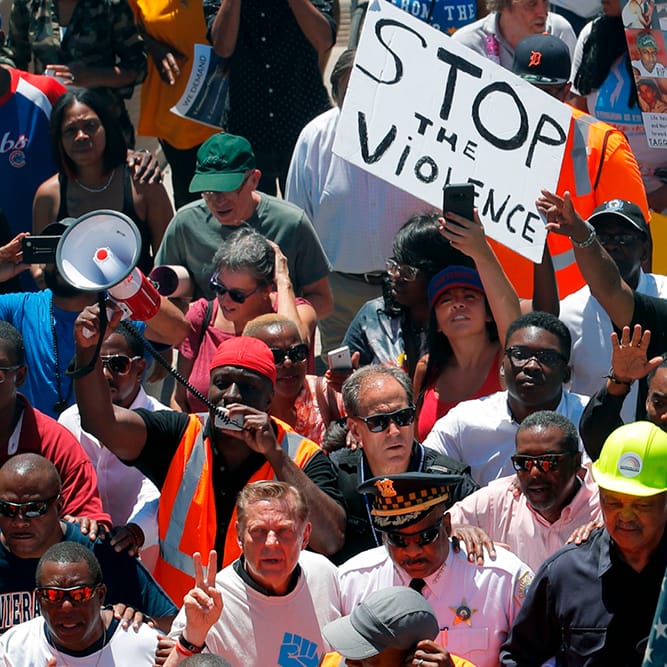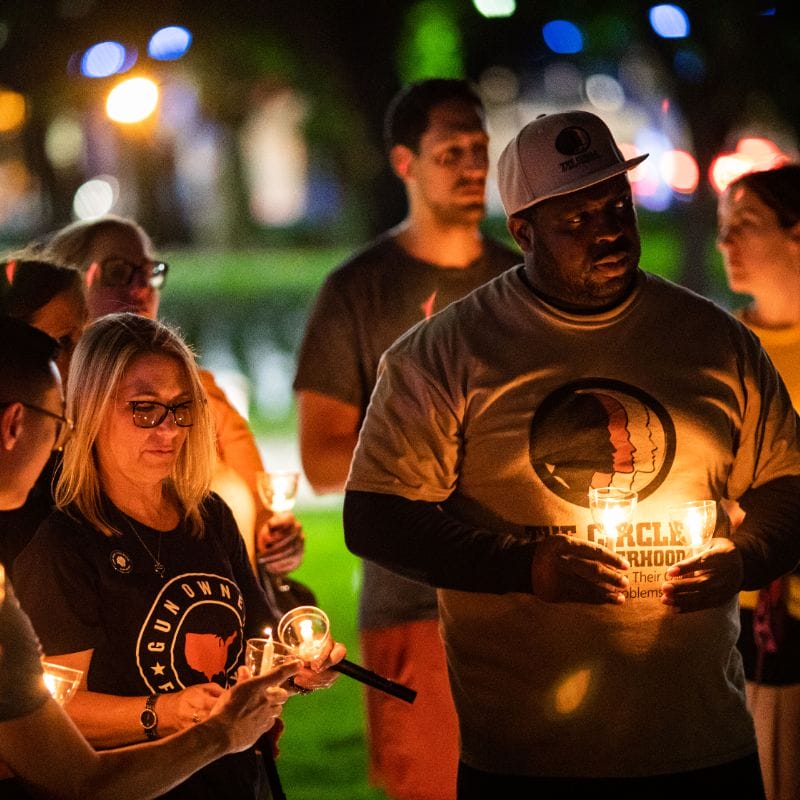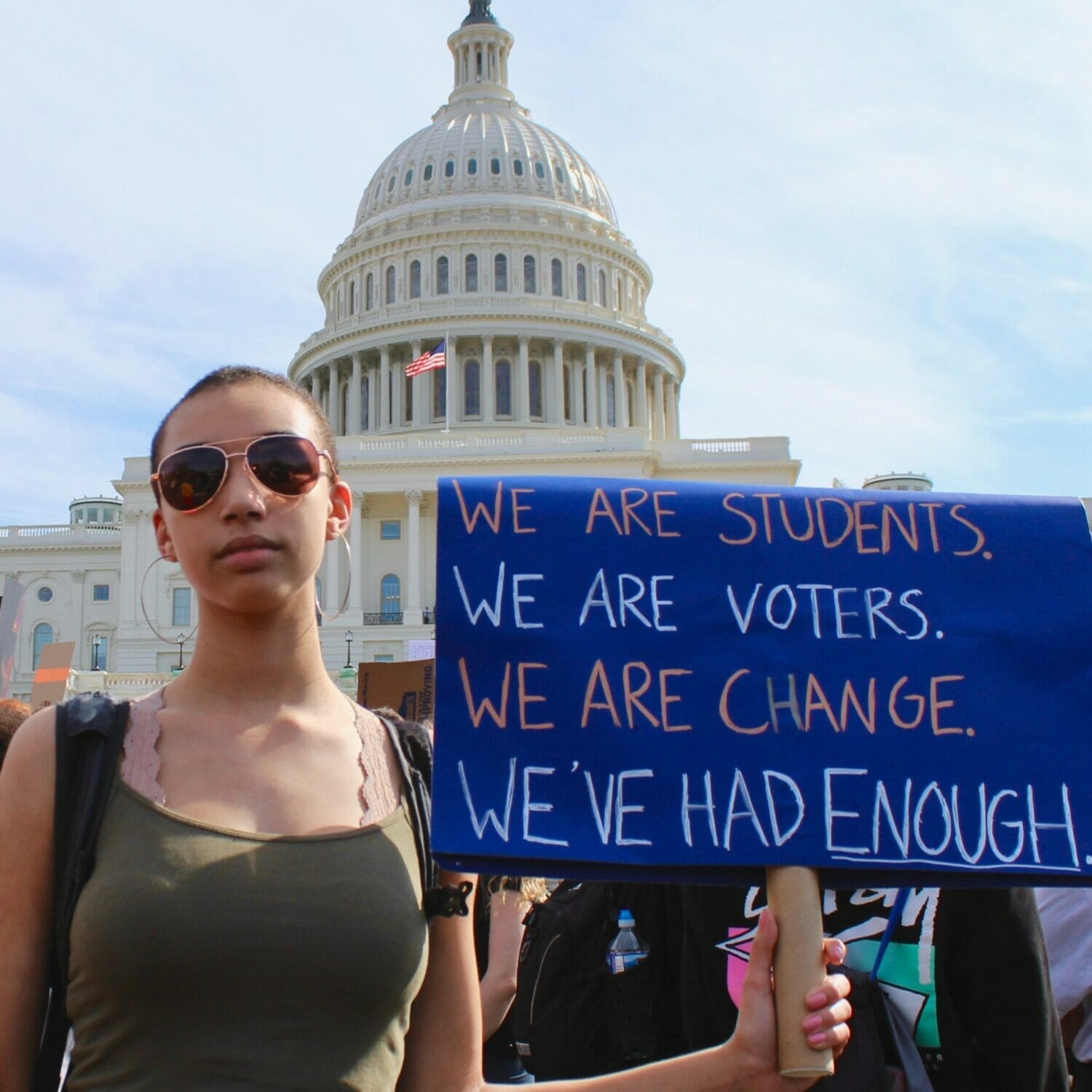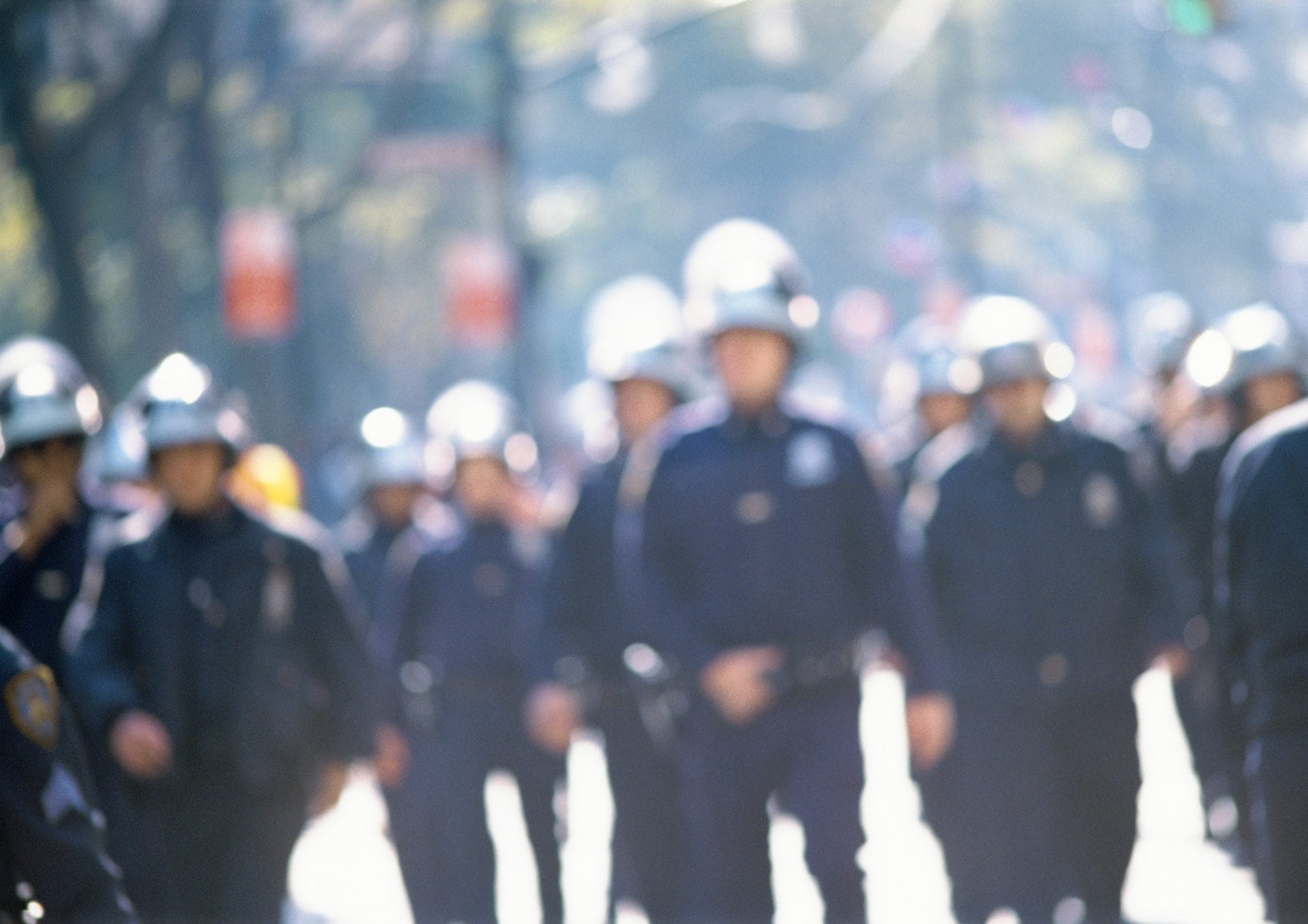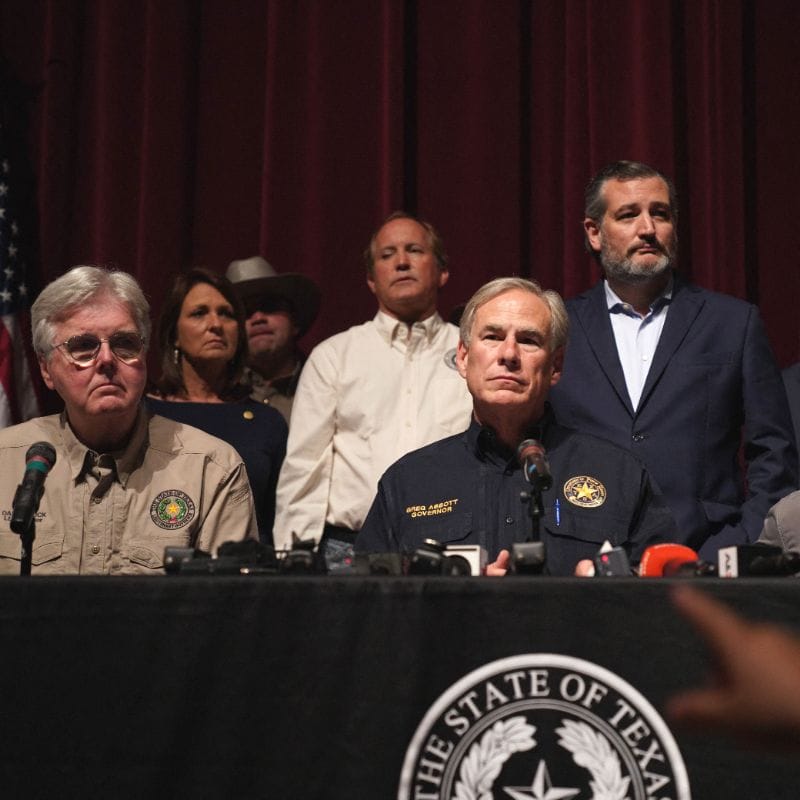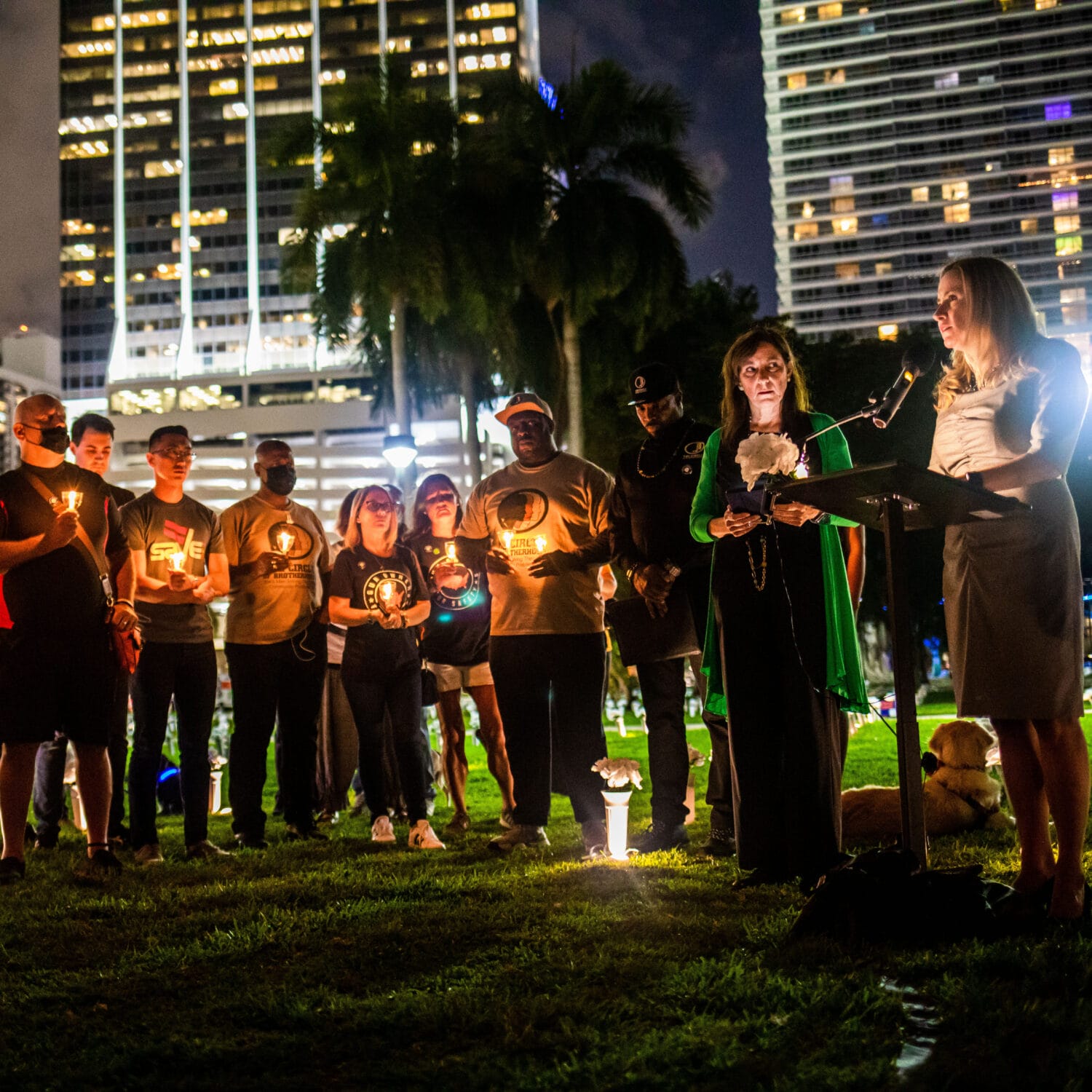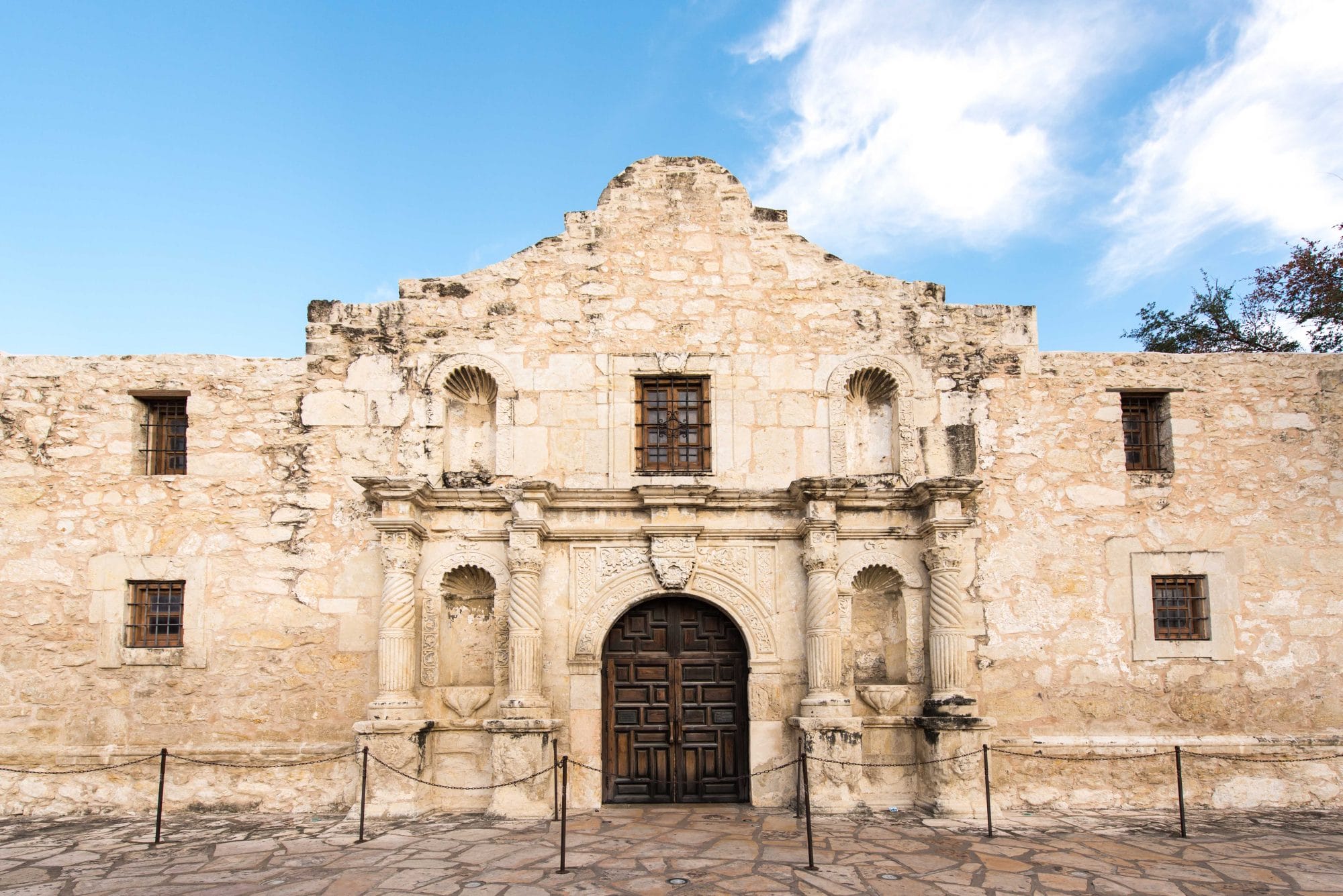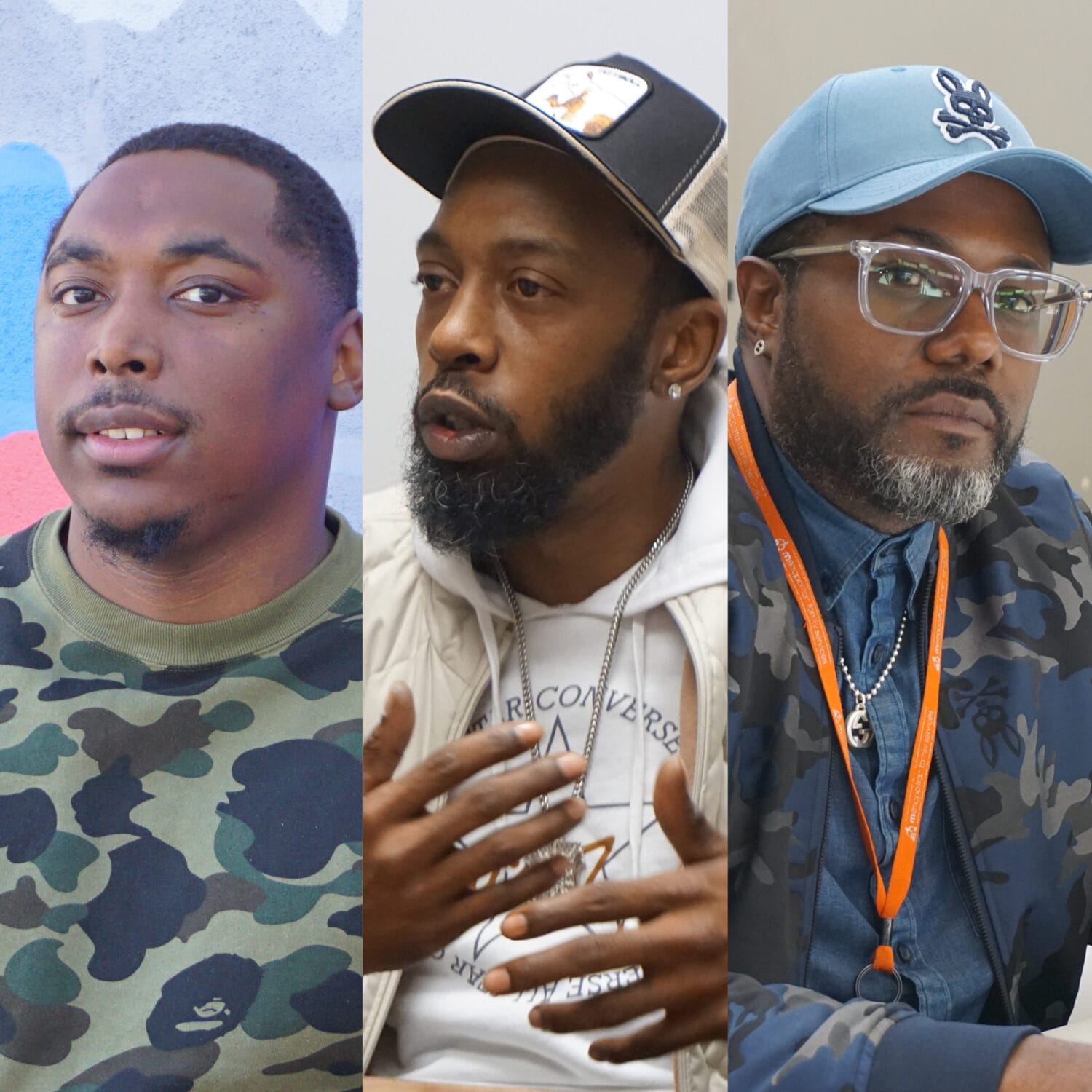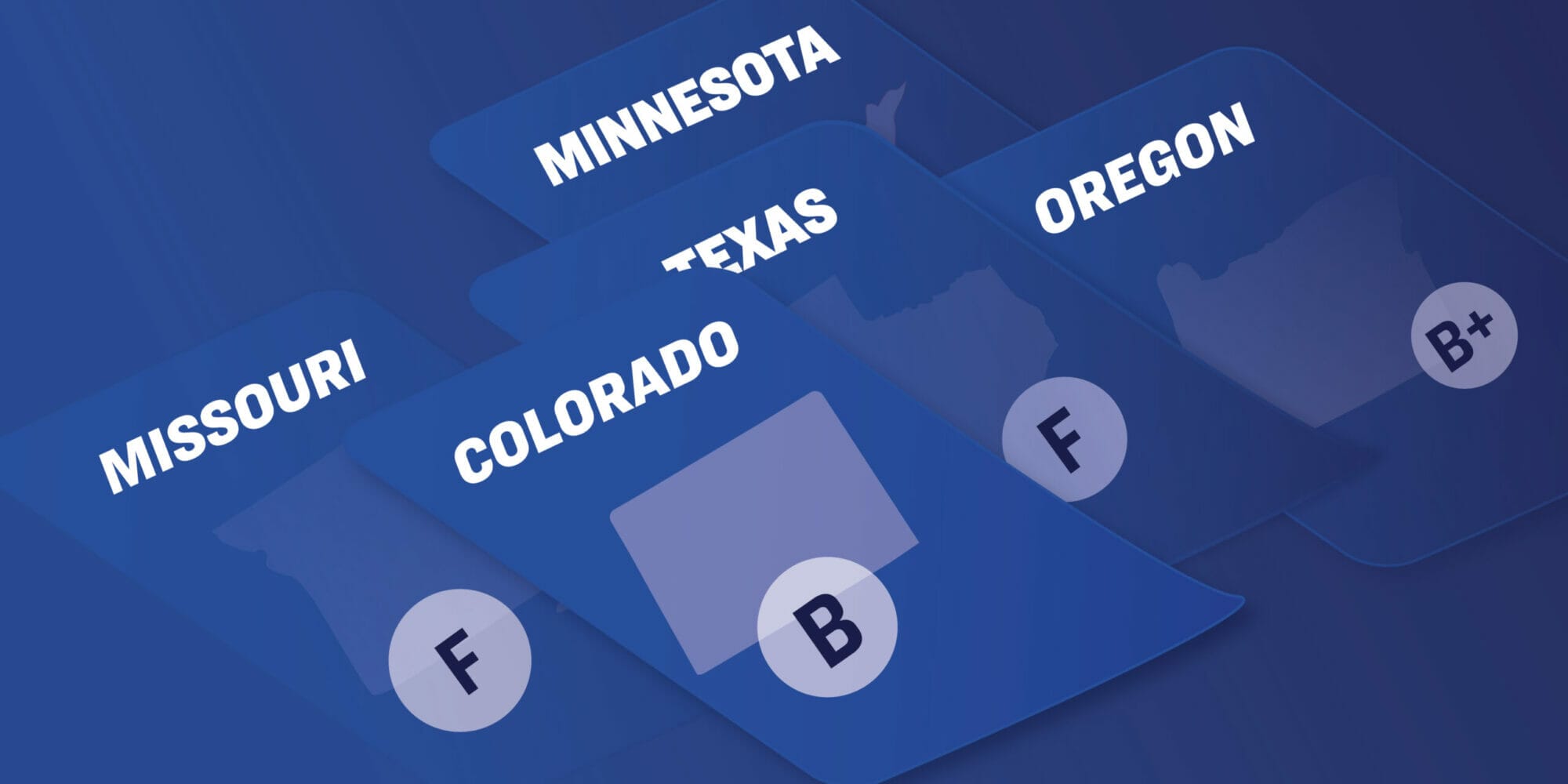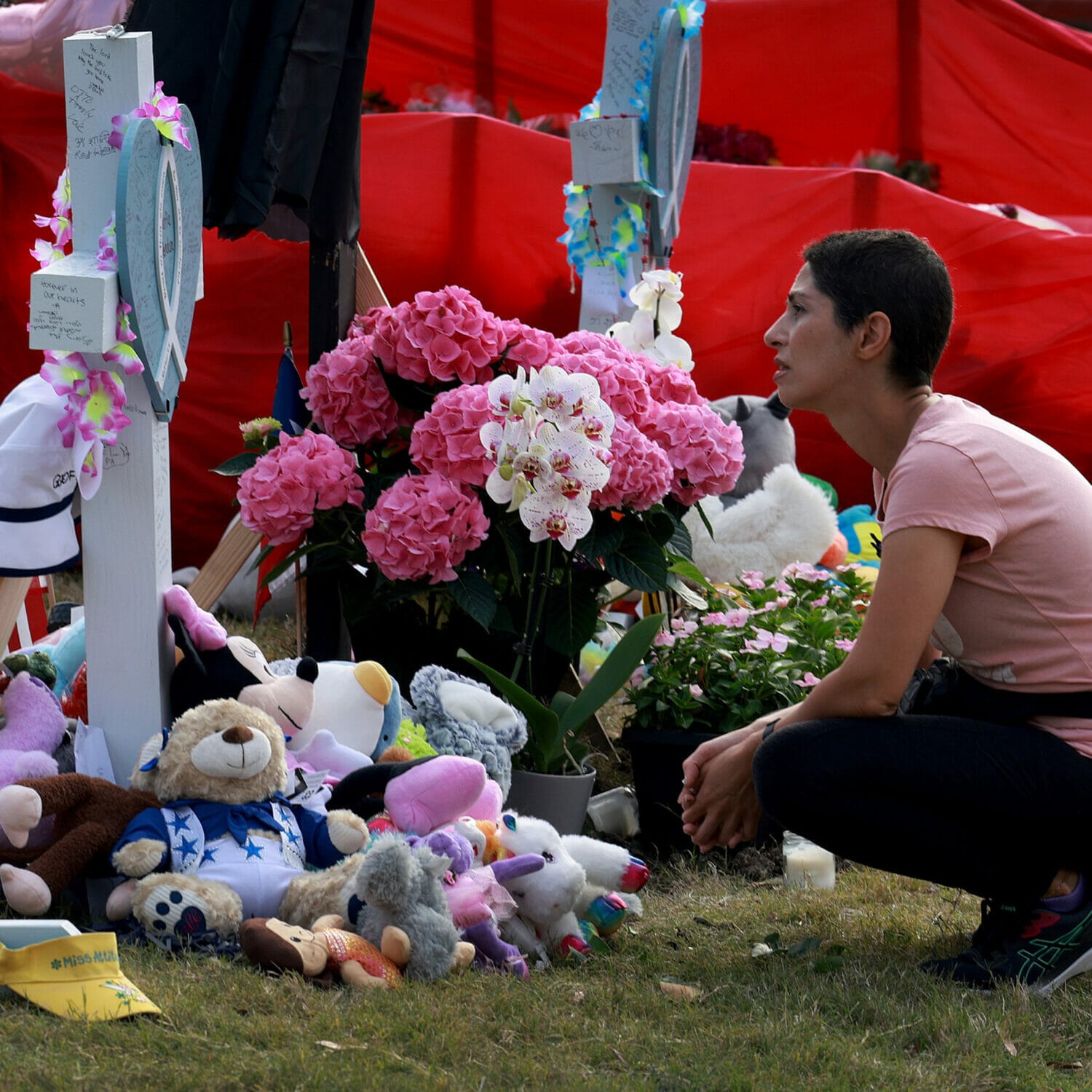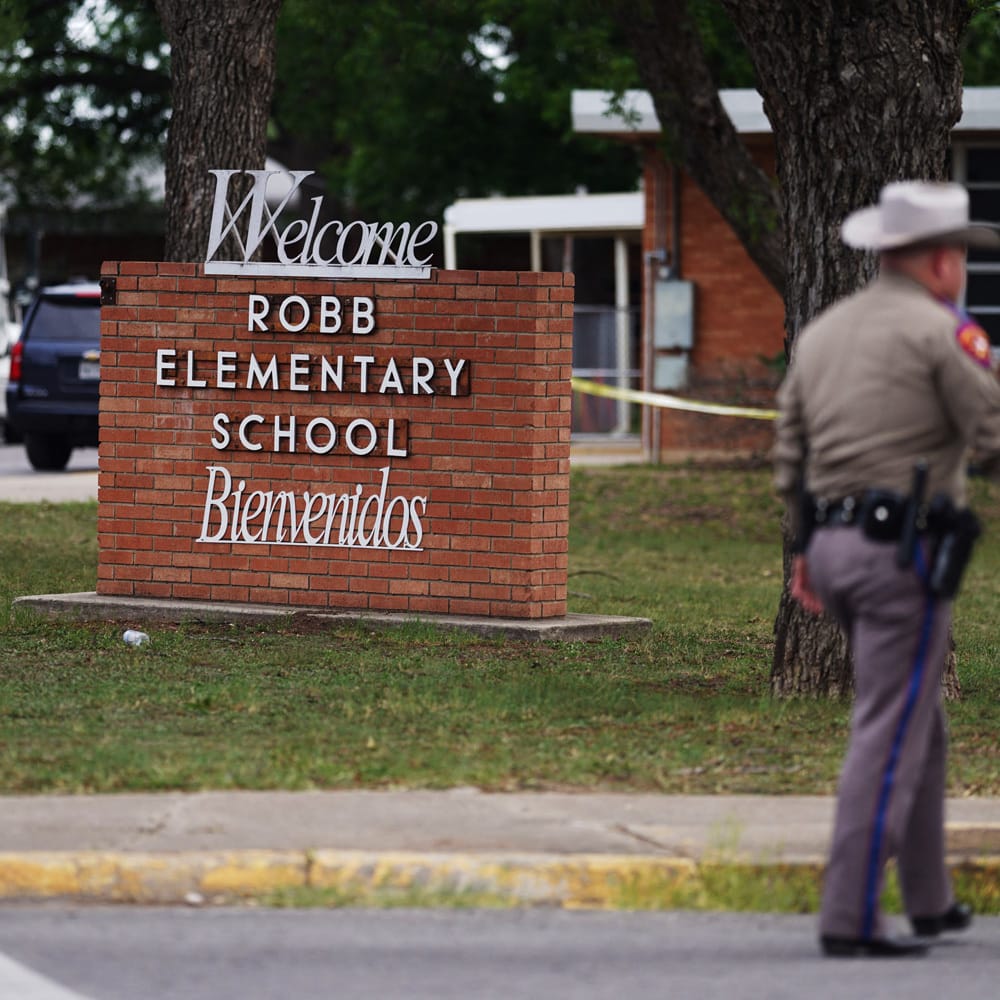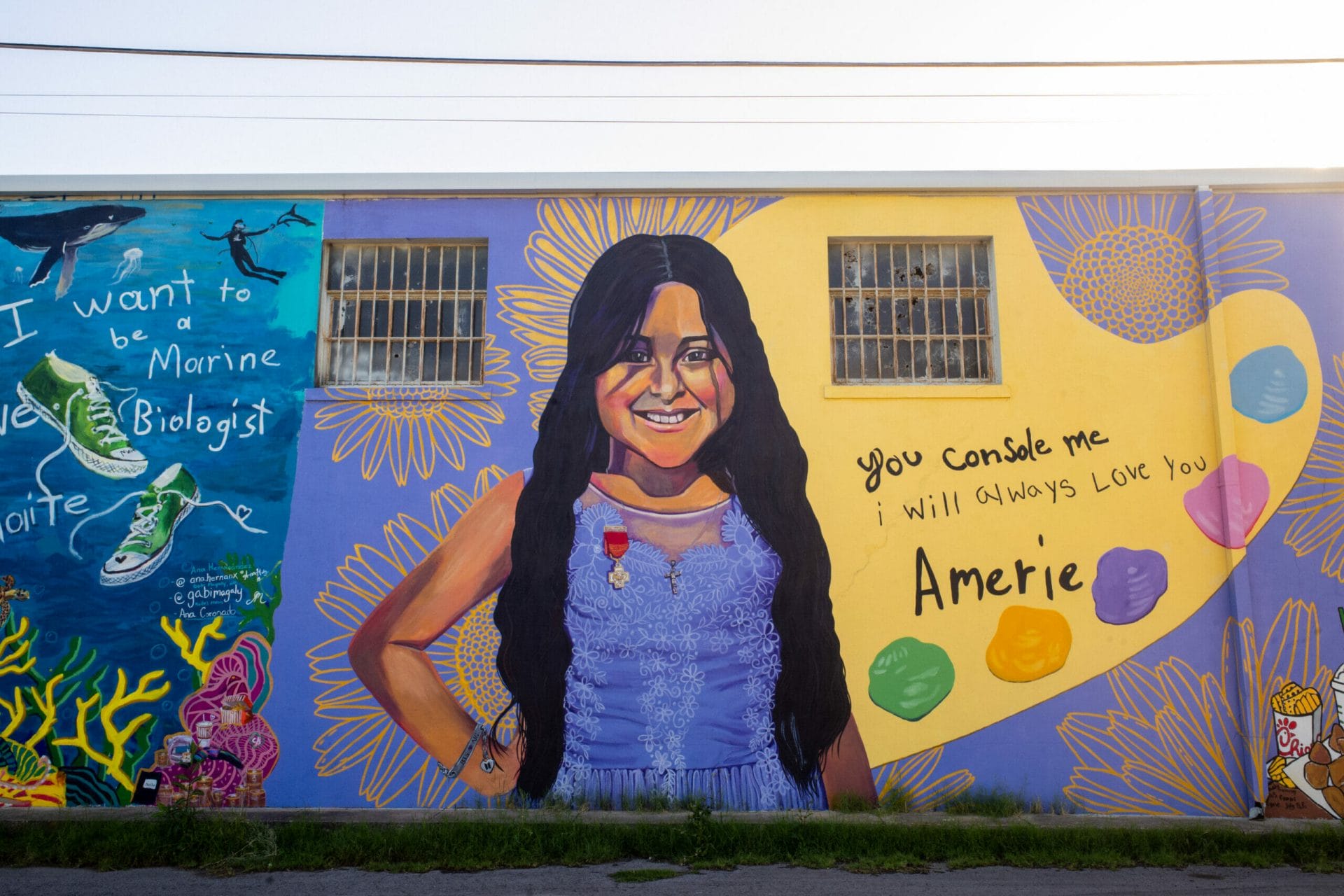
The Uvalde Report
A Path Forward for a Community—and Nation—Struggling to Heal
On May 24, 2022, an 18-year-old former student of Robb Elementary School in Uvalde, Texas, shot his grandmother in the face during a dispute in her home over a cell phone bill. He then stole her Ford F-150 and drove it to the Robb Elementary campus, where he crashed into a ditch before climbing a fence and eventually making his way into a series of connected classrooms. He was armed with a single semiautomatic AR-15 rifle and seven large-capacity ammunition magazines, all of which he legally bought only days before.1
The Uvalde Report: Executive Summary
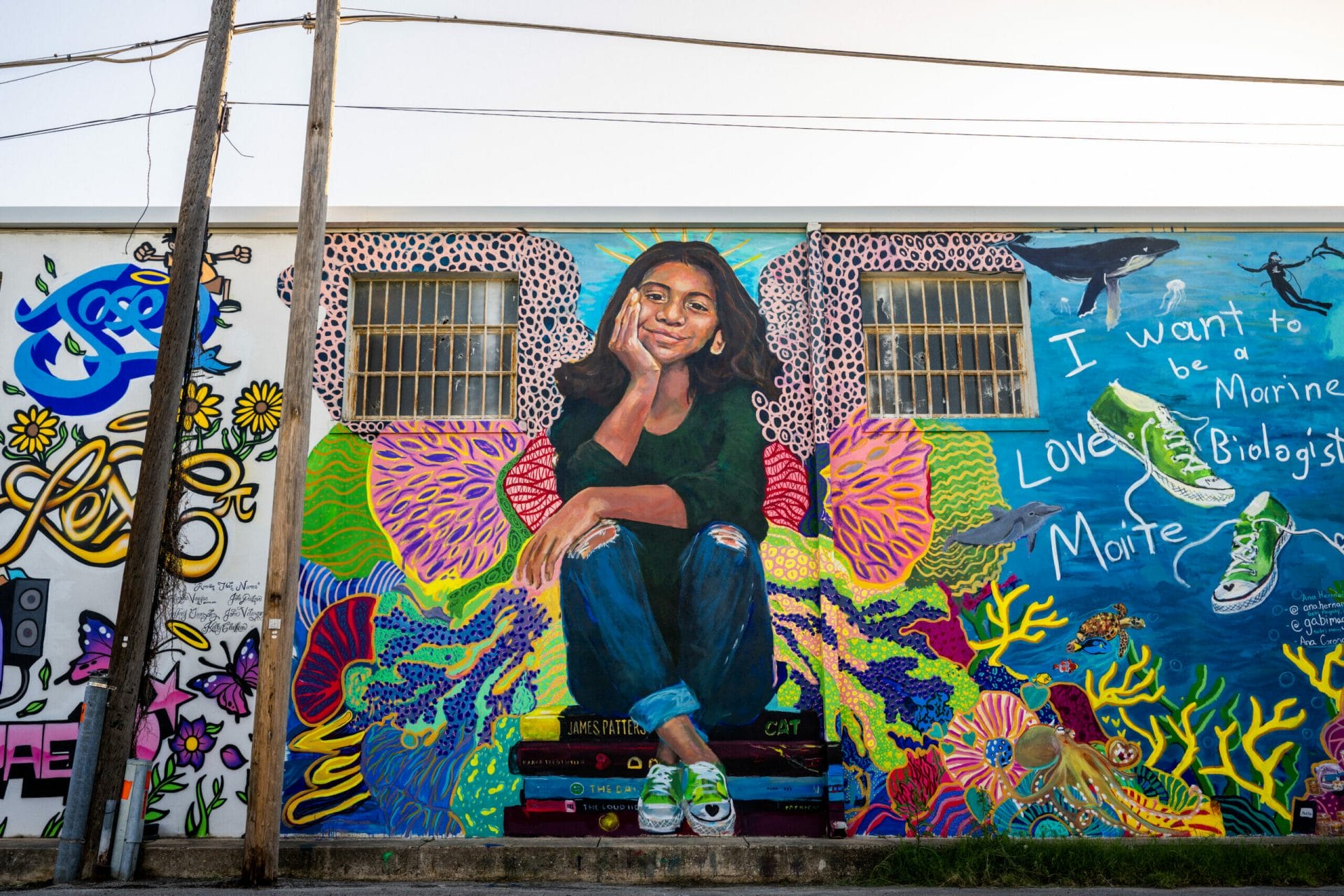
Despite recent investments in school security—made in response to another devastating mass shooting at a high school in Santa Fe, Texas2—and the presence of an armed school resource officer, the shooter was able to enter classrooms 111 and 112, where for 77 minutes, he deliberately executed 19 children and two teachers, in addition to injuring 17 others, before being shot to death by members of the United States Border Patrol Tactical Unit.
Local police who first responded to the scene initially approached the classroom, but then moved back after coming under fire from the gunman. Instead of engaging, dozens of law enforcement officers formed a perimeter and physically detained parents from making an effort to reach their children, who were heard yelling outside for help from within their classrooms. While awaiting a law enforcement intervention for more than an hour, the terrified students took extraordinary measures to survive.
It’s not within the scope of this report to recount all of the horrific details of this tragic day, which are available in many other public accounts. What matters most is that 21 precious lives were taken and countless members of the Uvalde community will be forever impacted, with physical and psychological wounds that will take years and decades to heal.
This report is not about assigning blame, although we agree with a report by the Texas House of Representatives Investigative Committee that calls out the many “systemic failures and egregious poor decision making” by many different agencies and government systems that contributed to this needless loss of life.3Instead, this report is intended to identify the ongoing needs of Uvalde residents in the wake of this unthinkable act and to offer concrete ways that different systems—but especially the local, state, and federal governments—can help to better facilitate the healing of this community and to prevent other such tragedies from happening in the future.
Because gun violence is such a common fixture in American life, this report is also intended to benefit communities around the country that are responding to the widespread trauma of both mass casualty shootings and the constant drumbeat of day-to-day violence on our city streets that may be of less interest to the media but is no less damaging to entire neighborhoods.
MEDIA REQUESTS
Our experts can speak to the full spectrum of gun violence prevention issues. Have a question? Email us at media@giffords.org.
Contact
Uvalde is a microcosm of the United States, and the tragedy at Robb Elementary has laid bare divisions that have existed for decades based on race, gender, and socioeconomic status. In order to heal and move on, Uvalde—much like our entire nation—requires a government response that is trauma-informed, built on accountability, and designed to unify the community around its common humanity and shared suffering.
To its credit, Congress responded to the tragedy in Uvalde with the first major legislative action on gun safety in decades by passing the Bipartisan Safer Communities Act (BSCA) in June 2022, which President Biden quickly signed into law. This lifesaving federal legislation strengthened background checks for purchasers under 21, allocated significant funding for community violence intervention programs, incentivized states to establish and implement extreme risk laws, and addressed the intimate partner loophole as well as the scourge of gun trafficking.
Other politically conservative states, including Florida, have come together in recent years to enact policies to address senseless gun violence—but one whole year after the tragedy at Robb Elementary School, Texas has failed to take action. Officials continue to offer thoughts and prayers following the unending cycle of gun violence–related tragedies—most recently following the shooting at an outlet mall in Allen, Texas, and in a neighborhood in Cleveland, Texas, both incidents involving AR-15 style rifles and killing young children—but no significant gun safety legislation has passed in the state. In fact, the only major movement has been in the opposite direction, with the Texas legislature passing and Governor Greg Abbott signing a law in 2021 allowing people to carry loaded and concealed handguns in public without a permit.4
GIFFORDS: Texas Republicans Betray Uvalde Families
May 10, 2023
As this report will discuss, even if Texas leaders don’t have the courage to act directly on guns, there are a number of other policy areas that require urgent attention, including reforms to the state’s victim compensation program as well as dramatically increased investments in the mental health system and community violence intervention programs, that will help save lives from gun violence and heal communities that have already been impacted.
An unwillingness to address guns directly is not a valid excuse for inaction on this issue.
One year after 21 lives were needlessly taken, many survivors, their families, and members of the community are still attempting to rebuild. But there remain numerous ways in which the needs of the Uvalde community are not being met. We hope this report will help bring those needs to the forefront of our leaders’ attention and spur more effective action to help meet them—in Uvalde and beyond.
The lives that were lost on this day can never be replaced. But we can honor them with action, by fighting for the kinds of deep, systemic changes that will bring healing, protect others, and ensure that these young lives were not lost in vain.
America will never forget them, and we dedicate this report to their memory:
Nevaeh Alyssa Bravo, 10; Jacklyn Jaylen Cazares, 9; Makenna Lee Elrod, 10; Jose Manuel Flores Jr., 10; Eliahna Amyah Garcia, 9; Uziyah Sergio Garcia, 10; Amerie Jo Garza, 10; Xavier James Lopez, 10; Jayce Carmelo Luevanos, 10; Tess Marie Mata, 10; Maranda Gail Mathis, 11; Alithia Haven Ramirez, 10; Annabell Guadalupe Rodriguez, 10; Maite Yuleana Rodriguez, 10; Alexandria Aniyah Rubio, 10; Layla Marie Salazar, 11; Jailah Nicole Silguero, 10; Eliahna Cruz Torres, 10; Rojelio Fernandez Torres, 10; Irma Linda Garcia, 48; Eva Mireles, 44.
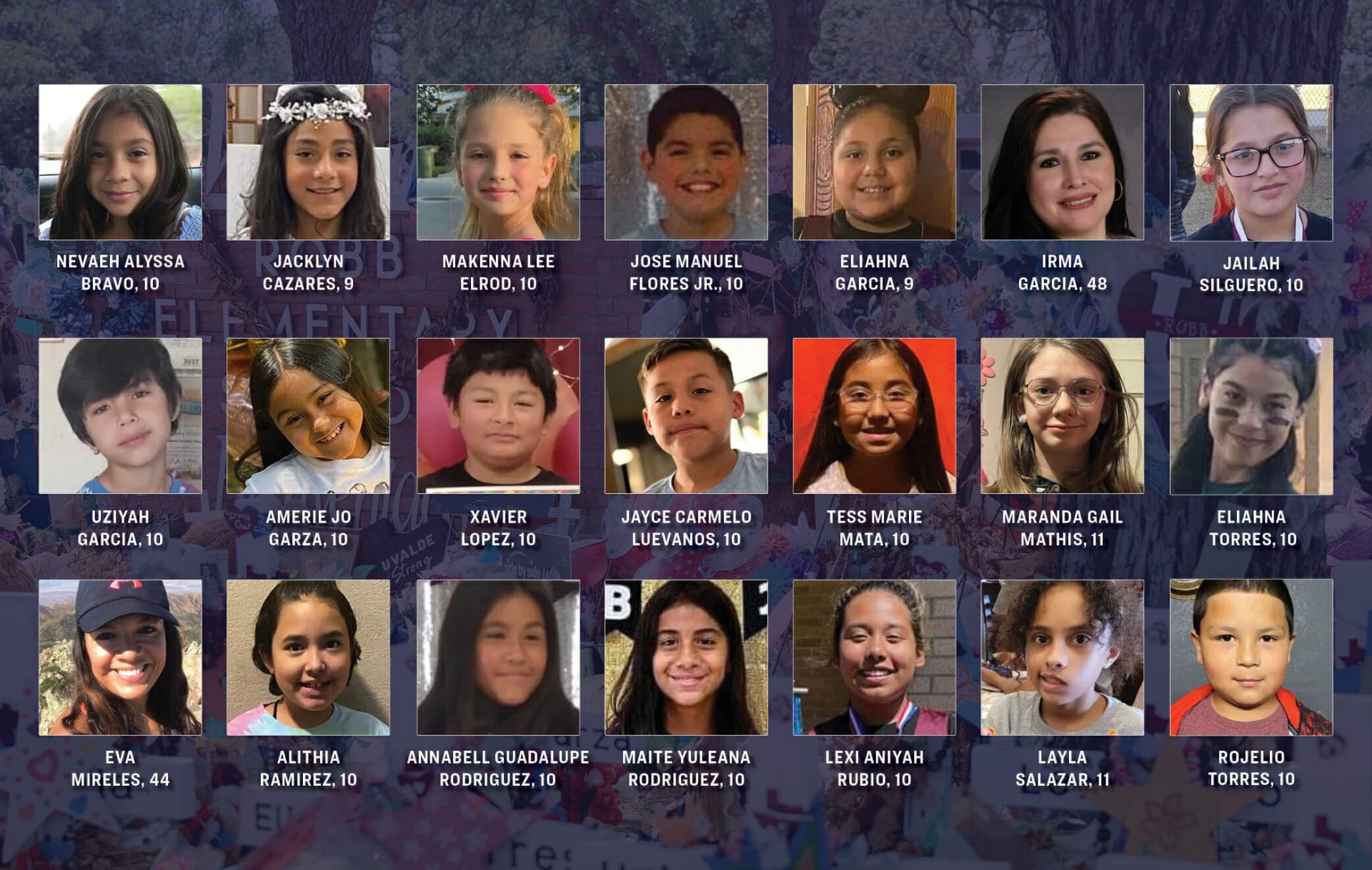
Project Overview
Like all Americans, we were shocked and saddened by the news of the shooting in Uvalde. Within days, Paul Carrillo, vice president of the GIFFORDS Center for Violence Intervention, was on the ground in Uvalde meeting with victims, family members, and city leaders to find out what kind of support the community might need in the wake of unimaginable tragedy. In the ensuing weeks, residents expressed numerous frustrations and a desire to have their voices heard in the midst of a tumultuous process that often left them feeling overwhelmed and, at times, unheard and unseen—particularly by various government actors.
As a result of those conversations, we launched this project as part of our ongoing commitment to save lives from gun violence and provide comprehensive support to communities impacted by this uniquely American epidemic. The primary goal of this project is to understand the ongoing needs of Uvalde community members—with an emphasis on direct survivors and their families—and to identify the resources, services, and other types of support necessary to help them recover. In a nation where mass shootings are on the rise,5 this report is also meant to help inform a more effective and trauma-informed response to senseless acts of violence in other American communities.
A secondary goal of this report is to identify policy reforms that may help to both avoid future tragedies and improve services and support for victims not only of mass violence, but also the far more common instances of day-to-day community violence.
El Informe Uvalde: Resumen Ejecutivo

Our team for this project includes individuals from multiple organizations with specializations in mental health, trauma, crisis response, government policy, and social services. One of our team members is originally from Uvalde and still has many family members there.
Before visiting Uvalde for multiple on-the-ground visits, the team identified stakeholders such as family members and key community leaders who were impacted directly or indirectly by the shooting at Robb Elementary School. We developed a sampling matrix to capture diverse perspectives and a semi-structured, trauma-informed interview guide to ensure consistency in the questions asked of each individual.
Our team conducted both one-on-one and focus group–style meetings in English and Spanish at emotionally safe and confidential locations in the town. To help ensure the well-being of our team members, we contracted with a mental health professional, Dr. Tonya Wood, Ph.D.,6 to assist our team with processing and self-care practices. In total, we spoke directly with dozens of members of the Uvalde community and reviewed hundreds of documents, articles, and government reports.
While no community is a monolith, this report is designed to identify the common themes that arose across different stakeholders. Our team will continue to share the findings from this project with Uvalde residents to ensure accuracy and to center the survivors’ voices and needs.
To the residents of Uvalde, we are incredibly grateful to you for welcoming us into your community during an incredibly challenging time and for sharing your experiences and grief with our team. We grieve alongside you, and sincerely hope this report will be a useful resource to support you in your ongoing journey of healing.
The Uvalde Community
Uvalde is a rural city of approximately 15,000 residents, located in southwest Texas about 80 miles west of San Antonio. With nearly 80% of the population identifying as Latino or Hispanic, Uvalde is a proud community with a rich history, and is part of a larger region that consists of 32 counties running from Llano County to a 200-mile stretch of the Texas/Mexico border between Del Rio and Laredo. This is a region with a lower population density and a much higher rate of poverty than the statewide average, with 60% of Uvalde County’s children and youth living in poverty, compared to the statewide average of 40%.7

As a tight-knit community where everyone knows each other, Uvalde is also a community that has experienced many divisions along socioeconomic and racial lines that have persisted since the city’s founding in the 1850s. Many older residents described their struggles to gain economic opportunities—from business loans to job opportunities—in the face of blatant discrimination based on their race. This historical racism was exemplified by a student-led school walkout in 1970 in protest of rampant racism in the Uvalde educational system.8 It is a system that has long been segregated, with Hispanic students attending Robb while most white students attended Dalton Elementary School.9
The leadership of the city, which is more than 80% Latino, remains mostly white. “At the center of town on the courthouse grounds, you’ll find a monument to Jefferson Davis, the Confederate president—installed when the Ku Klux Klan dominated Uvalde politics,” wrote one former resident.10
We discuss race and racism in this report not to point fingers or cast judgment, but because grappling with these issues will be critical to the community’s ability to heal and move forward in unity from the tragic events of May 24, 2022.
It’s also important to note that Uvalde is a city with a tremendous amount of resilience and assets. In interviews, community members identified numerous strengths of Uvalde residents, including good people, strong faith, hope, and grit. “This shooting has opened our eyes,” said one resident. “There’s a tremendous opportunity for positive change if we can come together.”11
Finding ways to overcome divisions—especially those connected to race, economics, and politics12—will be key to moving forward as Uvalde marks the one-year memorial of this devastating shooting.
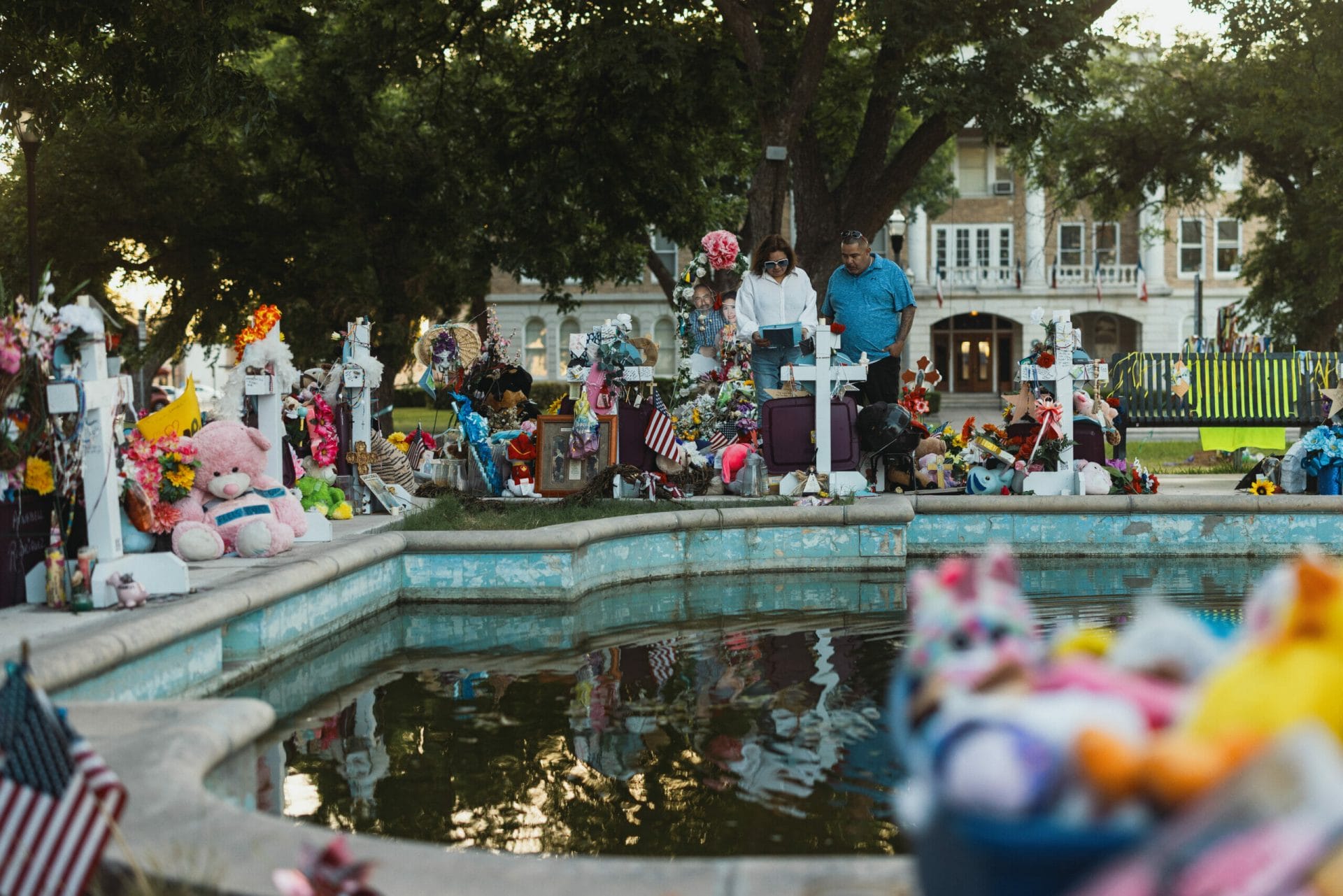
A Trauma-Informed Approach to Gun Violence
Trauma generally results from a distressing event that causes life-threatening physical and/or emotional harm that can impact one’s mental, physical, emotional, social, and spiritual health.13 As one mental health organization aptly summarizes, “Experiencing a traumatic event can harm a person’s sense of safety, sense of self, and ability to regulate emotions and navigate relationships. Long after the traumatic event occurs, people with trauma can often feel shame, helplessness, powerlessness, and intense fear.”14
Trauma can also be experienced at multiple levels: individually, through interpersonal relationships (e.g., adverse childhood events), and collectively (e.g., racism, discrimination). Often, collective trauma contributes to the exposure of trauma at the individual and interpersonal level.
Gun violence is an increasingly common source of trauma in the United States and one that leaves lasting effects within entire communities.15 This is why a trauma-informed approach is necessary to facilitate community healing and inform our collective response to gun violence.
The Substance Abuse and Mental Health Services Administration (SAMHSA) has identified six trauma-informed principles as a best practice framework to support survivors of trauma. These practices emphasize a trauma survivor’s healing by creating strong, stable, and supportive relationships to build resilience and reduce their mental health symptoms.16 This approach also actively seeks to prevent practices that can retraumatize the survivors. This report will incorporate this framework and identify how effectively these six trauma-informed principles have been incorporated in Uvalde:17
- Safety
- Trustworthiness and Transparency
- Peer Support
- Collaboration and Mutuality
- Empowerment and Choice
- Cultural, Historical, and Gender Issues
These principles will be referenced throughout this report to highlight the strengths and gaps in response to the Uvalde shooting.
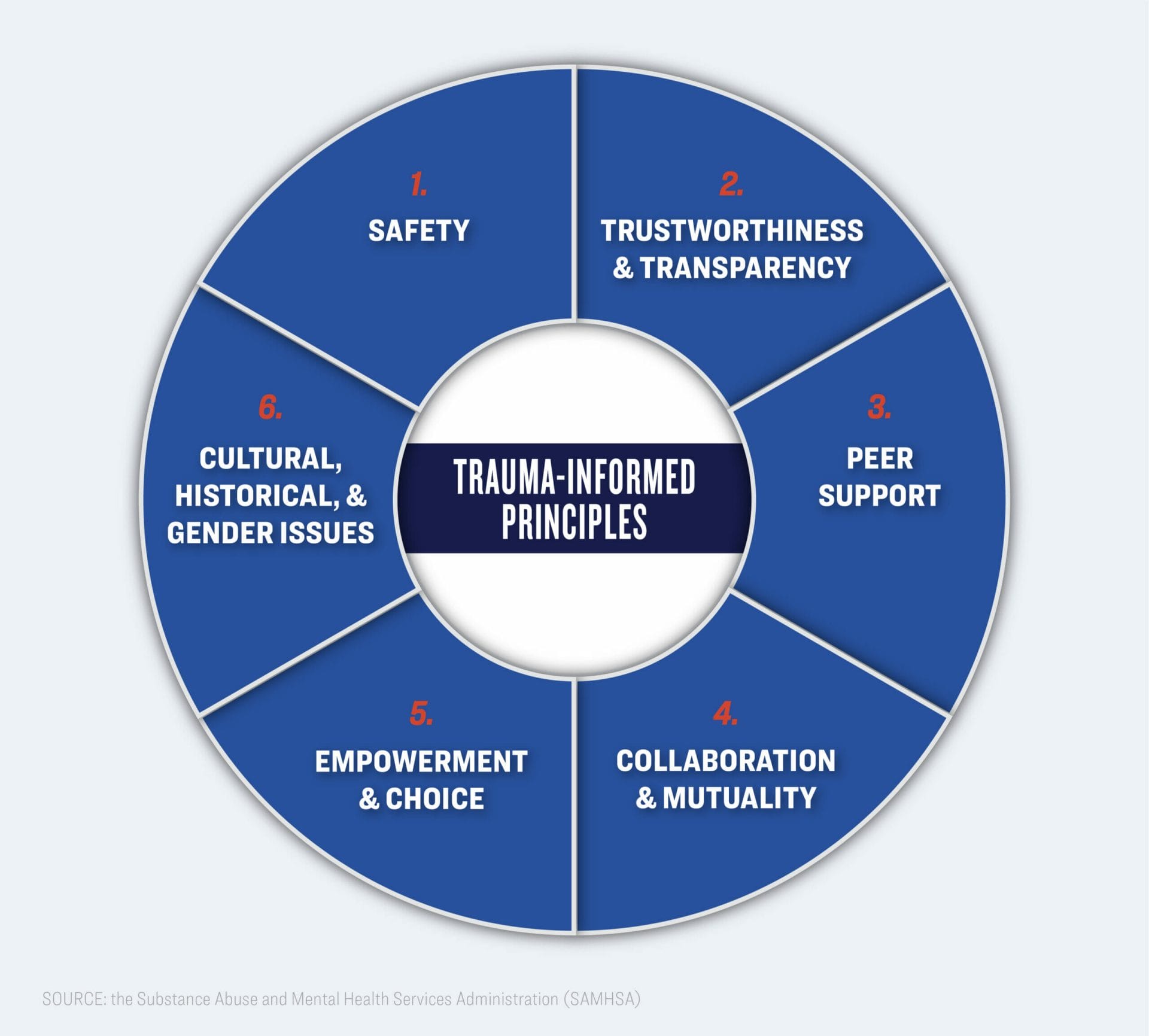
The tragic events of May 24 will impact community members in Uvalde for many years to come. The scientific literature is clear that mass shootings increase rates of mental health issues, raise the risk of suicide—especially among youth and young adults—and reduce the overall sense of community identity, safety, and well-being.18 Mass shootings also impact community members differently based on their proximity to the shooting—for example, a survivor that was in the classroom may have a different response compared to a student that was not in the classroom but heard the gunshots. These impacts are not just experienced in the days, weeks, and months immediately following a mass casualty event, but ripple through the community for years.
Months after the shooting at Robb, interviews with Uvalde family members confirmed this. Families reported that children had high levels of anxiety and stress—difficulty sleeping at night was a commonly reported symptom—and dramatically altered behaviors. “My daughter cries every time she hears a siren now,” reported one mother. “She used to be open, but now she’s totally withdrawn and just not herself since this happened.” Another parent stated, “My child survived, but she is not the same.”19
An additional common consequence of mass shootings is that they tend to lay bare pre-existing community divisions—and Uvalde is no exception. Despite the ubiquitous signs saying “Uvalde Strong,” many residents interviewed for this report expressed concerns that the Robb tragedy had further exacerbated divisions that already existed along racial, economic, and political lines. “The pain runs deep in Uvalde,” said one resident.20 “We’re talking about decades of pain, racism, and separation—this is not just about May 24, this is a catalyst.”
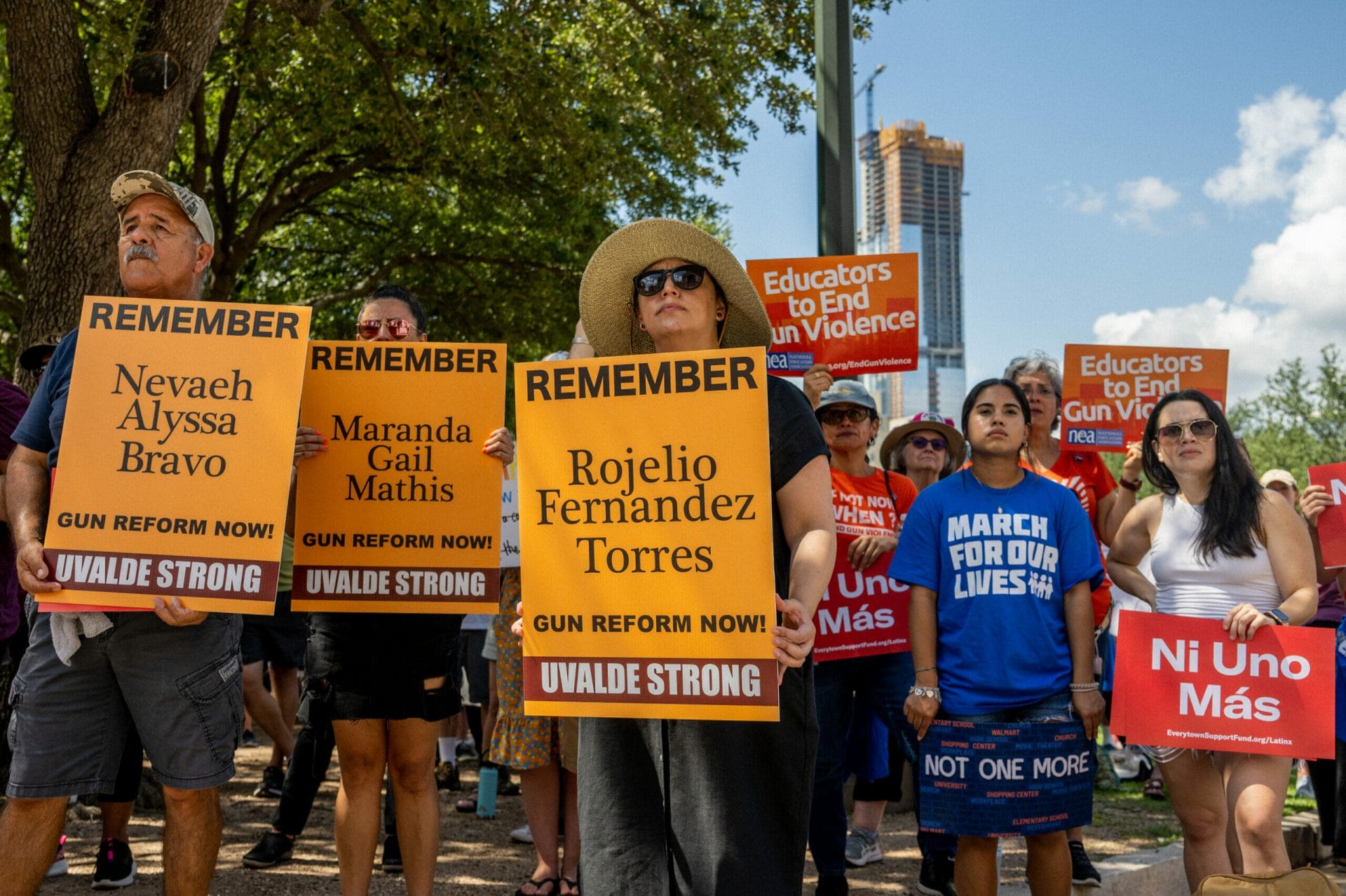
A focus group of Uvalde residents identified some of the most common feelings that are continuing to arise in the community as the one-year memorial of the shooting approaches, which include anger, sadness, grief, resentment, mistrust, numbness, exhaustion, fear, and a sense of lost identity. Those directly impacted have struggled to receive consistent and quality mental health services. As a range of responses to the shooting continue to emerge from community members, it will be critically important for the people of Uvalde to have access to stable, consistent, long-term mental health services.
“We don’t just want to put a Band-Aid over it and leave,” said pediatric psychologist Jeffrey Shahidullah, Ph.D., who is an assistant professor at the University of Texas at Austin’s Dell Medical School, and who helped staff a walk-in clinic for Uvalde residents seeking on-demand mental health support in the days and weeks immediately following the shooting.21 “We need to create a trauma-informed community, because the situation doesn’t end once the traumatic event is over.”
This is backed up by studies showing that, over time, mass casualty shootings can influence the manifestation of psychological disorders such as depression, anxiety, and PTSD, as well as somatic and medical conditions.22 For example, in the first year following a disaster, PTSD prevalence ranged between 30–40% in direct victims, 10–20% in first responders, and 5–10% in community members. Additionally, mass shootings increase symptoms of PTSD, depression, and anxiety of survivors in relation to the degree of physical distance and social proximity to the shooting.23
Our inventory of the needs of the Uvalde community begins not with what’s missing, but with the assets that are already in place. Uvalde is a community that has many strengths that have reinforced its residents’ capacity for resilience. These strengths provide the foundation to improve the well-being of everyone in Uvalde, and to bring healing to those who have been impacted by this tragedy.
Many survivors and their families referenced the strong social connections throughout the community as important for their healing journeys. Social connection refers to how community members relate with each other, and it is associated with increased health-related protective factors.24 Social connections are common in rural communities and are often formed through close family ties, long connections to the community, and similar faith-based communities.25
In Uvalde, a few people we spoke with mentioned how, despite fractures in the community that occurred post-shooting, community members have found ways to lean on each other for support. One interviewee mentioned that “Uvalde has the ability to come together when needed the most, despite our pain and differences.”26
Several of the surviving students’ parents mentioned how they have formed a community of support by sharing information and providing emotional support to each other. They spoke about how many of them are in the same text group, and when one person receives information they make sure to share this information with the other parents. They also discussed how their children will often spend time together and “when [the parents] are alone they will talk about [the shooting] with each other.”27
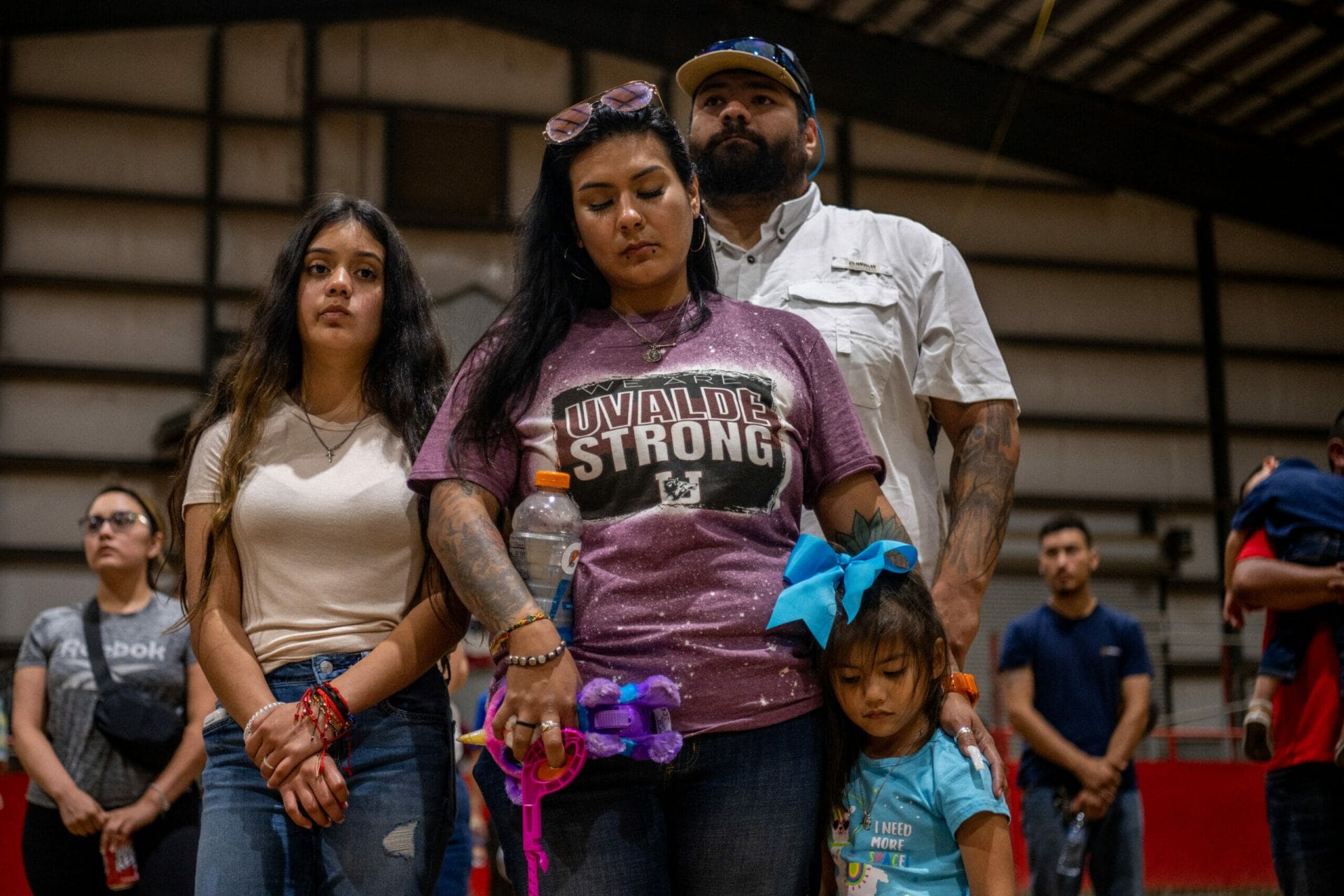
Additionally, a local mental health provider indicated that he is offering a grief support group to community members as an opportunity for survivors to connect. He mentioned that this group does not require participants to complete any documentation or even provide identifying information to minimize barriers to accessing support. This type of peer support is a necessary part of recovery after experiencing a traumatic event28—when survivors have access to peer support, it not only facilitates their sense of safety but also their sense of empowerment. All three of these principles are included within the trauma-informed framework discussed above, and when trauma survivors have access to these resources they experience safe and supportive environments to facilitate their healing. Therefore, these relationships are essential in facilitating healing for the families in Uvalde.
Community members in Uvalde are also connected to social support through formal institutions, such as their churches, to enhance their resilience. In Uvalde, many supportive resources have been facilitated through faith-based institutions, and several people interviewed indicated that faith and prayer have been helpful in their recovery. Connection to spirituality is associated with a decrease in trauma-related symptoms and overall psychological well-being,29 and soon after the shooting, many faith-based communities showed up in Uvalde and offered prayer and other forms of tangible support (e.g., resources, activities, etc.) for residents.30
When parents that have lost a child experience family and community support, they have increased rates of resilience post-trauma31 and a reduction in trauma-related symptoms.32 Local informal support systems also provide a significant bridge of resources for families impacted by the shooting. Reverend Mike Marsh from St Philip’s Episcopal Church noted that the church received packages “every day” with donations for the families affected by the shooting.33 Others we spoke with reported how their faith community has been essential in providing spiritual and financial support to assist with burial costs.34
Faith-based institutions are trusted in Uvalde, and they have been important locations to integrate other supportive services. One person we spoke with mentioned that the Bereavement Center in Uvalde has made a 10-year commitment to provide mental health services in the community. Reverend Marsh mentioned that his church has an ongoing collaboration with the Bereavement Center, including a dedicated “therapy space” for a therapist to meet with children at the church’s school.
Within a trauma-informed framework, faith-based institutions also provide a sense of safety, peer support, and cultural congruence that facilitate healing. Therefore, the collaboration between the faith-based community can reduce stigma and provide an opportunity to introduce mental health services and increase accessibility to these services.35 This type of long-term commitment can facilitate trust between the community and community providers and is also consistent with the trauma-informed principles of safety, trustworthiness, and transparency.
Advocacy Efforts
Immediately after the shooting, families engaged in activism to change the conditions in Uvalde and hold institutions accountable. One parent without any prior political aspirations ran for county commissioner to promote change within Uvalde.36 For some trauma survivors, engaging in advocacy is directly connected to healing from their trauma and creating change that makes meaning out of their loss.37 One parent mentioned how engaging in advocacy gave them a space to channel their grief and connect with others directly impacted by the shooting. “I stay angry… I go every week to meet with lawmakers… I don’t care if they are with me or against me—our kids deserve better.”38
Empowerment for trauma survivors is consistent with trauma-informed principles for healing because it gives survivors an opportunity to bring awareness to and change the conditions that contributed to their initial exposure to the trauma.39 Currently, many of the surviving parents and youth from Uvalde are advocating at a federal, state, and local level to prevent future incidents of gun violence and hold those in power accountable.40 Advocacy efforts have been connected to recovery for other survivors of gun violence and have contributed to meaningful social change through education and mass mobilization.41
Survivors in Uvalde should know that many resources exist to help channel grief into positive actions for change, including Survivors Empowered, an organization created by Sandy and Lonnie Phillips after they lost their daughter, Jessi Ghawi Redfield, on July 20, 2012, in the Aurora, Colorado, massacre. Survivors Empowered was designed to help provide support to people affected by gun violence, both in its immediate aftermath and long-term.
In 2022, GIFFORDS partnered with Sandy and Lonnie to create From Healing to Action: A Toolkit for Gun Violence Survivors and Allies, a resource we hope will be useful to those in Uvalde who have been impacted by the shooting at Robb. One crucial takeaway from the report is that no survivor is alone.“We have traveled this road with many friends and allies, and we are proud to call Gabby Giffords, and her organization, GIFFORDS, treasured allies and resources,” wrote Sandy and Lonnie.
The shooting at Robb Elementary is just the latest example that brings to light the history of community racial and socioeconomic divisions that can hinder long-term healing in a community. Trauma-informed principles highlight the importance of addressing how history and discrimination play into the impact of their current trauma. Additionally, this creates an opportunity for the community to acknowledge its strengths while also addressing the underlying conditions that have contributed to community harm.42 This form of community healing also includes tangible opportunities for community members, specifically youth, to advocate for and gain the influence to implement the changes needed within their community.43
In Uvalde, youth-led advocacy movements have a history of initiating change in the community.44 Similarly, gun violence prevention movements led by young people, such as March for Our Lives and Students Demand Action, have allowed different communities to add their voice to the fight against gun violence and advocate for change at the state and federal levels. These approaches empower youth as agents of change and acknowledge both the impact of the trauma and the opportunity to envision and impact their futures.45
Nontraditional Healing Approaches
Using nontraditional healing modalities, such as art and animal-assisted therapies, can be an effective way to treat trauma-related symptoms—and the Uvalde community has prioritized this following the Robb Elementary shooting. One interviewee indicated that they believed having access to nontraditional mental health approaches was helpful for her child. She mentioned that her daughter had access to “therapy dogs” soon after the shooting and noted that she believed it was helpful; however, her daughter did not have access to this resource long-term.
This type of emotional support can be effective for trauma survivors,46 but if it is not consistent it can be disruptive.47 Another person we spoke with indicated that she believed that her daughter would benefit from art-based therapies to process her trauma in addition to traditional talk therapy, but she did not know how to connect her daughter to this resource. This form of therapy can be an effective approach in treating child survivors of trauma and even reduce the stigma associated with receiving mental health care.48
In Uvalde, there are also community members seeking healing and community connection through nontraditional therapies.49 These formal and informal communities of healing can provide trauma survivors an opportunity to seek healing in a non-stigmatized way. For example, the Virginia-based HEB Foundation hosted a camp free of charge for survivors from Uvalde.50 Utilizing trained counselors, Camp Healing Day Camp not only provided a safe space for the children but educated parents on common trauma responses, while also integrating art as a way to facilitate healing for young survivors. Additionally, these trauma-informed strategies provide safety and opportunities for peer support for the survivors and their families.
While Uvalde continues to exhibit many strengths in the wake of the tragedy at Robb Elementary School, there are still significant challenges and gaps it faces when it comes to meeting the ongoing needs of the community. This section will highlight the major gaps community members identified that have impacted their ability to heal since the shooting on May 24, 2022.
History of Racism and Socioeconomic Division
Uvalde’s history of racism and socioeconomic divisions has impacted the community and hindered its recovery. Several interviewees directly and indirectly referenced the history of racism and discrimination that has existed in the community, specifically along racial and socioeconomic lines.51 They often noted two specific examples of how racism and discrimination have occurred within Uvalde: 1) A historic (and currently informal) designation of a “white people park” and a “Mexican park”; and 2) The firing of a well-respected Mexican teacher and the subsequent backlash from the community a few decades ago.
In 1970, when the mostly white school board decided not to renew the contract of popular fifth grade teacher Josué “George” Garza at Robb Elementary School, students and parents across the district organized a mass protest, with more than 600 students refusing to attend classes.52 “That was like a climax to a chain of injustices that had been occurring,” Garza said in a 2016 interview.53

The students’ list of demands included hiring more Latino teachers and requiring teachers to be able to correctly pronounce the name of Hispanic students. The walkout, which became one of the longest boycotts of its kind during this period of Chicano activism in America,54 “sparked a class-action discrimination lawsuit against the school district that led to a desegregation order and decades of court-ordered monitoring of the district.”55
Many residents interviewed for this report felt that while conditions have improved since the time of the walkout at Robb Elementary, racism remains a part of their daily lives. “Racism is alive and well here in Uvalde,” said one local faith leader.56 Referencing the example noted above of racial discrimination in Uvalde, he added, “For instance, we still have two parks that are informally separated for use by white families and Hispanic families.”
The history of the struggle for racial justice in Uvalde is not sufficiently taught in the area’s schools. “I grew up not that far from Uvalde,” said Brett Cross, who lost his 10-year-old nephew and adopted son, Uziyah Sergio Garcia, on May 24, “and I had never heard about the walkout in school. There’s no acknowledgment of the systemic racism that’s still here.”57 And despite decades of court monitoring of the education system, “the Uvalde public schools today continue to reflect the vestiges of historical discrimination against children of Mexican descent and origin, who constitute about 90 percent of the students at Robb Elementary.”58
However, remnants of this history are very much present within the community—for example, the resulting federal school desegregation order first entered in the 1970s was only lifted a few years ago.59 Many people we spoke with reported their belief that the city has not adequately addressed its history of racism and discrimination and that ongoing discrimination is also seen in the lack of resources to address substance misuse, homelessness, and the absence of low-cost youth activities in Uvalde.
Within a trauma-informed framework, one also has to consider the historical, cultural, and community context in which the trauma occurred in order to facilitate healing and resilience. The lack of perceived social support (i.e., a history of racism and discrimination) from other community members is associated with negative mental health functioning for survivors of trauma.60 This has resulted in poor access to resources, which in turn increases the survivors’ vulnerability to experience trauma-related responses while simultaneously decreasing their resiliency factors that can promote healing. It’s in the interest of everyone in Uvalde to find ways to reconcile the divisions that are holding back the healing process.
Insufficient Trust and Transparency in Government Systems
Mistrust of institutions has surfaced as a theme with those we interviewed, especially the institutions that have a history of perpetuating racism—such as the school system and government. Interviewees referenced the history of racial segregation, income segregation, and the lack of faith in government leaders as factors that contribute to their low levels of trust. Several interviewees referred to the previously mentioned community uprising after a Mexican American teacher was fired and the lack of representation of Hispanics within leadership.
Social mobility and the perception that government actors will generally “do the right thing” are both associated with lower rates of firearm violence.61 The history of racial dynamics influenced how Uvalde residents perceived the response from government leaders to the shooting—especially the law enforcement response. Several interviewees mentioned that “the response would have been very different if all white kids were killed.”
When working with trauma survivors using a trauma-informed approach, systems and services providers must consider the historical context of the community and how this could contribute to their low levels of trust.62 By understanding the historical context of the trauma through a trauma-informed lens, service providers can not only build trust with the survivors but also understand why they might be hesitant to engage in services.63
When discussing the lack of trust and transparency, several people we interviewed referenced their limited access to information from the school district, local leaders, and state government on how decisions were made during and after the school shooting. Several parents advocated during school board meetings for greater accountability from local leaders, and we were told that there is currently a lawsuit against the Uvalde District Attorney for information on the outcome of the internal affairs investigation.
Many interviewees mentioned that they expected changes after the shooting, such as building a fence around the school and installing more security cameras, but that this has not yet happened or was not consistent across all of the schools. Additionally, those we interviewed reported that no one from the school district ever talked to the victims’ families. Several parents noted that they have not received an apology from any local or state leaders, and one parent said, “The closest thing we got [to an apology] was a backhanded apology, and [they] said other people failed as well.”64 A lack of trust and transparency from critical institutions can hinder the community’s long-term recovery, and this is evident in Uvalde.
The interviewees expressed a similar sentiment about law enforcement. Community members reported that they do not feel that the police have been transparent in their processes regarding the shooting. One person noted, “There is mistrust, and people are wondering if law enforcement did enough… Some want all school and city police removed.”65 Several people we interviewed indicated that there has been a history of distrust with law enforcement in the community, and that this distrust has grown since the subsequent reports of how law enforcement responded to the incident. “The police system in Uvalde is bad… Not good, not trustworthy.”66
The perceived lack of transparency from the local educational system, law enforcement, and government contributed to this distrust. Many community members expressed their frustration with the government’s response to providing mental health services and indicated that the services did not adequately meet the community’s needs.67 Several interviewees mentioned that social service providers have not been clear on the process and time for receiving support and noted that the process to obtain financial support is complicated.
From a trauma-informed perspective, the lack of trust and transparency can negatively contribute to trauma symptoms. This is why transparency is one of the key principles of a trauma-informed response, and why it’s necessary to facilitate healing and promote safety for trauma survivors.68 A perceived lack of transparency, coupled with the history of racial dynamics in Uvalde, will negatively impact the survivors’—and the entire community’s—process of healing, and it must be addressed more directly going forward.
Lack of Access to Mental Health Services
Long-term mental health services are desperately needed to address the impact of this tragedy on the Uvalde community. Survivors of gun violence have an elevated risk of experiencing poor mental health outcomes such as post traumatic stress disorder, major depressive disorder, and substance misuse.69 The symptoms can manifest in the months and years following the initial traumatic experience, and are often associated with poor functioning in school, increased behavioral symptoms, and decreased social functioning.70
Survivors of the mass shooting at Sandy Hook Elementary in Newtown, Connecticut, for example, have recommended that the Uvalde community plan for long-term impacts. As Stephanie Cinque, founder of the Resiliency Center of Newtown, described, “Five years was just touching the ‘tip of the iceberg’ in Newtown as many kids who were in elementary school during the mass shooting did not process their trauma until their teenage years.”71
Therefore, while many services were provided to the Uvalde community immediately following the incident, it’s likely that they may not be adequate to address the long-term consequences of the shooting. The systems of care need to develop strategies to identify high-risk youth at various time frames to ensure they receive appropriate mental health services.
Within Uvalde, many people we spoke with discussed the impact of the lack of access to mental health services within their community. According to the Texas Department of Health and Human Services rankings for 2022, Uvalde had just one mental health care provider for every 1,780 people.72 For context, the best-performing counties in the United States have one provider for every 250 people.
Access to mental health services in rural communities is generally limited, despite the significant need for resources,73 so in many ways Uvalde’s lack of access to mental health services is not unique.74 A parent of one of the survivors indicated that they initially needed to travel to San Antonio for mental health services before getting connected to local providers. The disparity in access to care is more profound for intensive mental health treatment such as psychiatry and specialty care.75
The Southwest region of the United States, including Texas, has some of the nation’s lowest rates of mental health providers, especially within rural communities.76 Texas is also ranked second to last nationally on mental health workforce availability77 and was rated as having the least access to mental health services in the United States, especially for youth.78 It’s estimated that approximately 75% of youth with major depressive disorder do not receive mental health treatment.79 This was a critical gap before the shooting at Robb Elementary, and it will only become more pressing in the months and years to come, as communities routinely experience dramatic increases in demand for mental health services in the wake of mass casualty shootings.

In an attempt to address the mental health needs of the community, Texas Governor Greg Abbott allocated funds to create a Uvalde Together Resiliency Center, a collaborative effort to provide mental health support resources and financial counseling to those impacted by the tragedy at Robb Elementary.80
Some community members, however, indicated that this center did not appropriately address their needs, further highlighting the urgency for the state to invest much more in other forms of mental health support for the Uvalde community.81 Survivors of trauma experience multiple barriers to accessing services, and state policy must encourage access to as many forms of mental health services and supports as possible.82
According to the Substance Abuse and Mental Health Services Administration’s (SAMHSA) trauma-informed framework, trustworthy services are essential to promote healing and resiliency.83 Yet several factors have undermined trust in this resource. For one, the Uvalde Resiliency Center is located outside of town in an area that is underserved by public transportation and is not convenient to reach. It also proved to be triggering for survivors and family members of victims because of its association with the shooting. One interviewee mentioned that the Resiliency Center is located at the same location where parents of victims were taken multiple times after the shooting, as an area they had to go to and meet officials who were identifying families.
Service providers should ensure that the physical space “promotes a sense of safety and collaboration” and minimize potential barriers to services—in this case, this location did not provide a safe and supportive environment for community members.84
In addition, the entrance to the Resiliency Center was patrolled by local law enforcement, which can generate negative responses from families that have recently experienced a traumatic gun violence incident—especially when the pervasive sentiment is that law enforcement generally failed to keep the children of the town safe. When our team went to the physical grounds of the Resiliency Center, no staff or residents were visible, and officers guarding the tent informed us that we were the first people to come stop by that day. These issues help explain the mixed perceptions regarding the adequacy of the state’s response to the mental health needs of the Uvalde community.85
Inconsistent Services
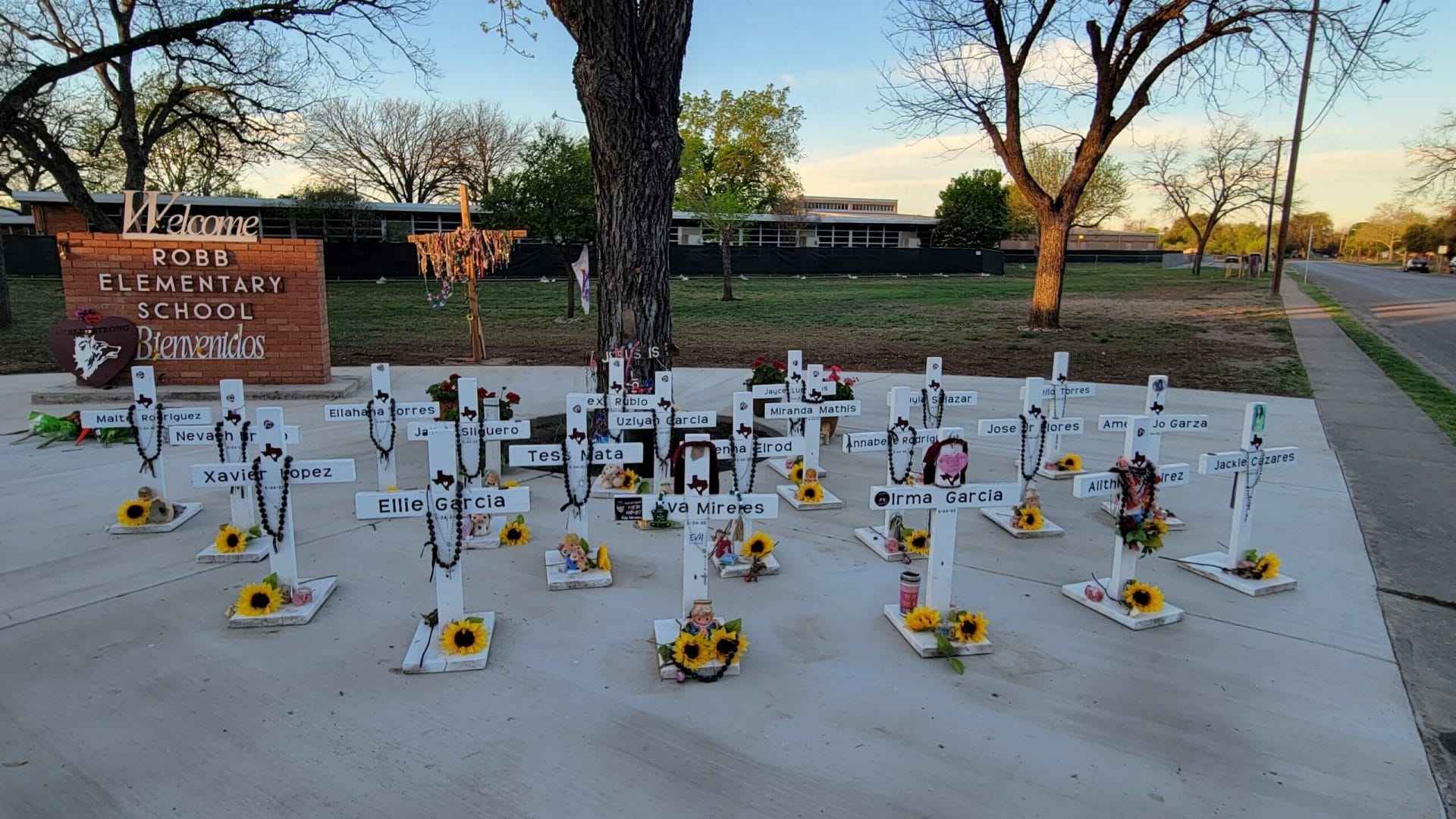
Several people we interviewed also mentioned that they have continued to experience inconsistent access to local mental health services. Following the shooting, many mental health providers came to Uvalde from San Antonio, and interviewees were uncertain how long these services would remain in Uvalde. One father of a Robb Elementary victim, for example, opened up to a therapist despite his initial misgivings about therapy. When the therapist was reassigned, however, the father was left devastated and completely shut down, understandably unwilling to begin the process all over again.
The residents repeated this theme in several interviews. One person stated that “The Resiliency Center has a high turnover of counselors. They change all the time… People don’t want to go anymore.”86 Another parent reported that “the Resiliency Center did not work because they kept canceling on us and my daughter was denied teletherapy… they did not explain as to why.”87 This lack of consistency can create unpredictability and hinder healing. Moreover, an additional benefit of having mental health providers that are familiar with and can connect survivors to supportive local resources is that this can facilitate their stabilization after exposure to mass violence.88
It should be noted that some people mentioned they actually preferred to work with mental health professionals that were not previously connected to Uvalde. According to one interviewee, “People in Uvalde don’t want local counselors… it is a small town… everybody talks.” This highlights the importance of providing options for accessing mental health services and empowering survivors and their families with choices. According to SAMHSA’s principles of trauma-informed care, providing opportunities for choice and empowerment are essential components in working with survivors of trauma.
High Costs and Lack of Insurance
The cost of mental health care, as well as income and lack of access to insurance, are other barriers that have hindered Uvalde survivors’ equitable access to care.89 One person we spoke with mentioned that in addition to having limited access to local mental health services, they paid approximately $50 per session. Considering the cost of care also includes taking time off work and transportation cost, there are many additional barriers to care.90
This is particularly relevant in the context of Texas, which has the highest number and highest percentage of uninsured residents per capita in the nation91—and a large percentage of those with insurance in the state do not have coverage for mental health services.92 About one in five residents is uninsured in Uvalde, so this is an issue that disproportionately impacts Latino residents.93
Among Latinos with the highest need for mental health care, cost, and availability create significant barriers to access and utilization.94 Even more so, this is a group with an elevated risk of experiencing gun violence and subsequent PTSD symptoms.95 In Uvalde, a significant percentage of the survivors impacted by the shooting—directly and indirectly—are Latino. If the cost and availability of mental health care is not addressed, many survivors will simply go without access to care. Numerous community members we spoke with indicated that this was the case for them.
Stigma around Mental Health
Despite the overwhelming need for mental health services, both before and after the shooting at Robb Elementary, stigma is another significant barrier to accessing such services for survivors in Uvalde. Approximately 73% of the residents in Uvalde identify as Latino, and stigma is often cited as one of the barriers to receiving mental health services for this group, especially within rural communities.96 Latinos in the United States and Texas are disproportionately impacted by gun violence, and this barrier hinders them from accessing mental health care and contributes to their continued health disparities.97 Therefore, as one attempts to access mental health services, service providers must develop strategies to reduce the stigma in doing so.
The stigma associated with receiving mental health services is likely contributing to Uvalde survivors’ limited utilization of these services. In rural, tight-knit communities, there can be a stigma to receiving mental health services that can create a significant barrier for survivors of trauma.98 One parent we spoke with mentioned that during a fire drill, their child was triggered by the alarm and was mocked by peers because of their response. Another person mentioned how their children felt like they had a “target on them” because the therapists pulled them out of class and they felt “embarrassed.”
Culturally and linguistically appropriate care can minimize the stigma surrounding and avoidance of seeking mental health services. Therefore, one strategy to reduce stigma and improve treatment outcomes is to integrate culturally congruent interventions.99 Examples of culturally congruent interventions to overcome stigma in the Latino community include providing education on mental health in non-pathologizing ways that are not only linguistically appropriate but also incorporate other cultural elements and are disseminated in safe and trusted community locations. Uvalde service providers have acknowledged this gap and mentioned how they have intentionally recruited Spanish-speaking therapists on their teams.
Obstacles to Financial Assistance for Families
In the aftermath of the shooting, financial assistance programs offered support to the families, but the process of obtaining this support has been difficult. Several interviewees mentioned that they have taken time off of work due to their children’s increased mental health needs, but not all of them have jobs that provide benefits—meaning they face greater financial consequences for taking time off. Workers that are the most vulnerable in the labor market and do not have benefits like paid time off are at an increased likelihood of not receiving adequate care. At the same time, they are also the groups that are most vulnerable to experiencing poor mental health following a trauma.

Several families discussed the process of taking time off of work to care for their children that experienced significant trauma-related symptoms, comparing the ease or lack thereof to taking time off. One person mentioned that she could easily take time off from her job at the bank, while another mentioned that she needed to take time off from her caregiving job to care for her daughter but feared the potential risk of losing her employment and not being able to pay her bills. Families, especially those most vulnerable to experiencing negative mental health symptoms post-shooting, were stuck trying to balance caring for their children’s mental health and paying their bills.
Reverend Marsh noted that there have been several funds set up for the families directly impacted by the school shooting, such as the Texas Bridge Fund. However, many family members indicated that the process to obtain financial assistance was difficult—it required a significant amount of documentation, and it was often unclear when they would receive financial assistance. One person noted that she was concerned about paying her bills and indicated that she did not know the timeframe for when she would receive financial assistance, even after waiting weeks for a response.100
When working with trauma survivors, having clear and transparent processes to receive services is important to facilitate their recovery and promote healing.
Lack of Youth-Specific Programming and Facilities
A recurring theme for those we spoke with was a lack of youth programming in Uvalde. Access to low-cost youth programming that addresses multiple life domains (e.g., individual coping skills, family, connection to school and community) is associated with a reduction in youth violence and increased youth resilience.101 Several people mentioned the need for a sports complex, recreation center, and/or community resource center for young people, and another emphasized the importance of not only having access to youth programming but also ensuring the programming is affordable to residents.
One example of a successful youth program in Uvalde is the Road Rangers, offered through a local church. These types of programs offer youth exposure to protective factors like strategies to promote self-regulation, family support, school support, and peer support that can enhance their resilience and reduce the consequences of trauma exposure.102 One person mentioned there are several initiatives, such as the Community Health Development, Inc. to bring youth services into Uvalde through its planned community center project, but that these services will not be complete until 2024.103
Gun Violence in Hispanic & Latino Communities
Alex Nguyen—Jul 25, 2024
In addition to activities, access to green space is essential for youth development and is associated with increased community protective factors. Historically in Uvalde, schools have been places where youth can interact with each other and play. Today, unfortunately, young people in Uvalde do not have the same access. One interviewee noted that schools have started to put up large fences to prevent people from using the fields and that “this was not how it was in the past.”104
Accessing positive role models and engaging in physical activity is associated with improved resilience in trauma survivors.105 With the lack of access to formal youth activities and limited access to green space, many youth in Uvalde—especially high-risk youth—have limited opportunities to engage in prosocial activities and develop positive relationships with supportive adults. But the area has a great opportunity to change this, as there are several vacant spaces that could be converted into recreational spaces for the community. Government investment in creating more green spaces and reducing vacant land is associated with a significant reduction in crime, specifically gun-related violence,106 and it can be a cost-effective way to empower and engage community members in violence prevention efforts.107 Such empowerment is one of the key principles of a trauma-informed response to mass violence, and the local government should take advantage of the green spaces available.
It’s clear that Uvalde still has many significant and unmet needs as it approaches the one-year mark following the tragedy at Robb Elementary. The people of Uvalde are resilient and their connections run deep, but they face significant challenges—including a lack of mental health services, historical and persistent divisions based on race and socioeconomic status, barriers to accessing support and services for victims, and a lack of safe and healthy opportunities for young people. The second half of this report lays out concrete recommendations for policy changes and other actions that should be taken to help address these unmet needs.

The tragedy at Robb Elementary underscores the dire need for reforms at the local, state, and national levels. The following section explores the major themes that emerged from our conversations with Uvalde residents as well as national experts. We aim to address what’s needed in Uvalde, statewide in Texas, and across the nation in order to bring healing and safety to all communities.
These themes also provide a framework to incorporate the “Four Rs” of a trauma-informed approach: realizing the impact of trauma; recognizing how trauma exposure manifests in individuals, communities, and service providers; responding by integrating trauma-informed practices; and avoiding policies and practices that can retraumatize survivors.
Pass, Implement, and Improve Gun Safety Laws
One of the direct causes of the tragedy at Robb Elementary was the ease with which the 18-year-old shooter legally obtained an AR-15 assault rifle and numerous large-capacity ammunition magazines.
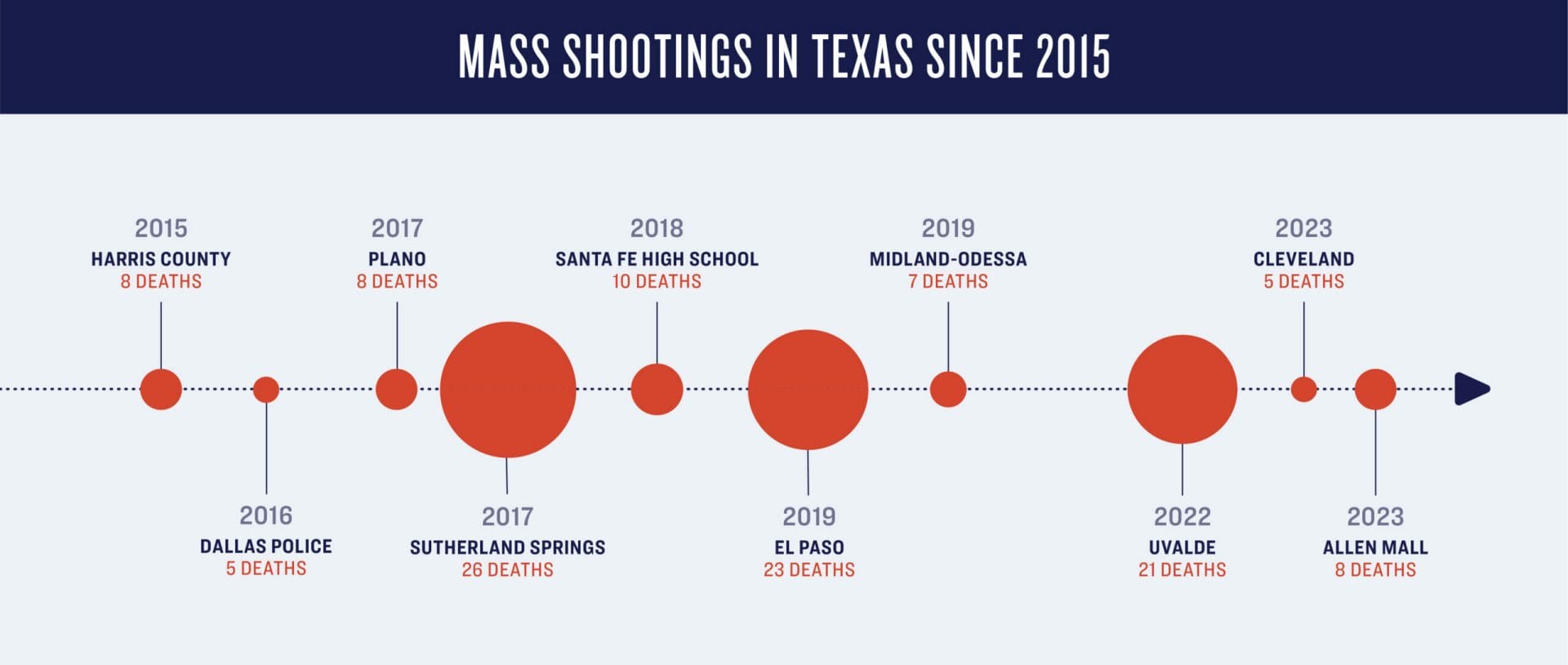
Texas has seen the second-highest number of school shootings since 2012 of any state in the nation.108 While this fact alone should catalyze a long and hard look at Texas’s weak gun laws, the sad truth of the matter is that mass shootings are just the tip of the iceberg of the gun violence epidemic. Texas—a state with a higher than average rate of gun ownership as well as some of the nation’s weakest gun laws—had more than 4,600 gun-related deaths in 2021,109 and tens of thousands more injuries. In terms of lives lost, that’s the equivalent of another 220 tragedies like the one at Robb Elementary in a single year.
Guns are involved in more than 59% of the state’s total suicides and more than 78% of the state’s total homicides, annually. In the past six decades, the state has experienced at least 19 high-fatality mass shootings that have killed a total of nearly 200 people and wounded more than 230 others. This gun violence takes an enormous toll on Texas residents in terms of pain, suffering, and loss. It also costs Texas $51.3 billion each year—$1.1 billion of which is paid directly by Texas taxpayers.110
While the Bipartisan Safer Communities Act strengthened federal laws and provided significant funding for a variety of measures, including community violence intervention programs, Texas leaders have not followed suit. Instead, in a state where gun violence is unrelenting, the legislature and Governor Abbott refuse to take meaningful action—and have instead focused on weakening existing gun safety laws.
Many survivors and family members of victims we spoke with expressed strong support for commonsense measures to regulate guns to avoid another similar tragedy. This is a divisive topic in Uvalde, as it is in the rest of the country, but support for at least some modest restrictions was expressed in most of the interviews conducted for this report—especially when it came to restricting the minimum age for firearm purchases. This section will explore this and a number of other key policies that would help to prevent the next mass shooting by keeping guns out of the hands of those who would use them to do harm.
Texas leaders must find the courage to act to save lives.
What Texas Does Well
- Mental health record reporting
- Child access prevention laws
What Texas Is Missing
- Universal background checks
- Gun owner licensing
- Extreme risk protection orders
- Most domestic violence gun laws
- Assault weapon restrictions
- Large-capacity magazine ban
- Waiting periods
- Strong concealed carry law
- Open carry regulations
- Community violence intervention funding
Raising the Minimum Age to Purchase a Firearm
The Uvalde shooter was just 18 years old when he legally purchased thousands of dollars worth of firearms and ammunition to carry out his attack. “If that law had been 21, I guarantee you he would have continued to be frustrated and not be able to obtain that weapon,” said State Representative Joe Moody, a Democrat from El Paso.111
Many in the Uvalde community interviewed for this report expressed support for gun rights, but also strongly supported the idea of raising the minimum age for purchasing firearms as a commonsense response to this and other tragedies happening around the country.112 This was a view expressed by victims and residents alike, many of whom attended a rally at the Texas Capitol in August of last year to call for raising the minimum age for purchasing semiautomatic rifles.113
It’s critical to consider that raising the age for purchasing firearms to 21 would address a host of issues beyond school shootings, including suicide and acts of community violence. Studies establish that brain development is not complete until at least age 25, particularly the part of the brain that regulates impulse control and decision-making.114 As a result, suicide attempts are at their highest rates from ages 14 to 21,115 and young people also disproportionately commit gun homicides: people aged 18 to 20 comprise just four percent of the US population but account for 17% of known homicide offenders.116 For all of these reasons, limiting easy access to firearms for people under the age of 21 is sound public policy and could have prevented the Robb Elementary School shooting.
Making changes to gun laws has never been easy in Texas,117 and raising the age limit for firearm purchases is no exception.118 However, Florida’s response to the Parkland massacre in 2018 provides a clear roadmap for Texas legislators. In Florida, a state known for being extremely friendly to gun rights, legislators passed and then-Governor Rick Scott signed legislation raising the legal age to purchase firearms from 18 to 21 and extending the mandatory waiting period for gun purchases to three days.
These provisions were passed into law with bipartisan support and signed by a Republican governor with an A+ rating from the NRA just three weeks after the tragedy in Parkland at Marjory Stoneman Douglas High School, where a 19-year-old shooter took the lives of 17 people and injured 17 others.119In Texas, even a full year after the shooting at Robb Elementary, political leaders have not taken any such action.
“I’m here today to be a voice for my son who was only 10,” said Felisha Martinez, the mother of Xavier Lopez, who was one of the children to lose their life last year in Uvalde, at a rally in Austin in 2022 in support of raising the minimum age requirement.120 “An 18-year-old was able to purchase a weapon to murder 19 children and two teachers. We need to do better and get these laws changed.”
Texas
This year, State Senator Gutierrez has introduced a package of bills designed to address gun violence in Texas, including Senate Bill 145, which would raise the minimum legal age for purchasing or renting a firearm from 18 to 21.121 This bill and others face an uphill climb without more support from the state’s Republican leaders. Governor Abbott expressed his views that an age restriction would violate the Second Amendment, ignoring the fact that similar constitutional challenges to Florida’s minimum age law, and those in other states, have not been successful.122
Texas House Speaker Dade Phelan has also publicly stated that this policy lacks the vote to pass. However, at the very least, Speaker Phelan should grant the opportunity for full debate and discussion of this policy and allow for a vote, so Texans can know which of their elected representatives oppose policies that could help prevent the next tragedy.
“Simply doing nothing is about as evil as it comes,” said Senator Gutierrez in the weeks following the shooting at Robb Elementary.123 Texas leaders must set politics aside and find the courage to protect their constituents.
Congress can also take action at a federal level and determine the minimum age of legal firearm purchase and possession. Currently, federal law applies differently depending on whether the seller is a licensed or unlicensed dealer and if the firearm in question is a handgun or long gun.124 Unlicensed dealers can sell a long gun to a person of any age, and can sell handguns to individuals 18 or older. Licensed dealers can sell long guns to individuals 18 or older and handguns to individuals 21 and older. Strengthening age restrictions nationwide would remove ambiguity and help prevent all-too-frequent acts of gun violence and self-harm committed by young people.
Passing an Extreme Risk Protection Order Law
Extreme risk protection orders (ERPOs) provide a proactive way to stop mass shootings and other tragedies by temporarily intervening to suspend a person’s access to firearms if they show clear warning signs of violence. An FBI study of the pre-attack behaviors of active shooters found that the average shooter displayed four to five observable and concerning behaviors over time, often related to the shooter’s mental health, problematic interpersonal interactions, or other signs of violent intentions.125
In many instances of gun violence, family members or friends noticed warning signs that people close to them were at significant risk of harming themselves or others. The shooter who perpetrated the 2018 school shooting in Parkland, Florida, for instance, was prohibited from carrying a backpack on school grounds for fear that he might be concealing guns. He had been the subject of dozens of 911 calls to local law enforcement and two tips to the FBI. Yet Florida at the time, as is the case now in Texas, lacked a mechanism of preventing him from accessing guns. Extreme risk protection laws fill this gap by empowering families, household members, and law enforcement agencies to petition courts for a civil (non-criminal) order to temporarily suspend a person’s access to firearms before they commit violence.
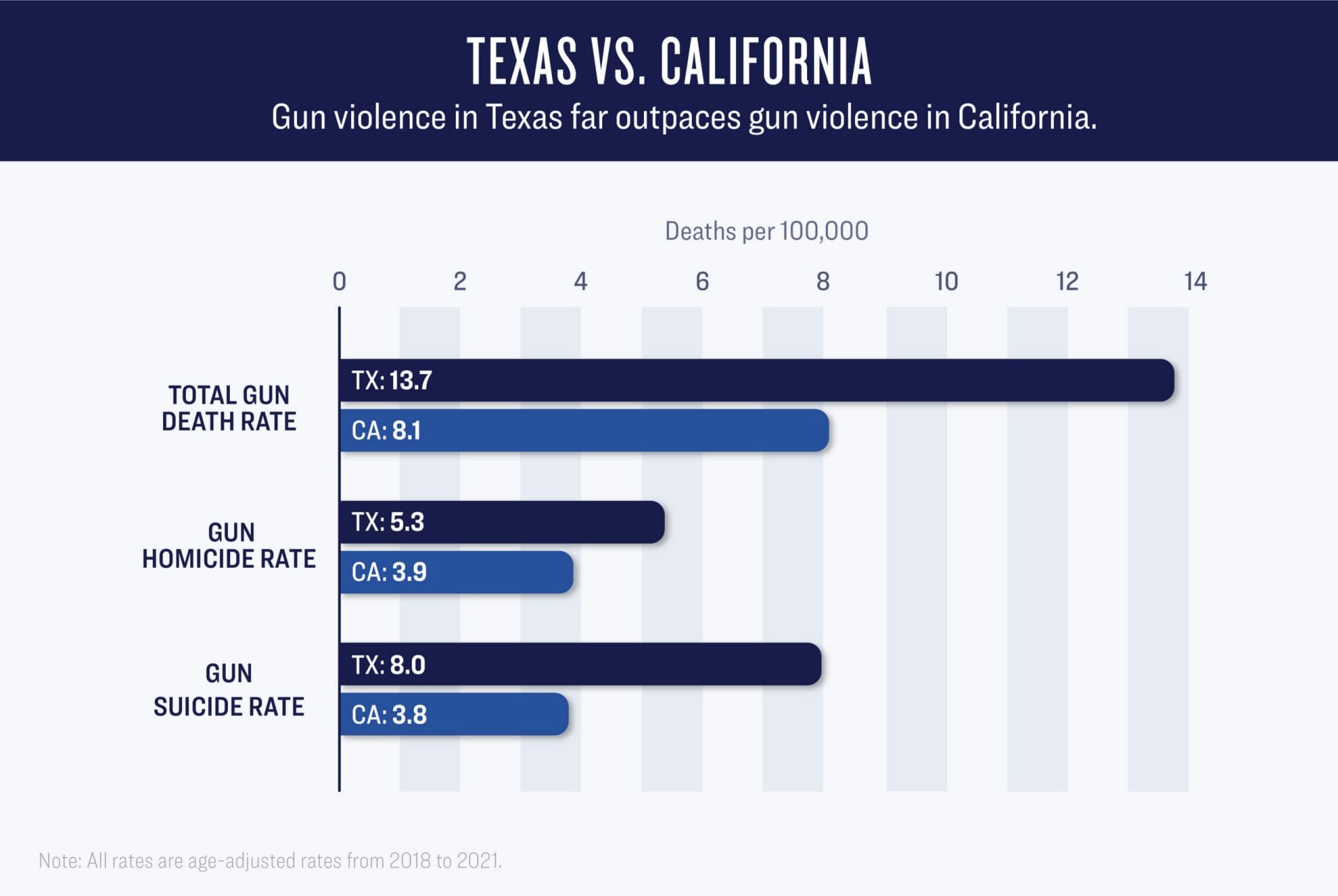
In response to an increasing number of tragedies, states have begun enacting lifesaving tools that can prevent gun tragedies before they occur, including in politically conservative states like Florida—unofficially known as the “Gunshine State” for its strong position in opposition to gun safety laws.126 Following the school shooting in Parkland, Florida enacted an extreme risk protection order law. This law created a process for courts to temporarily suspend a person’s ability to lawfully access firearms if the court determines there is sufficient evidence that the person presents a significant risk of violence or self-harm in the near future.
In response to this, the NRA responded by lowering the grades of any legislator who voted for the bill, including demoting then-Governor Scott from an A+ to a C. Yet this did not have any political consequences for Republican supporters of the bill. “Not one Republican who voted for that bill in Florida has paid a political price for protecting kids and doing the right thing.”127
Given the evidence that ERPOs can save lives and prevent tragedies, Texas legislators should show the same courage that Florida legislators did in 2018. Florida’s ERPO process has already been used thousands of times to temporarily disarm people showing clear warning signs of violence, including a man who put a loaded gun to his head in front of his girlfriend and his mother, a woman who threatened to burn down her house and shoot any responders, and a father who threatened to shoot everyone at his son’s school.
Studies further confirm the lifesaving benefits of this policy. Researchers found that one life was saved from suicide for every 10 firearm removals under Indiana’s extreme risk law. Studies of Connecticut’s law similarly found that by temporarily removing weapons from 762 high-risk individuals over the study period, Connecticut’s extreme risk law had prevented up to 100 suicide fatalities, in addition to lives saved from the prevention of homicide.128 Similarly, Connecticut’s and Indiana’s extreme risk laws have been shown to reduce firearm suicide rates in these states by 14% and 7.5%, respectively.129 A recent study of ERPOs use in six states reported 10% of ERPO petitions involved threats of mass violence: The threats targeted schools, businesses, intimate partners and their children, and families, and judges granted more than 80% of the petitions.
In the wake of a recent tragedy in Louisville, Kentucky’s Republican governor, Andy Beshear, called on state legislators to pass an ERPO law to help prevent future tragedies. “I’d like to think Democrats and Republicans—red or blue, anybody on the ideology—can come together and say, ‘If we know somebody is right on that brink of going out and committing a horrendous action, don’t you think we should be able to take action?’” he said.130 Governor Beshear is right, and Governor Abbott should follow this example and exhibit similar courage—the courage to place the lives of Texans above the special interests of the gun lobby.
Implementing Background Checks for All Gun Sales
A dangerous gap in our federal gun laws allows people to buy guns without passing a background check. Under current law, unlicensed sellers—people who sell guns online, at gun shows, or anywhere else without a federal dealer’s license—can transfer firearms without having to run any background check whatsoever.
Because of this loophole, people who are subject to domestic violence convictions or court orders, people who have been convicted of violent crimes, and people ineligible to possess firearms for mental health reasons can easily buy guns from unlicensed sellers with no background check in most states. In fact, an estimated 22% of US gun owners acquired their most recent firearm without a background check—which translates to millions of Americans acquiring millions of guns, no questions asked, each year.
Source
Matthew Miller, Lisa Hepburn & Deborah Azrael, “Firearm Acquisition Without Background Checks,” Annals of Internal Medicine 166, no. 4 (2017): 233–239.
Texas is one of 29 states that has not addressed this gap in federal law with its own state-level background check requirement. The state has no law requiring a background check on the purchaser of a firearm when the seller is not a licensed firearms dealer.131
This policy failure has had ongoing and deadly consequences. As just one example, a man fatally shot seven people and wounded 25 others in West Texas in 2019. The shooter previously failed a criminal background check when trying to purchase a gun, yet loopholes in national and Texas gun laws allowed him to bypass the background check system altogether and obtain the AR-style weapon used in his deadly attack from an unlicensed seller who wasn’t required by Texas law to run a background check.132
“Seventy-eight percent of Texas voters support strengthening background checks, recognizing that we must do more to keep guns out of the hands of individuals with dangerous histories,” states the Texas Gun Sense website.133 “This measure could have prevented the mobile mass shooting in Midland-Odessa.”
Research has shown that states which have closed the background check loophole through firearm owner licensing see a 56% reduction in mass shootings,134 proving that background checks have the potential to stop not only individual homicides and suicides, but also mass tragedies. Background check laws also help prevent guns from being diverted to the illegal gun market. States without universal background check laws export crime guns across state lines at a 30% higher rate than states that require background checks on all gun sales.135
In recent years, states like New Mexico,136 Virginia,137 and Vermont138 have responded to gun violence by enacting this commonsense, lifesaving measure. Governor Abbott and the leaders of the Texas legislature should do the same. This kind of system change would respect the Second Amendment rights of responsible gun owners while also honoring the 21 lives lost in Uvalde—and the countless lives impacted by gun violence across the state—with concrete action that will prevent similar tragedies from occurring in Texas in the years to come.
Expand Community-Based Programs and Services for At-Risk Youth and Young Adults
One of the most common needs expressed by Uvalde residents was the lack of programming, services, and safe spaces for youth, and particularly for youth that may be at higher risk of participating in violent behavior. “There are definitely not enough services in Uvalde for at-risk kids, we don’t even have a Boys & Girls Club,” noted members of one family whose daughter attended Robb Elementary and was there on the day of the shooting.139 “And there’s just zero for high-risk kids who have dropped out of school, like the shooter did.”
Expanding these services in Uvalde would help fill an important community need and also work to prevent future violence. An analysis of school shootings from 2008 to 2017 by the Secret Service showed that most school-age attackers have a number of common traits and circumstances, including a history of school discipline and a major source of social stress at least six months, such as bullying, romantic conflicts, or fights with family members.140 Many of these conditions were present for the Uvalde shooter, but there was not a system of support in place to help him address these issues.
“The constructive interventions may be counseling, support for education in a school setting, employment support, social services, these kinds of measures that are really intended to help a person improve their situation and thereby steer them away from thinking about potential violence,” said Mother Jones journalist Mark Follman, whose recent book Trigger Points discusses the need for behavioral health interventions that can stop mass shootings before they occur.141 “Often these are people who have deep grievances that they are having trouble letting go of, and they’re seeking a way out of a problem that they feel stuck in.”
Providing services to at-risk youth and young adults is not just a way to prevent a future mass shooting, but is also a protective factor against small-scale forms of violence and self-harm, helping to lower the risk of suicide. “In communities with stronger systems, those youth are often identified in the courts or at school for help before their problems turn into bigger issues,” pointed out an article in the Texas Tribune.142 “But in Uvalde, as with other underserved places, there are no formal mechanisms in place to do this. There are no automatic referrals to counselors for truancy, for example, or for alternative school placement.”
Such services have long been lacking in Uvalde, but now that the community has experienced the trauma of a horrific school shooting, the provision of support and programs for young people is more critical than ever. Community members reported that one of the most pressing gaps is the lack of a physical location where youth can participate in enriching activities.143 “Currently, the community has a limited number of local programs and youth activities,” noted a mental health assessment conducted by the Meadows Mental Health Policy Institute.144 “Uvalde [Consolidated Independent School District] leadership expressed a strong desire for the development of engagement opportunities for the community to come together around this shared experience to meet the needs of the school staff and families by providing a space for the overall community to move forward together.”
One of the efforts underway to help address this is the planned construction of a state-of-the-art multipurpose community center, which was supported with a $7.9 million investment by the Centene Charitable Foundation.145 In partnership with Community Health Development, Inc. (CHDI), a federally qualified health center, the vision for the space is to function as a one-stop resource for residents in Uvalde and the surrounding region. It would house health care providers, youth development programs, educational supports, retail space for local businesses, and a garden to honor the victims of the shooting at Robb Elementary.
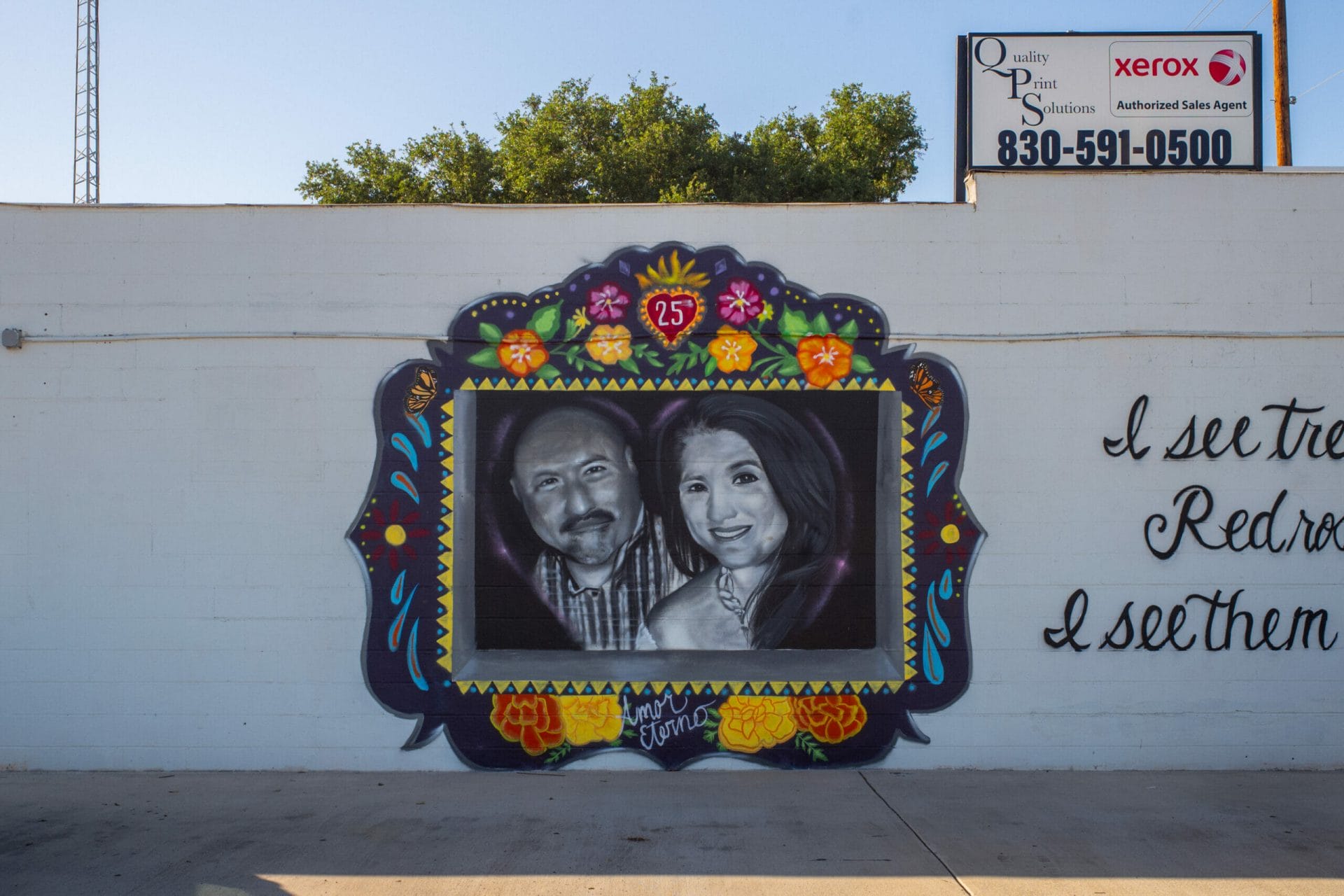
“Six days after the horrific tragedy at the Robb Elementary School, Centene and Superior met with CHDI and local leaders to understand how we could best support Uvalde in what will necessarily be a long-term recovery,” said Sarah London, chief executive officer of Centene.146 “As that process continues, expanding the resources available to the entire community for physical, mental, and emotional health is an important step forward.”
The Uvalde Community Center is slated to be completed in 2024, and several stakeholders expressed enthusiasm about being able to host so many services in a single location—especially in a community where transportation remains a major obstacle. That said, there is still a pressing need to increase the availability of services in the short-term and to provide support for longer-term projects like the Uvalde Community Center.
Along these lines, the Meadows Report also includes a recommendation to implement “Youth Mobile Crisis Teams,” in the Uvalde region. These teams “specialize in working with youth and caregivers to de-escalate crises, provide limited in-home supports, and link the young person and family to appropriate ongoing services. They have a strong track record of diverting youth from inpatient placement and helping them remain in their community.”147 We echo that recommendation here, and call for the implementation of a range of other culturally response services for at-risk youth in the area.
State Investment in Community Violence Intervention Strategies
At the state and national levels, the tragedy in Uvalde highlights one of Texas’s—and America’s—most glaring gaps when it comes to the gun violence epidemic: the lack of services for high-risk youth. Far too often, especially in America’s most underserved communities, once a young person is outside the school system, there are no formal support systems to help address underlying risk factors for violence. In other words, those who are most in need of help are also those who are least likely to receive it, especially in a state that was recently ranked last in the nation in terms of access to mental health care148 and 45th when it comes to overall child well-being.149 This needs to change.
That said, Texas leaders must recognize that homicides and shootings are much, much more common in underserved communities of color and in physical locations other than schools: In 2020, 79% of the state’s 1,734 gun-related homicide victims were non-white, and almost all occurred somewhere other than a school campus.150 In the US, as in Texas, “Far more kids are shot outside school than in one—7,100 a year between 2012 and 2014 , or 19 every day, (compared with about 60 shootings at schools each year),” wrote David Ropeik, a retired instructor at Harvard and the author of a book on risk.151 “The statistical likelihood of any given public school student being killed by a gun, in school, on any given day since 1999 was roughly 1 in 614,000,000.”
This underscores the need to invest in programs specifically designed to reach individuals at high risk of engaging in violence in the areas most disproportionately impacted by violence—following the example of programs like Massachusetts’s Safe and Successful Youth Initiative (SSYI), which supports the local implementation of community-based services to reduce the risk for young people in both school and community settings.152 Studies have shown that with an annual investment of $10 million, SSYI is reducing instances of serious violence and creating huge savings for taxpayers as a result, creating more than $5.10 in savings for every dollar invested in the program.153
At present, Texas is not making any state-level investment in these kinds of CVI programs. It’s noteworthy that the gun homicide rate in Massachusetts is three times lower than in Texas. For context, Massachusetts is investing nearly $40 million annually for the types of programs described above, which represents a per-homicide investment of more than $260,000. A proportional investment in Texas would require an appropriation of $575 million.
Given the urgency of community violence, and the promising fiscal outlook in Texas—with a projected budget surplus of $32.7 billion154—now is the time for an effort to truly meet the moment. Texas should join the many other states that are taking significant action on this issue including Illinois ($250 million),155 California ($200 million),156 Wisconsin ($45 million),157 Pennsylvania ($30 million),158 and New Jersey ($10 million).159
Develop Long-Term Mental Health Services
Mass shootings tend to lay bare the most severe divisions and unmet needs that exist in a community even prior to the tragedy, and inadequate mental health resources are often at the top of the list. This is especially true in Uvalde, which before the shooting at Robb Elementary was described as a “mental health desert.” It doesn’t help that it’s in a state that ranks last in the nation in terms of per capita state spending on mental health and overall access to mental health care.160
In September 2022, Texas ranked last in the country when it came to the number of people insured, and 14% of children with health insurance in the state don’t have coverage for mental health services.161 The state also ranks 50th for the ratio of mental health providers to people, with only one provider for every 830 people.162 This lack of access to mental health services has and will continue to significantly hinder a Texas community’s ability to recover post-shooting.
In the days immediately following the Uvalde shooting, Governor Abbott convened law enforcement and local community leaders, including Uvalde’s mayor, and asked them to discuss what had contributed to the shooting and what needed to change going forward. “…they were straightforward and emphatic,” Governor Abbott described. “They said, ‘We have a problem with mental health illness in this community.’ And then they elaborated on the magnitude of the mental health challenges that they are facing in the community and the need for more mental health support in this region.”163
Part of the issue with this statement, as local media pointed out, was that just a few months prior, the governor cut an additional $211 million from the department that oversees mental health programs in order to fund additional border security.164 Instead of weakening these programs, the Texas government should make long overdue investments and comprehensive reforms to its mental health system in order to help survivors and honor the lives lost in Uvalde.
Doing so, however, will require political leaders to do more than just talk about the need to address mental health—it will require action. In 2022, Texas leaders announced the investment of an additional $105.5 million for school safety and mental health initiatives,165 but most of this investment was not related to mental health and—especially given the prior year’s budget cuts—there is still much that needs to change.
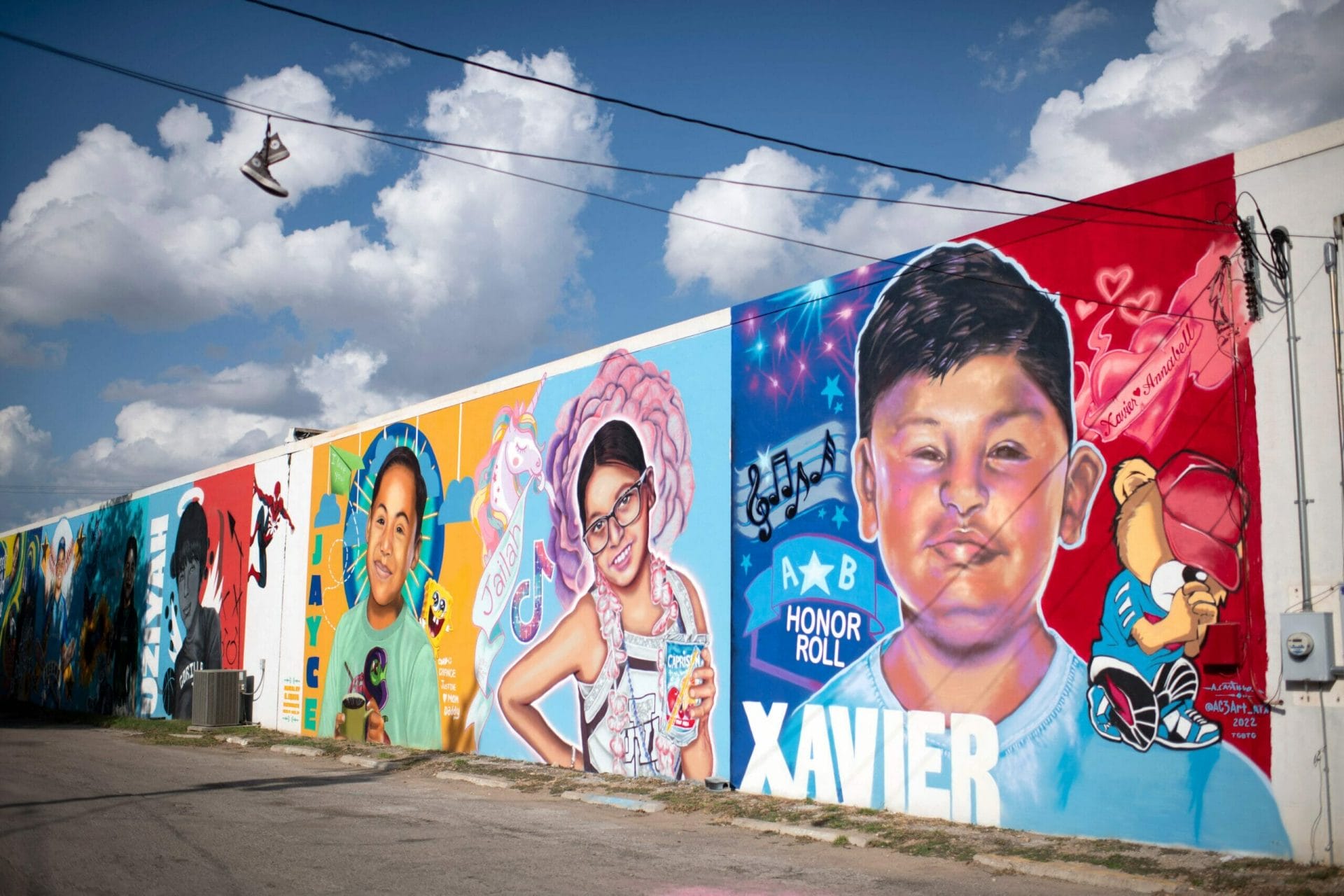
It’s important to recognize that improved access to mental health services on its own is not a singular solution to America’s gun violence epidemic. Far too often, mental health is used by politicians as a scapegoat in the national conversation about gun violence. “Blanket comments about mass shooters’ mental health are also a disservice to the people in this country living with a mental illness: 1 in 5 Americans, a majority of whom are not violent.”166 Moreover, “While some specific mental illnesses increase the risk of violence, mental illnesses on their own do not cause violence, and violence itself is not a mental illness.”167
That said, improving our mental health systems will help address some amount of gun violence—in many communities, for example, untreated PTSD is a significant risk factor for violence.168 Improving mental health systems is also imperative for providing healing to the millions of Americans whose mental and physical health have already been impacted by such violence.
The need for improved mental health services was echoed by nearly every stakeholder interviewed for this project, and it is patently obvious from the facts. According to the US Department of Health and Human Services, at the time of the shooting, Uvalde only had about 15 mental health professionals based in the town, including mental health therapists and substance abuse counselors. There was only one psychiatrist affiliated with Uvalde Memorial Hospital, where emergency room beds for mental health patients are most often used for drug cases. There remains no dedicated mental health hospital or residential treatment facility. As Uvalde Mayor Don McLaughlin has stated, there were only two mental health counselors to cover five counties prior to the Uvalde shooting. “So these people get missed,” he lamented.169 “They don’t have the services they need. They don’t have the help they need.”
For years, local officials have been fighting to fund an inpatient psychiatric facility in the region. Currently, patients in need of hospitalization or long-term care must drive hundreds of miles across the state to find an available bed. “Right now,” Mayor McLaughlin said, “if we have somebody that we have to take to a bed, we may have to go as far as Texarkana, Texas, to find a bed available. You know, that’s a 13-hour drive from Uvalde. [Governor Abbott] said he hopes this tragedy ‘will bring awareness both to the gun side of it and to the mental health side of it.'”170
As previously mentioned, mental health services also include nontraditional modalities of care. These can offer many benefits to survivors and minimize the stigma surrounding care.171 In Uvalde, there are several organizations currently engaged in these practices and providing supportive spaces for survivors. Therefore, funding for mental health services must also include expanding access to these types of support, which are often not reimbursed through insurance.
Access to long-term mental health services is necessary to support the long-term recovery of Uvalde residents impacted by the shooting at Robb Elementary. The mental health consequences of trauma and PTSD can manifest months and years after the initial exposure to violence, so community members will continue to need access to mental health services long after the incident. Youth that are exposed to trauma are also at greater risk for long-term consequences such as poor academic performance, increased rates of substance misuse, and increased risk of engaging in high-risk behavior, which includes increased risk of engaging with high-risk peer groups.172
Meadows Mental Health Policy Institute Needs Assessment and Recommendations
To their credit, Texas leaders recognized the importance of addressing these gaps, and in June 2022 allocated up to $5 million to be used by the Hill Country Mental Health & Developmental Disabilities (MHDD) Center to assist in evaluating mental health services in the Uvalde community and preparing a needs assessment for the legislature.173 As a result, MHDD contracted with the Meadows Institute to conduct a comprehensive mental health needs assessment for the region.174 Several of the key recommendations of this report are lifted up here, with the caveat that many people interviewed were not familiar with the assessment, suggesting that more needs to be done to publicize the process and to engage with the Uvalde community.
One of the first major findings of the report was that “there is a clear need to expand mental health capacity and resources in the Uvalde region.” As evidence of this, the Meadows Institute found that, “In Uvalde County, there is only one psychiatrist available per 25,000 county residents,” and that there are currently “no psychiatrists in Uvalde County that focus specifically on the estimated 5,000 children and youth ages six and over in the county.” Similarly, data showed that the region had only one licensed psychologist available for every 6,796 residents, and “in Uvalde County, there are only two licensed psychologists providing services for the entire county, which represents one psychologist per 12,500 Uvalde County residents.”
The Meadows Institute report outlined goals and action items in order to fill the glaring gap in mental health services in the Uvalde region. Below, we explore the most pertinent ones:
- Build a regional behavioral health campus in Uvalde, supported by additional specialty resources in San Antonio.
- Expand the mental health workforce.
- Improve financial and other incentives to attract mental health providers.
- Increase access to telemedicine.
- Establish a community mental health planning group with a dedicated staff.
The report recommendations have the support of city and county leadership. “We have worked with Hill Country MHDD Centers and the Meadows Mental Health Policy Institute throughout the assessment process,” declared a letter signed by Uvalde’s mayor.175 “The final report includes key findings and actionable recommendations that will address the regional needs for mental health services in our communities. Both the City and County elected officials support the recommendations in this report and look forward to working with Texas leadership on the next steps.”
Initially published and available to the public in December 2022, the report was briefly taken down before becoming available again online in April 2023. The state should ensure that this important document remains widely available to help inform residents and key stakeholders.

Build a regional behavioral health campus in Uvalde, supported by additional specialty resources in San Antonio.
As described in detail above, the state has made some initial investments into the provision of mental health services in Uvalde, but there is clearly a need for longer-term resources. Given the preexisting needs and the expected increase in needs for services following the tragedy at Robb Elementary, experts at the Meadows Institute recommended the construction of a comprehensive trauma-informed behavioral campus whose services can be tailored to the unique needs of the community.176 Designed to “[P]rovide behavioral health services and access to crisis triage and response for children, youth, and adults…the campus should be designed to facilitate rapid triage, early intervention, initiation of treatment, and continuous observation.”
The city has identified this need and advocated for it over the course of many years, and even before the shooting federal funding was secured to support the planning and design of such a facility. Following the shooting at Robb Elementary, the need for such a facility is even more acute.
It’s Time to Put an End to Hate-Motivated Violence
May 12, 2023
The city of Uvalde has already helped lay the groundwork for this project by donating seven acres of land in a central location, meaning the project won’t have additional land acquisition costs. The Meadows Institute estimated the cost for the project as $33.6 million for construction and furnishing, and then $10 million annually for operating costs.
“We know that the needs of the Uvalde community following the Robb Elementary [tragedy]—the mental health needs—are going to be long term,” said Landon Sturdivant, deputy CEO of the Hill Country Mental Health and Developmental Disabilities Centers, in an interview with local media.177 “And we believe this would be one approach that can help integrate enhanced behavioral health services in the community, both from a full continuum of crisis residential to expanded outpatient mental health services as well.”
Funding in this exact amount is being considered by the Texas legislature as part of the current budget proposed by the Texas Health and Human Services Commission.178 As something that the region desperately needs and GIFFORDS strongly supports, this investment could help Uvalde become a model for the provision of mental and behavioral health services in a rural setting, which would have positive effects nationwide. The need for additional state funding for the expanded availability of in-patient beds was also specifically recognized and recommended by the predominantly Republican Senate Special Committee to Protect All Texans, which was tasked with making recommendations for “legislative improvements” in the wake of the Uvalde tragedy.179
The Meadows Report illustrates the many possible services this facility could help provide to the region, as well as the numerous jobs it would create.180 Such an influx of employment would be an economic boon for the Uvalde region, and would also attract talent to help address another major issue identified by the Meadows Institute report: the dire need to build up the capacity of the mental health workforce in Uvalde and surrounding areas.
Expand the mental health workforce.
At present, there are simply not enough mental health professionals in Texas. Sonja Gaines, a behavioral health official at the Texas Health and Human Services Commission, identified the retention of qualified mental health providers as a significant barrier to care in the state. “We have to strengthen the workforce,” she testified.181 “We just simply have to do that.”
This is also true in Uvalde, where the need to expand the mental health workforce was identified in the Meadows Institute report and confirmed by many community members we interviewed for this report. “We cannot get enough mental health professionals here,” reported Brenda Faulkner, director of programs for the Children’s Bereavement Center in South Texas and a Uvalde resident since September 2022.182 “We’re at capacity, but we have three full-time positions that we’re trying to fill. It’s really hard to compete with wages offered in places like San Antonio, so we’re doing our best to match those wages, but it’s still been a challenge.”
The Meadows Institute report contains a concrete example of these very real challenges. In Texas, Hill Country MHDD posted a position seeking a psychiatrist with a salary of $200,000 and did not receive a single application after an entire year. Even after funding from the state allowed Hill Country MHDD to increase the salary to $300,000, it still received only two applicants.183 As of the time of the publication of the Meadows Institute report at the end of 2022, the position remained open “because qualified candidates report that they are not interested in providing services in Uvalde County.”
The Meadows Institute report also recommends leveraging partnerships with local university graduate programs to increase access to mental health providers. These graduate-level students would work under the supervision of a licensed mental health counselor to provide low-cost mental health services. This approach has been effective in both attracting and retaining mental health providers in rural communities.184
It’s clear that a multi-pronged approach is required to increase the mental health workforce that is available to residents in the Uvalde region. This includes increasing financial incentives, but also lowering barriers to attract qualified, out-of-state professional providers while simultaneously expanding access to quality telehealth services—which would allow Uvalde residents to more easily work with providers in San Antonio and beyond.
Improve financial and other incentives to attract mental health providers.
One strategy to address the limited number of mental health providers in Uvalde is to provide better financial incentives. Several interviewees mentioned how they advocated for financial incentives, including increased wages, to attract mental health providers. For instance, Brenda Faulkner described that the Bereavement Center is specifically looking at “San Antonio wages” for its mental health providers.185
Financial incentives aren’t limited to just increased wages, but also include assistance in covering graduate school loans or providing scholarships, which are cited as a barrier to attracting Spanish-speaking mental health providers. These strategies are especially important to attract and retain bilingual and bicultural mental health providers to work with a predominantly Latino community.186

At the state level, the Texas legislature can increase funding for the Texas Loan Repayment Program for Mental Health Professionals, which will help ease the financial burden for those looking to enter the field. To attract talent from outside of Texas, the Meadows Report recommended that Texas legislators should also “direct licensing agencies to waive out-of-state licensing prohibitions for all mental health and addiction license types, on an emergency basis, as was done for the regions affected by Hurricane Harvey in 2018 and for COVID-19 on a statewide basis. This should be done immediately, reviewed annually, and remain in place until a sufficient workforce is available in Texas.”
The Meadows Report also pointed out that Medicaid in Texas does not reimburse for services provided by Licensed Master Social Workers (LMSWs), Licensed Marriage and Family Therapists (LMFTs) associates, or Licensed Professional Counselor (LPC) associates. “This limitation hinders rural providers’ ability to hire additional mental health professionals and, therefore, develop a sustainable mental health workforce,” concluded the report.187 “Allowing services provided by these professionals to be reimbursed will allow rural providers to financially accept LMSW, LMFT associates, and LPC associates who are completing their training.” This kind of increased compensation will help Uvalde and other rural communities in Texas to attract the kinds of mental health professionals that they so need and deserve.
It’s also worth noting that most, if not all, of these recommendations were supported by the Republican Senate Special Committee to Protect All Texans. The special committee pushed for the state to “take action to increase the number of mental health practitioners available to treat students—including allowing practitioners to volunteer to participate, investing in practitioner loan repayment programs, offering paid fellowships and internships, and streamlining licensure requirements.”188
Increase access to telemedicine.
It may not be feasible to bring every needed professional to the Uvalde region, but it’s possible to bring Uvalde residents to them through the use of an increasingly popular approach in health care: telemedicine. This term refers to the use of technology, like video conferencing, that allows a provider to give health care services to a patient who is not physically present with the provider.
As the Meadows Report described, “The COVID-19 pandemic has changed healthcare, leading patients and providers to new care delivery methods like telehealth, which has been shown to alleviate workforce issues as well as reduce barriers to behavioral health. These efforts have the potential to support rural communities in accessing mental health support as well as reducing unnecessary hospital transports for people who can be stabilized in the community.”189 All efforts should be made to help facilitate the use of telehealth, from the provision of secure areas with high-speed internet access to an awareness campaign by local health providers, especially primary care providers, who have high levels of trust with the community.
This is particularly important for small communities like Uvalde, where many people we spoke with indicated a preference to work with mental health providers who are not already embedded in the town as a way to maintain confidentiality in a close-knit community. These people identified long drive times and transportation costs as barriers to accessing services in San Antonio, but using telehealth would help to eliminate most if not all of these obstacles to care.
Texas Child Health Access Through Telemedicine
Related to this is the Texas Child Mental Health Care Consortium, which operates the Texas Child Health Access Through Telemedicine (TCHATT) program, which was launched in 2019 in response to yet another tragic school shooting at a high school in Santa Fe, Texas, in 2018 that resulted in the deaths of eight students and two teachers. Through TCHATT, the consortium “funnels resources and expertise into a network of doctors, counselors and other professionals at universities in 12 regions across the state to respond to children identified in schools as showing signs of distress.”190
The program had not yet reached Uvalde in 2022, where the 18-year-old shooter would have been a perfect candidate for TCHATT services, given his troubled history of abuse at home, bullying at school, alarming rate of absences, and ultimately dropping out of school.191 Programs like this can create critical moments to intervene in cycles of crisis. “I do think that we can help prevent people committing suicide,” said Laurel Williams, a professor of child and adolescent psychiatry at Baylor College of Medicine, who oversees the implementation of TCHATT.192 “We can help prevent people from being so depressed they drop out of school. We can prevent people from maybe starting substance misuse and having additional problems. And obviously, we all hope that we can come together to prevent another school shooting.”
The stated goal of the Abbott administration is to have TCHATT available to all school districts in Texas. As of April 2023, however, the program was only available in less than half of the state, and even in some enrolled districts only a handful of schools are participating.193 In this session, Texas legislators are considering a $280 million funding proposal for TCHATT, which is more than double the program’s investment over the last two fiscal years. Given the importance of telemedicine in reaching isolated communities, this funding is crucial to expanding TCHATT services and developing long-term, sustainable mental health services.
Establish a community mental health planning group with a dedicated staff.
In order to help coordinate mental health services in Uvalde and to pursue the implementation of the recommendations, the Meadows Report calls for the creation of a “Community Mental Health Planning Group that includes “providers, hospitals, academic institutions, schools, law enforcement, community members with lived experience, courts and elected political leadership.”194 Indeed, community collaboration is critical to sustainable change and consistent with the trauma-informed framework. GIFFORDS echoes this suggestion here, especially since many community members interviewed for this project noted the need for enhanced coordination in this space.
Statewide Investment in Mental Health Services
A recommendation not specifically outlined in the Meadows Report—but one we want to highlight—is to increase the statewide investments in mental health services. The mental health gaps and needs in Uvalde are reflections of policy failures at higher levels of government. Simply put, Texas must do much better to address the issue of mental health. With a more than $32 billion budget surplus, this is a unique opportunity to move the state in a different direction—in one that will honor the lives lost in Uvalde and help millions of people across the state.
In April of this year, Texas leaders unveiled a plan for a $2.3 billion investment in expanding the capacity of its mental health system.195 These funds would be allocated to the Texas Health and Human Services Commission under Senate Bill 30,196 a supplemental appropriations bill that was passed by the Texas House on April 6. Included in the package is $33.6 million to build a new behavioral health campus in Uvalde—the exact amount recommended in the Meadows Report, as discussed above. GIFFORDS strongly supports this investment both for Uvalde and for all Texans.
A key component of the package is Senate Bill 26,197 which would create a grant program to “help local mental health centers provide early intervention and treatment for children and their families,” with the goal of “keeping children with mental health issues from being placed in foster care or sent to a juvenile justice facility.”198 Given the role of untreated trauma related to adverse childhood experiences as a risk factor for violence, this is an investment that will improve outcomes for youth and help reduce instances of gun violence in Texas.
Address Structural Racism
Many Uvalde community members interviewed for this project identified ongoing structural racism as one of the barriers to community unity and healing in the wake of the tragedy at Robb Elementary School. In a nation with persistent issues with racial inequity, Texas stands out as having particularly egregious disparate outcomes for its residents of color. According to a recent report, Texas ranks worst in the nation for racial health disparities199 and, as mentioned earlier, has the highest number and rate of uninsured residents in the nation.200 Geographic separation of races is a trend identified in Uvalde, and is reflective of the wider state, which “consistently ranks as the third most segregated state by ethnicity nationwide.”201
In terms of educational disparities, a disproportionate number of failing schools in Texas are majority-minority, and “Black and Hispanic students remain more likely to read below grade level throughout their entire education in Texas public schools,” while “more than half of white Texans age 25 to 34 have degrees or technical certificates, compared with roughly 38 percent of Blacks and a quarter of Hispanics.”202 As of 2020, one in four Black Texans and one in five Latino Texans faced the threat of hunger, versus one in 14 white Texans.203
Many of these state trends exist at the same or even higher levels in rural Uvalde, where 90% of students at Robb Elementary at the time of the shooting were Latino. According to school district data, “more than 81 percent of the students were eligible for a free or reduced cost lunch, while students’ test scores and overall academic progress in 2021 were far below the state average.”204 Noting the persistence of predominantly white people in leadership positions, one interviewee for this project pointed out that “Uvalde is mostly Hispanic, but not run by Hispanics.” Another person described the area as being “…two Uvaldes, one that doesn’t have issues with low wages, with housing insecurity, with lack of health care or insurance—and which one you live in is generally based on the color of your skin.”
This ongoing racial inequity undermines a number of the six principles of a trauma-informed approach to healing, including trustworthiness, peer support, and collaboration. Levels of institutional trust are low, especially among Latino residents who do not view those institutions as being responsive to their needs, and racial divides have made it much more difficult for the community to come together in a unified display of support and healing. At a school board meeting our team attended in October 2022, this racial dynamic was on full display as an almost all-white crowd demonstrated in support of the school superintendent, while many individuals simultaneously yelled at or otherwise disrespected primarily Latino families who were in attendance to air their grievances with the district’s response to the shooting.
Various forms of racism contributed to the violence that occurred at Robb Elementary and continue to impede the healing and unification of the Uvalde community. Addressing this racism directly must be a top priority of city leadership and community members going forward.
Racial equity and healing may seem like an abstract concept or a secondary issue, but this is essential work for Uvalde. As the Truth, Racial Healing and Transformation Implementation Guidebook states, “Racial equity is about the transformation that needs to take place, and healing is the path by which we will get there. Healing is sometimes considered the soft stuff, but it’s the hardest part of the journey. It’s where we come together as people who share a town, neighborhood, or organization; bear witness to each other’s stories of the ways systems harm us, our children, and families; build respect for each other and then design new systems that allow us to not only coexist but thrive—together.”205
For the loss of 21 innocent lives to spark genuine dialogue, self-examination, and healing around issues of race in Uvalde would represent a major step toward honoring the memory of those who were killed and ensuring that their lives were not taken in vain.
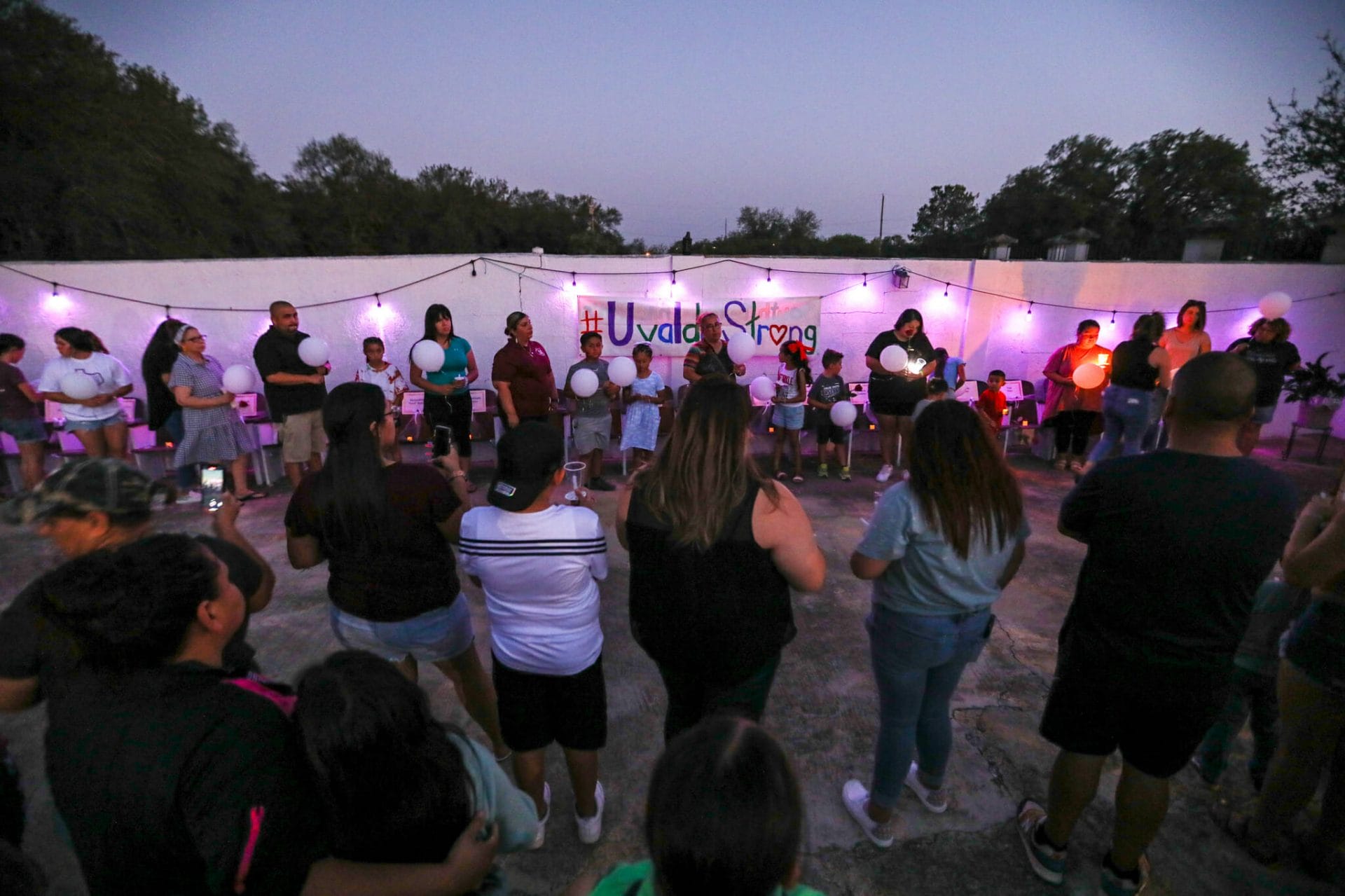
This is incredibly difficult work, but there are several important resources and experiences for Uvalde leaders and community members to draw upon as they work to improve healing. Ideally, this is work that is conducted with a full partnership between city leadership and the community. If Uvalde’s leaders are up to the challenge, a number of entities, including the Local and Regional Government Alliance on Race and Equity, have detailed guides available to help facilitate the creation of an effective Racial Equity Action Plan.206 No such plan has ever been put together for Uvalde, as far as our team is aware, and this would be a logical starting point.
Other Texas communities have engaged in similar work in recent years and provide a concrete roadmap of what this process can look like. On March 24, 2021, the Dallas City Council unanimously approved the city’s first-ever Racial Equity Resolution, which reaffirmed the city’s “commitment to work towards addressing the impact of institutional racism and creating a city where everyone can thrive.”207 This set the stage for the development and ongoing refinement of the comprehensive “Racial Equity Plan,” which was created in a collaboration between the city’s leadership and its residents. The end product of this collaborative process was the finalization of a Racial Equity Plan that included 200 concrete goals and recommendations that would affect decision-making across all government agencies from policing to parks.208 These goals received funding in the city budget and other forms of concrete support.
The National League of Cities’ Municipal Action Guide to Advancing Racial Equity in Your City calls on city leaders to make a public declaration in support of racial equity. “Your residents need to know your city’s commitment to racial equity,” states the guide.209 “As with instituting any citywide initiative, leaders can leverage the bully pulpit and media attention to make constituents aware of the city’s priorities and efforts. A public declaration is a bold stance that builds a connection between communities of color and governing bodies.” For leaders who may be new to this type of work, the National League of Cities offers training and support through its Race, Equity, and Leadership initiative.210
As an example of this kind of leadership in action, in June of 2020, Akron, Ohio, Mayor Dan Horrigan and City Council President Margo Sommerville declared racism to be a public health crisis with the support of the Akron City Council.211 As a direct result, the city created its first Racial Equity and Social Justice Taskforce. This group was “tasked with formulating meaningful recommendations of policy change to create a more racially equitable, socially just community and to bridge the racial wealth divide in the City of Akron.”212 After a 14-month period of research and community dialogue, the Racial Equity and Social Justice Taskforce formally presented its final recommendations to city leadership.
If Uvalde leadership can’t or won’t take up this work, then the pressure will need to come from Uvalde residents themselves, and several resources exist for communities looking to create grassroots-driven racial healing. For example, the Truth, Racial Healing & Transformation (TRHT) model is a comprehensive, multi-year national and community-based process to bring about transformational and sustainable change.213 TRHT provides a step-by-step process for community members to create a “clear and compelling vision” for achieving racial equity. To achieve that vision, “a set of ambitious but achievable goals, both long-term and short-term, is developed, and progress is regularly assessed.”214
Uvalde residents should know that it’s not uncommon for these kinds of efforts to start small. In Kalamazoo, Michigan, the original coalition committed to racial justice in the city started with just five partners. However, by the time the official visioning and planning process had started, more than 180 individuals and organizations were at the table. “Five years later, there are over 600 community partners engaged in the Kalamazoo TRHT, and the TRHT team is making plans for further engagement of people and groups that were not initially involved or only engaged on the periphery.”215 It may take time and patience, but there is a demand for racial justice work in most American communities. If you build it, they will come.
For a town with a history of protest of racial injustice, there is a rich tradition to draw upon. According to Peniel E. Joseph, Ph.D., the founder of the Center for the Study of Race and Democracy at the University of Texas at Austin, there is no shortage of local systems that need to be critically examined. “I think that you start by looking at criminal justice, you start looking at your zoning, your density policies, where are those equitable and where are they not equitable. Look at voting access. Look at health care and health-care access.”216
A lack of unity in the community after a mass shooting can worsen mental health outcomes and hinder the coordination of services when needed most.217 As one person we spoke to described the situation in Uvalde, “Nobody can be themselves anymore. People are not going out like they used to because they don’t know who they are going to see. People are on pins and needles.”218 By directly addressing the source of some of its most painful fault lines—including race and racism—the Uvalde community can enhance its ability to heal and move forward from this tragedy, together.
Reform Victim Compensation Systems
Many stakeholders interviewed for this project identified issues with the various forms of victim support and compensation provided through official government channels. For instance, Uvalde residents described a laborious process for applying for the state-funded Texas Crime Victims’ Compensation Program, operated by the Texas Attorney General’s Office. The administration of the state’s victims’ compensation system in Uvalde was “terrible,” said Brett Cross.219 “They put all this endless paperwork in front of you and forced you to have to keep writing the name of your dead child over and over. Then there were times when they were completely unresponsive to our questions. There has to be a way to consolidate the paperwork and to assign a case manager to help families to navigate this process.”
State Senator Roland Gutierrez, who represents Uvalde, and Uvalde Mayor McLaughlin also made public statements confirming that families of the Uvalde shooting victims were experiencing delays in getting compensation benefits from the state and that the compensation has been insufficient.220 State Senator Gutierrez and Mayor McLaughlin wrote a formal letter to the governor stating that one Uvalde family was at risk of having the power cut off in their home while their daughter was in the hospital. Other families were offered compensation of two weeks’ pay, which Gutierrez and McLaughlin called “meager.”
Criticism describing the system as slow and otherwise unresponsive have been borne out by publicly available data: As of November of 2022, roughly six months after the shooting, only $76,000 in total compensation had been reimbursed to a total of 332 eligible applicants in Uvalde—an average of just $228 per applicant, as victims that had suffered devastating losses and injuries were dealing with all related costs, from funeral expenses to lost wages to therapy and medical bills.221 State Senator Gutierrez received enough complaints from families about difficulties with the process that he introduced a bill this year to reform the victims’ compensation system in Texas. “You’re dealing with poor people here,” Gutierrez said to local media.222 “It shouldn’t have to be a situation where you’re out there demanding to get bills from people or to have people go through this paper, email process.”
Originally created in 1979, the Texas Crime Victims’ Compensation Program was designed to support victims of crime by providing financial support to individuals who have had their lives impacted by crime. However, despite its good intentions, the failings of the system highlighted by Uvalde’s experience underscore larger structural inadequacies that have existed for years and that should be addressed immediately by the Texas legislature and governor. This is not only a matter of fairness, as victims of crimes deserve the maximum support possible, but is also a critical way to address the impact of gun violence and facilitate healing at the individual and community levels. Providing support and services to victims is also an important way to reduce violence, since victims of violence are often at elevated risk of engaging in violence themselves absent any form of positive intervention and support.223
A months-long investigation into Texas’s victims’ compensation program by the local news station KXAN in 2022 found that “the basic functions of the Crime Victims’ Compensation division—from processing applications, to sending first payments, to answering victim phone calls—have slowed substantially over the past year.”224 The investigation revealed serious staffing issues, with a 32% vacancy rate as of last fall, and employees reporting that they were “struggling, overburdened and stressed by a toxic work environment.”225
A 2019 report by the Alliance for Safety and Justice, based on a statewide survey of thousands of crime survivors across Texas, revealed that victims face significant challenges with accessing compensation: “6 in 10 violent crime victims were unaware that the state of Texas offers victims compensation, and less than 1 out of 10 (9 percent) ever received it.”226 The findings of these reports and investigations, combined with the lived experience of the Uvalde community, all reflect the need for a deep examination and sweeping reforms to Texas’s system of victim compensation.
Two bills introduced in this year’s legislative session would make important changes to the victims’ compensation system. The first, HB 2877, introduced by Uvalde Representative Tracy King (State Senator Gutierrez introduced its Senate companion bill), would increase the extreme limits placed on compensation for bereavement leave and create an expedited process for responding to mass casualty emergency events.227
In addition, Senate Bill 49, introduced by Senator Judith Zaffirini, would expand eligibility to access to the Crime Victims’ Compensation Program—something that stakeholders in Uvalde identified as an issue since the majority of the families of victims are “nontraditional” families—and also increase payment caps to keep up with inflation.228 The compensation rates set by legislation in Texas have not been updated since 1997, and have fallen far, far behind inflation.
The above reforms have been supported in public comments by staff of the Attorney General Office’s Crime Victim Services Division, which oversees the victims’ compensation program. In an interview with local media, the division’s deputy chief called for the legislature to expand the definition of a member of a household and the limits on payments for a parent of a lost child, among other changes.229 For bereavement leave, an applicant can get “no more than $1,000, if you have lost a child, and that’s it.”230 When informed of this fact at a hearing regarding needed changes to the Victims’ Compensation program in Texas, State Rep. Nicole Collier, D-Fort Worth, who chairs the House Criminal Jurisprudence Committee, had a one word response: “Wow.”231
At that same hearing, many victim advocates “testified and voiced concerns about CVC payment delays and burdensome ‘red tape’ in the application process and rules.” There is a clear need for a simpler and more streamlined application process, a removal of certain compensation limits, and an expansion of access for those in non-traditional families, among other needed reforms. GIFFORDS calls on Texas leaders to continue their investigation into the staffing issues identified here and to create concrete recommendations for long-term solutions to ensure that crime victims are compensated fairly and swiftly in Texas, as they deserve. Recommendations should also be made about how the compensation process can be not only expedited, but also administered in a trauma-informed way that does not unnecessarily cause additional harm to victims who engage in the process.
Finally, it’s worth noting that SB 574, the School Violence Victims’ Compensation Act, authored by Senator Gutierrez, would create a permanent compensation fund for the victims of school gun violence and allow additional relief to reach Texas families impacted by school shootings.232 The bill funds this with a tax imposed on every retail sale of firearms and ammunition sold within the state of Texas. Given the state’s support for gun rights and aversion to taxes, this bill is unlikely to succeed, but it underscores the demand for an improved response for victims.
Texas leaders should make these reforms a top priority, for the victims in Uvalde and all across Texas.
Establish Trauma-Informed Schools
Schools are often regarded as the center of communities, giving them unique opportunities to address the impact of trauma on youth. Prioritizing school-based interventions can assist with tackling the many barriers that historically prevent youth from accessing mental health and other services,233 and they also provide a prime opportunity to identify high-risk youth that are at increased risk for experiencing trauma-related mental health symptoms.234 School-based mental health interventions can increase the availability of peer and adult support, both of which are associated with increased resilience and perception of safety at school, as well as improved academic performance.235
One strategy is to educate parents on the current availability of resources for their children and the process to access these resources. One Uvalde parent mentioned during a focus group that having an Individualized Education Program (IEP) for her daughter has helped her navigate her return back to school while managing her trauma-related symptoms.236
Individualized Education Programs are legal documents developed by families, teachers, and school administrators to ensure students with disabilities can fully access their K–12 academic curriculum.237 Not all surviving students would qualify for an IEP. But from a trauma-informed lens, when families are connected to their schools and knowledgeable of the available resources, this can increase their sense of safety, trust, and empowerment while improving student academic outcomes.238 However, not all parents we spoke with knew about IEPs or how to access them.
In addition, it will be critical to provide ongoing training for Uvalde school staff on mental health awareness and the impact of trauma, which will help with identifying youth most in need of mental health services.239 Educators are positioned to identify mental health concerns for students due to their proximity and ability to observe their behavior in a variety of contexts, but they often receive minimal training and education on how to identify and manage mental health symptoms in classrooms.
Several community members interviewed for this project identified this as a gap in Uvalde. And since the behavioral consequences of trauma can manifest differently at various points in the student’s academic career, educators can misclassify a student as “problematic,” and redirect them to exclusionary disciplinary practices (i.e., suspension and expulsion) rather than identifying them as a survivor of trauma in need of mental health services.240 However, when teachers receive trauma-informed training they can develop greater self-efficacy in managing trauma-related symptoms of their students.241
Therefore, training Uvalde’s teachers on how to identify trauma-related symptoms and minimize these responses can contribute to a safe and supportive academic environment. Additionally, training diverse stakeholders such as educators and other community leaders can create a shared language on “trauma-informed practices,” and reinforce community collaboration to facilitate the healing from trauma.242
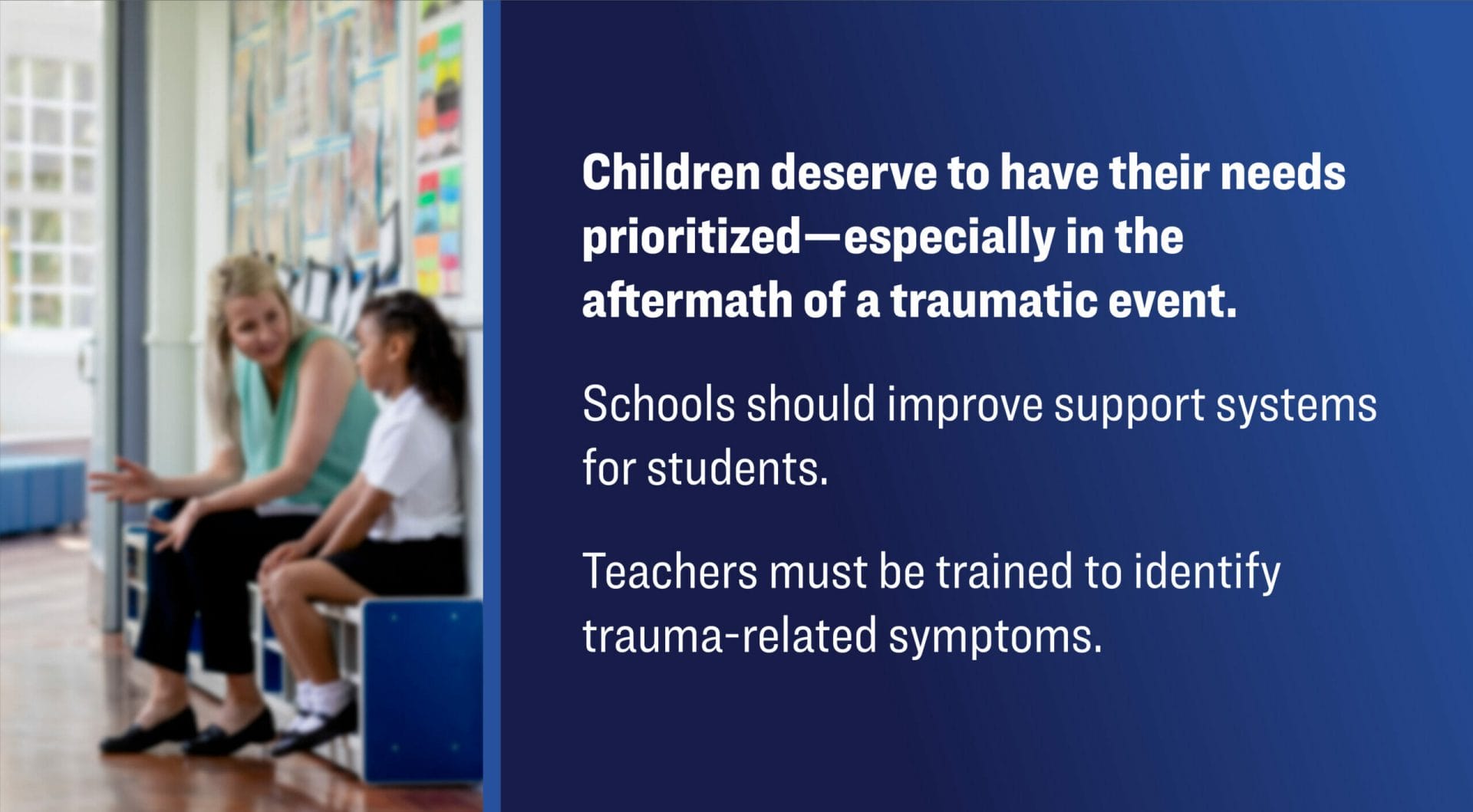
It will also be of utmost importance to provide services to address the long-term impact of trauma on the school staff who are working closely with the students. In general, educators often play multiple roles, especially in under-resourced schools, and are at a high risk of experiencing poor well-being.243 If school districts do not adequately address this, it can increase their likelihood to leave the field, which can in turn negatively impact children’s learning outcomes.244 Therefore, school systems must identify strategies—like establishing a written plan on how the school plans to provide services in the aftermath of a school shooting245—to provide mental health and professional support for teachers.
Collaboration Between the School, Community Leaders, and Government Officials to Address and Provide Supportive Services in Schools
Due to limited access to mental health care in rural environments, schools can be an important way for you to receive mental health services. However, if stakeholders are not effective in coordinating services and creating appropriate systems of care, students are at an increased risk for poor outcomes.246 The lack of coordination between stakeholders is a recurring theme in gun violence prevention and can hinder effective efforts.247 Improving coordination between stakeholders, developing specific goals of partnerships, and identifying a “point person” is a best practice to reduce gun-related violence.248
Additionally, coordination between stakeholders and equitable inclusion of parents, children, and other community members can rebuild trust between community members and government institutions. During several interviews for this project, parents mentioned how the local schools ran active lockdown drills on the first day back to school following the shooting, which triggered many of the students. One parent expressed with frustration that “The school district does lockdown drills. They started notifying parents at first, but now they don’t. They just do them and it is triggering for kids.”249 Several parents expressed frustration with the lack of communication between the school and parents, which would have helped them to prepare their children for a difficult experience.
This lack of coordination and collaboration with parents negatively contributed to feelings of distrust between the parents and the school. One parent expressed their frustration with the school’s lack of communication and collaboration with the parents: “Instead of asking [parents] what can be done, we were seen as troublemakers.”
Collaboration is one of the tenets of trauma-informed practices and a strategy for trauma-informed healing. One strategy to promote equitable collaboration is by providing opportunities for community members to make decisions on government priorities such as community advisory boards and providing opportunities to be involved with participatory budgeting. However, many parents expressed that they have been largely excluded from participating in the decision-making process.
One parent mentioned how parents have not been involved in the committee to build the new elementary school. Several interviewees indicated that the school safety plans that have been made publicly available in the aftermath of the shooting were put together without their knowledge or participation. One parent stated, “Uvalde needs inclusion moving forward.” Government leaders must actively seek family involvement to rebuild trust with the community. Increasing access and opportunities for community members’ civic engagement is associated with improved feelings of government transparency.250
By increasing coordination and communication with families, increasing access to Individualized Education Plans for students who are struggling, and providing ongoing mental health training and support to teachers and all staff, Uvalde’s school system can help to fill several of the key gaps in services and supports identified by Uvalde residents.
GET THE FACTS
Gun violence is a complex problem, and while there’s no one-size-fits-all solution, we must act. Our reports bring you the latest cutting-edge research and analysis about strategies to end our country’s gun violence crisis at every level.
Learn More
With nearly 43,000 gun deaths and tens of thousands more non-fatal shootings every single year, America is rapidly becoming a nation of survivors. Like our founder, Gabby Giffords—and like far too many other Americans over the last few decades—the people of Uvalde find themselves struggling to put their lives back together. For the friends and families of the 21 people whose lives were lost, a void was ripped open that can never be truly filled.
Yet, like the survivors in Uvalde and around the nation, we refuse to give up hope. Americans don’t have to live like this, and our leaders have an obligation to not just take the necessary steps to end gun violence, but also to provide healing and support to all those individuals and families who have been unnecessarily shattered along the way.
It will take each of us, leaning on each other in our most difficult moments to make this happen. All of us at GIFFORDS are committed to standing shoulder to shoulder with those who know the true cost of gun violence and who want to save their fellow Americans from knowing that same pain. Political differences are real, and we respect various points of view, but what we know now is that any policy or position that furthers inaction is firmly on the wrong side of history.
It’s our sincere hope that reports like this will help lead the way to thoughtful, meaningful action. But this is just a starting point, not the finish line. Our commitment is to the people of Uvalde, who we will work with to make these goals a reality. With our policy and advocacy expertise, through the support of our litigation team and our vast network of pro bono lawyers, alongside our connections to funders and donors nationwide who want to help communities like Uvalde, and with our network of everyday Americans who are sick and tired of the status quo and ready to lend a hand—we are in this fight with you every step of the way.
As long as we are welcome, we will work with the people of Uvalde to bring about the changes that they deserve—the changes that will honor those that were lost. We thank all the members of the Uvalde community who opened their hearts and their homes to our team and we look forward to working with you in the months and years to come.
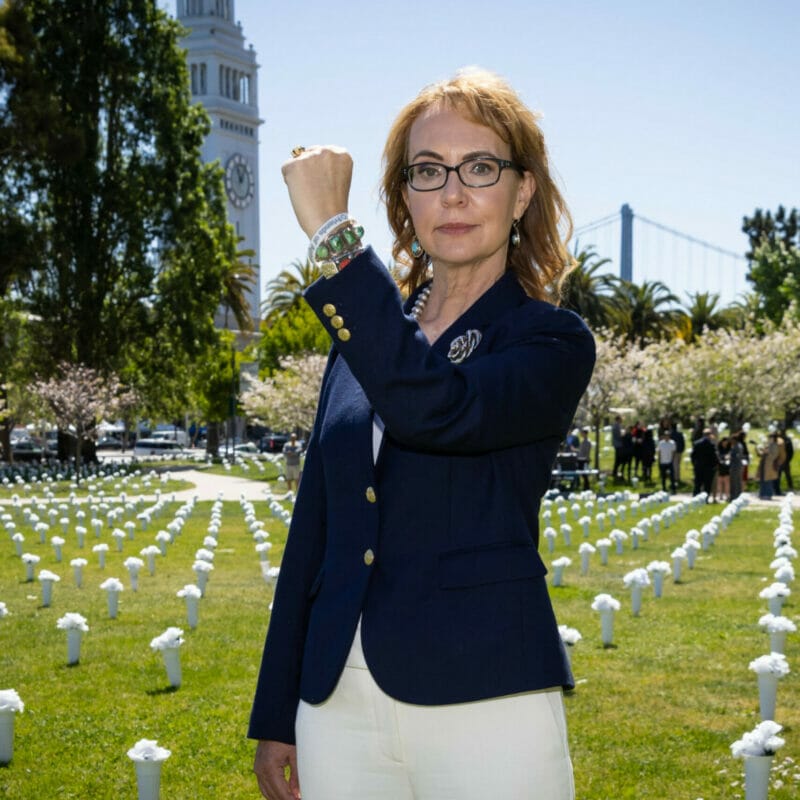
REPORT
10 YEARS of COURAGE
Since founding Giffords in the wake of the Sandy Hook shooting, we’ve helped pass a remarkable 525 significant gun safety laws in 49 states.
Learn More- Reese Oxner, “Uvalde gunman legally bought AR rifles days before shooting, law enforcement says,” Texas Tribune, May 25, 2022, https://www.texastribune.org/2022/05/25/uvalde-shooter-bought-gun-legally.[↩]
- Mike Baker and Dana Goldstein, “Uvalde Had Prepared for School Shootings. It Did Not Stop the Rampage,” New York Times, May 26, 2022, https://www.nytimes.com/2022/05/26/us/mass-shooting-school-security.html.[↩]
- Representative Dustin Burrows, Representative Joe Moody, and Eva Guzman, “House Investigative Committee on the Robb Elementary Shooting, Texas House Of Representatives Interim Report 2022,” Texas House of Representatives, July 17, 2022, https://house.texas.gov/_media/pdf/committees/reports/87interim/Robb-Elementary-Investigative-Committee-Report.pdf.[↩]
- Kate McGee and Jolie McCullough, “Confronted with mass shootings, Texas Republicans have repeatedly loosened gun laws,” Texas Tribune, May 24, 2022, https://www.texastribune.org/2022/05/24/texas-gun-laws-uvalde-mass-shootings.[↩]
- Nadine Yousif, “Why number of US mass shootings has risen sharply,” BBC, March 28, 2023, https://www.bbc.com/news/world-us-canada-64377360.[↩]
- “About Dr. Wood,” Tonya Wood, last accessed March 8, 2023, https://tonyawood.com/about-dr-wood.[↩]
- “Uvalde Region Mental Health Needs Assessment,” Meadows Mental Health Policy Institute and Hill Country Mental Health and Developmental Disabilities Centers, December 20, 2022, https://www.hillcountry.org/wp-content/uploads/2023/03/Uvalde-Region-Mental-Health-Needs-Assessment-2022.121.pdf.[↩]
- “Robb Elementary School and Uvalde’s History of Mexican-American Activism,” NPR, June 2, 2022, https://www.npr.org/2022/06/01/1102489019/robb-elementary-school-and-uvaldes-history-of-mexican-american-activism.[↩]
- Uriel J. Garcia and Jinitzail Hernandez, “Before the school shooting, Uvalde was known for a 1970 Hispanic student walkout. Its aging participants fear its spirit and memory are fading,” Texas Tribune, June 22, 2022, https://www.texastribune.org/2022/06/22/uvalde-school-boycott-walkout-shooting-robb-elementary.[↩]
- Neil Meyer, “Opinion: I’m from Uvalde. I’m not surprised this happened,” Washington Post, May 29, 2022, https://www.washingtonpost.com/opinions/2022/05/29/uvalde-shooting-warning-signs-racism-poverty-guns.[↩]
- Interview with Uvalde community members, March 12, 2023.[↩]
- Civil Rights in Black and Brown Interview Database, Texas Christian University, “Munoz / Memories of Discrimination or Segregation Growing up in Uvalde,” July 8, 2016, https://crbb.tcu.edu/clips/4389/memories-of-discrimination-or-segregation-growing-up-in-uvalde.[↩]
- “Trauma and Violence,” Substance Abuse and Mental Health Services Administration, last updated September 27, 2022, https://www.samhsa.gov/trauma-violence.[↩]
- “Trauma,” Centre for Addiction and Mental Health, last accessed March 8, 2023, https://www.camh.ca/en/health-info/mental-illness-and-addiction-index/trauma#:~:text=Trauma%20is%20the%20lasting%20emotional,regulate%20emotions%20and%20navigate%20relationships.[↩]
- John Gramlich, “What the data says about gun deaths in the U.S.,” Pew Research Center, April 26, 2023, https://www.pewresearch.org/fact-tank/2022/02/03/what-the-data-says-about-gun-deaths-in-the-u-s/.[↩]
- Leigh Kimberg and Margaret Wheeler, “Trauma and Trauma-Informed Care,” in Trauma-Informed Healthcare Approaches: A Guide for Primary Care, ed. Megan R. Gerber (Springer Cham, 2019), 25–56.[↩]
- “Infographic: 6 Guiding Principles To A Trauma-Informed Approach,” Centers for Disease Control and Prevention, last reviewed September 17, 2020, https://www.cdc.gov/orr/infographics/6_principles_trauma_info.htm.[↩]
- “Uvalde Region Mental Health Needs Assessment,” Meadows Mental Health Policy Institute and Hill Country Mental Health and Developmental Disabilities Centers, December 20, 2022, https://www.hillcountry.org/wp-content/uploads/2023/03/Uvalde-Region-Mental-Health-Needs-Assessment-2022.121.pdf.[↩]
- Interview with Uvalde community members, March 12, 2023.[↩]
- Interview with Brenda Faulkner (director of programs for the Children’s Bereavement Center), March 31, 2023.[↩]
- Tori DeAngelis, “Treating trauma in the aftermath of the Uvalde school shooting,” American Psychological Association 53, no. 6, (July 2022): 26, https://www.apa.org/monitor/2022/09/news-treating-trauma-uvalde.[↩]
- “Uvalde Region Mental Health Needs Assessment,” Meadows Mental Health Policy Institute and Hill Country Mental Health and Developmental Disabilities Centers, December 20, 2022, https://www.hillcountry.org/wp-content/uploads/2023/03/Uvalde-Region-Mental-Health-Needs-Assessment-2022.121.pdf.[↩]
- Id.[↩]
- Julianne Holt-Lunstad, Theodore Robles, and David A. Sbarra, “Advancing Social Connection as a Public Health Priority in the United States,” American Psychologist 72, no. 6 (September 2017): 517–530, doi: 10.1037/amp0000103, https://www.ncbi.nlm.nih.gov/pmc/articles/PMC5598785/.[↩]
- Jacob Blackstock et al., “Achieving Access to Mental Health Care for School-Aged Children in Rural Communities,” The Rural Educator 39, no. 1 (2018): 12–25, https://doi.org/10.35608/ruraled.v39i1.212.[↩]
- Focus group interview with Uvalde community members, March 12, 2023.[↩]
- Focus group interview with Uvalde community members, March 13, 2023.[↩]
- SAMHSA’s Trauma and Justice Strategic Initiative, “SAMHSA’s Concept of Trauma and Guidance for as Trauma-Informed Approach,” Substance Abuse and Mental Health Services Administration, July 2014, https://ncsacw.acf.hhs.gov/userfiles/files/SAMHSA_Trauma.pdf.[↩]
- Crystal L. Park, “Spiritual well-being after trauma: Correlates with appraisals, coping, and psychological adjustment,” Journal of Prevention and Intervention in the Community 45, no. 4 (2017): 297–307, doi: 10.1080/10852352.2016.1197752, https://pubmed.ncbi.nlm.nih.gov/28880812/.[↩]
- Janell Ross, “‘It’s Too Late for Prayer.’ Uvalde’s Faith Leaders Are Called Upon to Help a Community Face the Unimaginable,” Time, May 27, 2022, https://time.com/6182346/uvalde-shooting-religious-faith/.[↩]
- Jose Parappully et al., “Thriving after Trauma: The Experience of Parents of Murdered Children,” Journal of Humanistic Psychology 42, no. 1 (2002): 33–70, https://doi.org/10.1177/0022167802421003.[↩]
- James M Shultz et al., “Multiple vantage points on the mental health effects of mass shootings,” Current Psychiatry Reports 16, no. 9 (2014), doi: 10.1007/s11920-014-0469-5.[↩]
- Interview with Uvalde community members, October 10, 2022.[↩]
- Interview with Uvalde community members, October 9, 2022.[↩]
- Addie Weaver et al., “Rural Residents’ Depressive Symptoms and Help-Seeking Preferences: Opportunities for Church-Based Intervention Development,” Journal of Religion and Health 58, no. 5 (2019): 1661–1671, https://doi.org/10.1007/s10943-019-00807-9.[↩]
- Magdaleno Leno Rose-Avila, “I Promised My Daughter: Cazares’ Race for Uvalde County Commissioner,” The Mercedes Enterprise, October 27, 2022, https://www.themercedesenterprise.com/2022/10/27/i-promised-my-daughter-cazares-race-for-uvalde-county-commissioner/.[↩]
- Bryana H. French et al., “Toward a Psychological Framework of Radical Healing in Communities of Color,” The Counseling Psychologist 48, no. 1 (2019): 14–46, https://doi.org/10.1177/001100001984350.[↩]
- Interview with Brett Cross (parent of Robb Elementary school shooting victim), March 12, 2023.[↩]
- SAMHSA’s Trauma and Justice Strategic Initiative, “SAMHSA’s Concept of Trauma and Guidance for as Trauma-Informed Approach,” Substance Abuse and Mental Health Services Administration, July 2014, https://ncsacw.acf.hhs.gov/userfiles/files/SAMHSA_Trauma.pdf.[↩]
- Rick Rojas and Edgar Sandoval, “The Excruciating Echo of Grief in Uvalde,” New York Times, August 6, 2022, https://www.nytimes.com/interactive/2022/08/06/us/uvalde-funerals.html?action=click&pgtype=Article&state=default&module=styln-texas-school-shooting&variant=show®ion=BELOW_MAIN_CONTENT&block=storyline_flex_guide_recirc; Sig Christenson, “’They don’t care about us’: Uvalde students leave school in walkout over gun safety,” San Antonio Express-News, April 5, 2023, https://www.expressnews.com/news/article/uvalde-walkout-17878775.php.[↩]
- GIFFORDS Law Center, “From Healing to Action: A Toolkit for Gun Violence Survivors and Allies,” February 3, 2022, https://giffords.org/toolkit/from-healing-to-action-a-toolkit-for-gun-violence-survivors-and-allies; See also Kimberly Reeves, “Mass shootings spur youth activism to end gun violence,” Spectrum News 1, March 14, 2023, https://spectrumlocalnews.com/tx/south-texas-el-paso/news/2023/03/14/mass-shootings-spawn-activism-to-end-gun-violence.[↩]
- Asif Wilson and Wytress Richardson, “All I Want to Say Is That They Don’t Really Care About Us: Creating and Maintaining Healing-Centered Collective Care in Hostile Times,” Occasional Paper Series, no. 43 (2020): https://doi.org/10.58295/2375-3668.1342.[↩]
- Shawn Ginwright, “The Future of Healing: Shifting From Trauma Informed Care to Healing Centered Engagement,” Medium, May 31, 2018, https://medium.com/@ginwright/the-future-of-healingshifting-from-trauma-informed-care-to-healing-centered-engagement-634f557ce69c.[↩]
- Uriel J. Garcia and Jinitzail Hernandez, “Before the school shooting, Uvalde was known for a 1970 Hispanic student walkout. Its aging participants fear its spirit and memory are fading,” Texas Tribune, June 22, 2022, https://www.texastribune.org/2022/06/22/uvalde-school-boycott-walkout-shooting-robb-elementary.[↩]
- Myra Soto-Aponte, “Crosswalk: Youth Thrive & Healing Centered Engagement Crosswalk: A Focus on Building Young People’s Strengths and Healing,” Center for the Study of Social Policy, May 2021, https://CSSP.org/resource/crosswalk-youth-thrive-healing-centered-engagement.[↩]
- Marguerite E. O’Haire, Noémie A. Guérin, and Alison C. Kirkham, “Animal-Assisted Intervention for trauma: a systematic literature review,” Frontiers in Psychology, no. 6 (2015): https://www.ncbi.nlm.nih.gov/pmc/articles/PMC4528099/.[↩]
- SAMHSA’s Trauma and Justice Strategic Initiative, “SAMHSA’s Concept of Trauma and Guidance for as Trauma-Informed Approach,” Substance Abuse and Mental Health Services Administration, July 2014, https://ncsacw.acf.hhs.gov/userfiles/files/SAMHSA_Trauma.pdf.[↩]
- Leslie G. Eaton, Kimberly L. Doherty, and Rebekah M. Widrick, “A review of research and methods used to establish art therapy as an effective treatment method for traumatized children,” The Arts in Psychotherapy 34, no. 3 (2007): 256–262, https://www.sciencedirect.com/science/article/abs/pii/S0197455607000287.[↩]
- Hannah Ortega, “How the Uvalde Love Project is using art, group therapy for healing after school shooting,” Austin American-Statesman, March 28, 2023, https://www.statesman.com/story/entertainment/arts/2023/03/28/uvalde-love-project-art-group-therapy-healing-school-shooting/69924274007/.[↩]
- Anthony Sabella, “Local nonprofit takes “Camp Healing” to children in Uvalde,” WTKR, last updated August 14, 2022, https://www.wtkr.com/news/local-nonprofit-takes-camp-healing-to-children-in-uvalde.[↩]
- See, e.g., 9NEWS, “Racial equity expert discusses relationship between community, police in Uvalde,” YouTube video, June 16, 2022, https://www.youtube.com/watch?v=pPAciuhaQEk.[↩]
- Kristen Cabrera and Shelly Brisbin, “How a school walkout in Uvalde helped spark the 1970s Chicano rights movement,” Texas Standard, May 31, 2022, https://www.texasstandard.org/stories/how-a-school-walkout-in-uvalde-helped-spark-the-1970s-chicano-rights-movement.[↩]
- Taylor Gantt, “Josué ‘George’ Garza,” Voces Oral History Center, University of Texas at Austin, April 9, 2016, https://voces.lib.utexas.edu/collections/stories/josu%C3%A9-george-garza#:~:text=These%20days%2C%20Garza%20downplays%20his,those%20coming%20back%20from%20Vietnam.[↩]
- Camilo Pérez-Bustillo, “Uvalde Students Fought for Desegregation in 1970s. Now Let’s Rise Up for Them,” Truthout, June 1, 2022, https://truthout.org/articles/uvalde-students-fought-for-desegregation-in-1970s-now-lets-rise-up-for-them/.[↩]
- Uriel J. Garcia and Jinitzail Hernandez, “Before the school shooting, Uvalde was known for a 1970 Hispanic student walkout. Its aging participants fear its spirit and memory are fading,” Texas Tribune, June 22, 2022, https://www.texastribune.org/2022/06/22/uvalde-school-boycott-walkout-shooting-robb-elementary.[↩]
- Interview with Reverend Mike Marsh (St Philip’s Episcopal Church), October 10, 2022.[↩]
- Interview with Brett Cross (parent of Robb Elementary school shooting victim), March 12, 2023.[↩]
- Camilo Pérez-Bustillo, “Uvalde Students Fought for Desegregation in 1970s. Now Let’s Rise Up for Them,” Truthout, June 1, 2022, https://truthout.org/articles/uvalde-students-fought-for-desegregation-in-1970s-now-lets-rise-up-for-them.[↩]
- Uriel J. Garcia and Jinitzail Hernandez, “Before the school shooting, Uvalde was known for a 1970 Hispanic student walkout. Its aging participants fear its spirit and memory are fading,” Texas Tribune, June 22, 2022, https://www.texastribune.org/2022/06/22/uvalde-school-boycott-walkout-shooting-robb-elementary.[↩]
- Emily R Dworkin, Charlotte D Brill, and Sarah E Ullman, “Social reactions to disclosure of interpersonal violence and psychopathology: A systematic review and meta-analysis,” Clinical Psychology Review 72, (August 2019): 101750, https://doi.org/10.1016/j.cpr.2019.101750.[↩]
- Daniel Kim, “Social determinants of health in relation to firearm-related homicides in the United States: A nationwide multilevel cross-sectional study,” PLoS Medicine 16, no. 12 (December 2019): e1002978, doi: 10.1371/journal.pmed.1002978, https://pubmed.ncbi.nlm.nih.gov/31846474/.[↩]
- SAMHSA’s Trauma and Justice Strategic Initiative, “SAMHSA’s Concept of Trauma and Guidance for as Trauma-Informed Approach,” Substance Abuse and Mental Health Services Administration, July 2014, https://ncsacw.acf.hhs.gov/userfiles/files/SAMHSA_Trauma.pdf.[↩]
- “Trauma,” Administration for Children and Families, last accessed March 8, 2023, https://www.acf.hhs.gov/trauma-toolkit/trauma-concept.[↩]
- Interview with Brett Cross (parent of Robb Elementary school shooting victim), March 12, 2023.[↩]
- Focus group interview with Uvalde community members, March 12, 2023.[↩]
- Interview with Brett Cross (parent of Robb Elementary school shooting victim), March 12, 2023.[↩]
- Kate Holland et al., “Texas governor’s much-touted mental health care expansion falls short of local, state need,” ABC News, November 6, 2022, https://abcnews.go.com/Politics/texas-governors-touted-mental-health-care-expansion-falls/story?id=92686446.[↩]
- Diane K. Yatchmenoff, Stephanie A. Sundborg, and Mildred A. Davis, “Implementing Trauma-Informed Care: Recommendations on the Process,” Advances in Social Work 18, no. 1 (2017): 167–185, https://doi.org/10.18060/21311, https://advancesinsocialwork.iupui.edu/index.php/advancesinsocialwork/article/view/21311.[↩]
- Sarah R. Lowe and Sandro Galea, “The Mental Health Consequences of Mass Shootings,” Trauma, Violence, & Abuse 18, no. 1 (2017): 62–82, https://www.cmhnetwork.org/wp-content/uploads/2018/09/The-Mental-Health-Consequences-of-Mass-Shootings.pdf.[↩]
- Claudia P Orlas et al., “Long-term Outcomes of Firearm Injury Survivors in the United States: The National Trauma Research Action Plan Scoping Review,” Annals of Surgery 274, no. 6 (December 2021): 962–970, https://pubmed.ncbi.nlm.nih.gov/34784664/.[↩]
- Haeven Gibbons, “What a Sandy Hook mental health center can teach Texas about helping kids after a tragedy,” Dallas Morning News, August 4, 2022, https://www.dallasnews.com/news/education/2022/08/04/what-a-sandy-hook-mental-health-center-can-teach-texas-about-helping-kids-after-a-tragedy/.[↩]
- Bonnie Petrie, “Uvalde prompted Texas to start taking mental health funding for schools seriously. Is it enough?” Texas Public Radio, September 27, 2022, https://www.tpr.org/bioscience-medicine/2022-09-27/uvalde-prompted-texas-to-start-taking-mental-health-funding-for-schools-seriously-is-it-enough.[↩]
- Dawn A. Morales, Crystal L. Barksdale, and Andrea C. Beckel-Mitchener, “A call to action to address rural mental health disparities,” Journal of Clinical and Translational Science 4, no. 5 (2020): 463–467, doi: 10.1017/cts.2020.42, https://www.ncbi.nlm.nih.gov/pmc/articles/PMC7681156/.[↩]
- Bonnie Petrie, “Uvalde prompted Texas to start taking mental health funding for schools seriously. Is it enough?” Texas Public Radio, September 27, 2022, https://www.tpr.org/bioscience-medicine/2022-09-27/uvalde-prompted-texas-to-start-taking-mental-health-funding-for-schools-seriously-is-it-enough.[↩]
- Natalie Cheesmond, Kate Davies, and Kerry Inder, “Exploring the role of rurality and rural identity in mental health help-seeking behavior: a systematic qualitative review,” Journal of Rural Mental Health 43, no. 1 (2019): 45–59, https://doi.org/10.1037/rmh0000109.[↩]
- C Holly A Andrilla et al., “Geographic Variation in the Supply of Selected Behavioral Health Providers,” American Journal of Preventive Medicine 54, no. 6 (June 2018): S199–S207, doi: 10.1016/j.amepre.2018.01.004, https://pubmed.ncbi.nlm.nih.gov/29779543/.[↩]
- “Adults with Ami Who Are Uninsured 2022,” Mental Health America, last accessed March 8, 2023, https://mhanational.org/issues/2022/mental-health-america-access-care-data#five.[↩]
- Id.[↩]
- Kirsty J Weitzel et al., “The Use of Crisis Services Following the Mass School Shooting in Uvalde, Texas: Quasi-Experimental Event Study,” JMIR Public Health and Surveillance 9, (2023): e42811, https://doi.org/10.2196/42811.[↩]
- Office of the Texas Governor, “Governor Abbott Announces $5 Million Investment To Establish Long-Term Family Resiliency Center In Uvalde County,” news release, June 1, 2022, https://gov.texas.gov/news/post/governor-abbott-announces-5-million-investment-to-establish-long-term-family-resiliency-center-in-uvalde-county.[↩]
- Kate Holland et al., “Texas governor’s much-touted mental health care expansion falls short of local, state need,” ABC News, November 6, 2022, https://abcnews.go.com/Politics/texas-governors-touted-mental-health-care-expansion-falls/story?id=92686446.[↩]
- Nicholas C Coombs et al., “Barriers to healthcare access among U.S. adults with mental health challenges: A population-based study,” SSM – Population Health 15, (June 2021): 100847, https://doi.org/10.1016/j.ssmph.2021.100847.[↩]
- SAMHSA’s Trauma and Justice Strategic Initiative, “SAMHSA’s Concept of Trauma and Guidance for as Trauma-Informed Approach,” Substance Abuse and Mental Health Services Administration, July 2014, https://ncsacw.acf.hhs.gov/userfiles/files/SAMHSA_Trauma.pdf.[↩]
- Id.[↩]
- Kate Holland et al., “Texas governor’s much-touted mental health care expansion falls short of local, state need,” ABC News, November 6, 2022, https://abcnews.go.com/Politics/texas-governors-touted-mental-health-care-expansion-falls/story?id=92686446.[↩]
- Interview with Uvalde community members, March 12, 2023.[↩]
- Id.[↩]
- National Child Traumatic Stress Network and National Center for PTSD, “Psychological First Aid: Field Operations Guide,” 2006, https://www.ptsd.va.gov/professional/treat/type/PFA/PFA_V2.pdf.[↩]
- Satu Larson et al., “Chronic Childhood Trauma, Mental Health, Academic Achievement, and School-Based Health Center Mental Health Services,” Journal of School Health 87, no. 9 (September 2017): 675–686, doi: 10.1111/josh.12541, https://pubmed.ncbi.nlm.nih.gov/28766317/.[↩]
- Jacob Blackstock et al., “Achieving Access to Mental Health Care for School-Aged Children in Rural Communities,” The Rural Educator 39, no. 1 (2018): 12–25, https://doi.org/10.35608/ruraled.v39i1.212.[↩]
- Anne Dunkelberg, “2021 Census Data Provides Insight into the Uninsured Population of Texas,” Every Texan, October 28, 2022, https://everytexan.org/2022/10/28/2021-census-data-provides-insight-into-the-uninsured-population-of-texas.[↩]
- “Adults with AMI Who Are Uninsured 2022,” Mental Health America, last accessed March 8, 2023, https://mhanational.org/issues/2022/mental-health-america-access-care-data#five.[↩]
- “QuickFacts: Uvalde city, Texas,” United States Census Bureau, last accessed March 8, 2023, https://www.census.gov/quickfacts/fact/table/uvaldecitytexas/HEA775221#HEA775221.[↩]
- Jennifer Greif Green et al., “Barriers to Mental Health Service Use and Predictors of Treatment Drop Out: Racial/Ethnic Variation in a Population‑Based Study,” Administration and Policy in Mental Health and Mental Health Services Research 47, no. 6 (July 2020): 606–616, doi: 10.1007/s10488-020-01021-6., https://pubmed.ncbi.nlm.nih.gov/32076886/.[↩]
- Heather A Turner et al., “Gun Violence Exposure and Posttraumatic Symptoms Among Children and Youth,” Journal of Traumatic Stress 32, no. 6 (December 2019): 881–889, doi: 10.1002/jts.22466, https://pubmed.ncbi.nlm.nih.gov/31833114/.[↩]
- “QuickFacts: Uvalde city, Texas,” United States Census Bureau, last accessed March 8, 2023, https://www.census.gov/quickfacts/uvaldecountytexas; urnal of Racial and Ethnic Health Disparities 6, no. 6 (December 2019): 1122–1130, doi: 10.1007/s40615-019-00614-8, https://pubmed.ncbi.nlm.nih.gov/31327136/.[↩]
- Allison Jordan, “Gun Violence Has a Devastating Impact on Hispanic Communities,” Center for American Progress, November 1, 2022, https://www.americanprogress.org/article/gun-violence-has-a-devastating-impact-on-hispanic-communities.[↩]
- “Barriers to Mental Health Treatment in Rural Areas,” Rural Health Information Hub, last accessed March 8, 2023, https://www.ruralhealthinfo.org/toolkits/mental-health/1/barriers.[↩]
- Supriya Misra et al., “Systematic Review of Cultural Aspects of Stigma and Mental Illness among Racial and Ethnic Minority Groups in the United States: Implications for Interventions,” American Journal of Community Psychology 68, no. 3–4 (December 2021): 486–512, doi: 10.1002/ajcp.12516, https://pubmed.ncbi.nlm.nih.gov/33811676/.[↩]
- Interview with Uvalde community members, October 9, 2022.[↩]
- Abigail A. Fagan and Richard F. Catalano, “What Works in Youth Violence Prevention: A Review of the Literature,” Research on Social Work Practice 23, no. 2 (November 2012): 141–156, https://doi.org/10.1177/104973151246589.[↩]
- Kristen Yule, Jessica Houston, John Grych, “Resilience in Children Exposed to Violence: A Meta-analysis of Protective Factors Across Ecological Contexts,” Clinical Child and Family Psychology Review 22, no. 3 (September 2019): 406–431, DOI: 10.1007/s10567-019-00293-1, https://pubmed.ncbi.nlm.nih.gov/30887404/.[↩]
- Centene Corporation, “Centene Corporation Invests $7.9 Million in Uvalde Community Center,” news release, December 5, 2022, https://investors.centene.com/2022-12-05-CENTENE-CORPORATION-INVESTS-7-9-MILLION-IN-UVALDE-COMMUNITY-CENTER.[↩]
- Interview with Uvalde community members, October 9, 2022.[↩]
- Brian M. Iacoviello and Dennis S. Charney, “Psychosocial facets of resilience: implications for preventing post trauma psychopathology, treating trauma survivors, and enhancing community resilience,” European Journal of Psychotraumatology 5, no. 1 (2014): 23970, doi: 10.3402/ejpt.v5.23970, https://www.ncbi.nlm.nih.gov/pmc/articles/PMC4185137/.[↩]
- Charles C Branas et al., “Citywide cluster randomized trial to restore blighted vacant land and its effects on violence, crime, and fear,” Proceedings of the National Academy of Sciences 115, no. 12 (March 2018): 2946–2951, DOI: 10.1073/pnas.1718503115, https://pubmed.ncbi.nlm.nih.gov/29483246/.[↩]
- Justin E Heinze et al., “Busy Streets Theory: The Effects of Community-engaged Greening on Violence,” American Journal of Community Psychology 62, no. 1–2 (2018): 101–109, doi: 10.1002/ajcp.12270, https://pubmed.ncbi.nlm.nih.gov/30216464/.[↩]
- Chris Gilligan and Sharon Lurye, “States With the Most School Shootings,” US News and World Report, March 31, 2023, https://www.usnews.com/news/best-states/articles/2022-05-27/states-with-the-most-school-shootings.[↩]
- “Annual Gun Law Scorecard: Texas,” GIFFORDS Law Center, March 2023, https://giffords.org/lawcenter/resources/scorecard/?scorecard=TX.[↩]
- “Gun Violence in Texas,” Everytown for Gun Safety, last updated July 2022, https://everystat.org/wp-content/uploads/2019/10/Gun-Violence-in-Texas-1.pdf.[↩]
- Jessica Priest and Perla Trevizo, “Despite Decades of Mass Shootings in Texas, Legislators Have Failed to Pass Meaningful Gun Control Laws,” ProPublica, last updated May 8, 2023, https://www.propublica.org/article/mass-shootings-texas-gun-control.[↩]
- Interview with Jocelyn Vianney Flores and her husband, October 9, 2022; Interview with Paul and Adelle, October 10, 2022.[↩]
- Chloe Folmar, “Uvalde parents to join gun control protest in Austin,” The Hill, August 26, 2022, https://thehill.com/homenews/state-watch/3617286-uvalde-parents-to-join-gun-control-protest-in-austin.[↩]
- Elizabeth R. Sowell et al., “In Vivo Evidence for Post-adolescent Brain Maturation in Frontal and Striatal Regions,” Nature Neuroscience 2, no. 10 (1999): 859–861, https://doi.org/10.1038/13154; Tulio M. Otero and Lauren A. Barker, “The Frontal Lobes and Executive Functioning,” Handbook of Executive Functioning (September 2014): 29–44, DOI:10.1007/978-1-4614-8106-5_3, https://www.researchgate.net/profile/Tulio-Otero-2/publication/304055800_The_Frontal_Lobes_and_Executive_Functioning/links/59bf3ab8a6fdcca8e56cc9ee/The-Frontal-Lobes-and-Executive-Functioning.pdf.[↩]
- Centers for Disease Control and Prevention, Web-based Injury Statistics Query and Reporting System (WISQARS), “Fatal and NonFatal Injury Data,” last accessed February 26, 2019, https://www.cdc.gov/injury/wisqars. Figures represent an average of the five most recent years of available data (2013–2017).[↩]
- Calculated using data from the FBI’s Supplementary Homicide Reports and US Census Bureau. Uniform Crime Reporting Program: Supplementary Homicide Reports (SHR), Washington DC: Department of Justice, Federal Bureau of Investigation; US Census Bureau Population Estimates.[↩]
- Jessica Priest and Perla Trevizo, “Despite Decades of Mass Shootings in Texas, Legislators Have Failed to Pass Meaningful Gun Control Laws,” ProPublica, last updated May 8, 2023, https://www.propublica.org/article/mass-shootings-texas-gun-control.[↩]
- Alejandro Serrano, “Uvalde’s state lawmakers face an uphill battle raising the age limit for semi-automatic guns. They’re trying anyway,” Texas Tribune, February 15, 2023, https://www.texastribune.org/2023/02/15/uvalde-shooting-texas-gun-laws.[↩]
- Holly Yan, “5 years after the Parkland school massacre claimed 17 lives, here’s what has changed (and what hasn’t),” CNN, February 14, 2023, https://www.cnn.com/2023/02/14/us/parkland-school-shooting-5-year-anniversary/index.html.[↩]
- John Krinjak, “Uvalde families who lost loved ones at Robb Elementary call for changes to gun laws,” Fox 7 Austin, October 5, 2022, https://www.fox7austin.com/news/uvalde-families-robb-elementary-changes-to-gun-laws.[↩]
- Texas Senate Bill 145, 88th Legislative Session, https://capitol.texas.gov/BillLookup/Text.aspx?LegSess=88R&Bill=SB145.[↩]
- Kate Payne, “Federal appeals court hears arguments on Florida ban on gun sales to those under 21,” WLRN, March 25, 2022, https://www.wlrn.org/news/2022-03-25/federal-appeals-court-hears-arguments-on-florida-ban-on-gun-sales-to-those-under-21; GIFFORDS, “Giffords Law Center Arguments Used to Uphold Federal Minimum Age Law in Key Court Case,” news release, October 7, 2019, https://giffords.org/press-release/2019/10/virginia-federal-age-minimum.[↩]
- Sneha Dey, “Abbott says raising the age to buy an assault-style rifle is “unconstitutional” based on recent court rulings,” Texas Tribune, August 31, 2022, https://www.texastribune.org/2022/08/31/greg-abbott-assault-rifle-raise-age/.[↩]
- “Minimum Age to Purchase & Possess,” GIFFORDS Law Center, last accessed March 28, 2023, https://giffords.org/lawcenter/gun-laws/policy-areas/who-can-have-a-gun/minimum-age.[↩]
- James Silver, Andre Simons, and Sarah Craun, “A Study of the Pre-Attack Behaviors of Active Shooters in the United States between 2000 and 2013,” Federal Bureau of Investigation, US Department of Justice, 2018, https://www.fbi.gov/file-repository/pre-attack-behaviors-of-active-shooters-in-us-2000-2013.pdf.[↩]
- “Extreme Risk Protection Orders in Florida,” GIFFORDS law Center, last updated January 5, 2023, https://giffords.org/lawcenter/state-laws/extreme-risk-protection-orders-in-florida.[↩]
- Steve Contorno, Leyla Santiago, and Denise Royal, “Florida’s red flag law, championed by Republicans, is taking guns from thousands of people,” CNN, June 1, 2022, https://www.cnn.com/2022/06/01/politics/florida-red-flag-law/index.html.[↩]
- Jeffrey W. Swanson et al., “Criminal Justice and Suicide Outcomes with Indiana’s Risk-Based Gun Seizure Law,” The Journal of the American Academy of Psychiatry and the Law 51, no. 1 (March 2023): https://jaapl.org/content/early/2019/04/15/JAAPL.003835-19.[↩]
- Aaron J. Kivisto and Peter Lee Phalen, “Effects of Risk-Based Firearm Seizure Laws in Connecticut and Indiana on Suicide Rates, 1981–2015,” Psychiatric Services 69, no. 8 (August 2018): 855–862, https://doi.org/10.1176/appi.ps.201700250.[↩]
- “Kentucky’s governor calls for ‘conversations’ about ‘Red Flag’ law in wake of Louisville mass shooting,” WDRB, updated April 17, 2023, https://www.wdrb.com/news/kentuckys-governor-calls-on-state-lawmakers-to-pass-red-flag-law-in-wake-of-louisville/article_af23bdf0-da0a-11ed-b8cf-1b3632f0b1ed.html.[↩]
- “Universal Background Checks in Texas,” GIFFORDS Law Center, last updated January 5, 2023, https://giffords.org/lawcenter/state-laws/universal-background-checks-in-texas.[↩]
- Brandon Formby, “Reports: Odessa shooter bought gun via private sale without background check,” Texas Tribune, September 3, 2019, https://www.texastribune.org/2019/09/03/odessa-texas-shooter-bought-gun-private-sale-without-background-check.[↩]
- “Require a Background Check on Every Gun Sale,” Texas Gun Sense, last accessed March 28, 2023, https://www.txgunsense.org/articles/universal-background-check.[↩]
- Daniel W. Webster et al., “Evidence Concerning the Regulation of Firearms Design, Sale, and Carrying on Fatal Mass Shootings in the United States,” Criminology & Public Policy 19, no. 1 (2020): 171–212, DOI:10.1111/1745-9133.12487.[↩]
- Daniel W. Webster, Jon S. Vernick, and Maria T. Bulzacchelli, “Effects of State–level Firearm Seller Accountability Policies on Firearm Trafficking,” Journal of Urban Health 86, no. 4 (2009): 525–537; Daniel W. Webster, Jon S. Vernick, Emma E. McGinty, and Ted Alcorn, “Preventing the Diversion of Guns to Criminals Through Effective Firearm Sales Laws,” in Reducing Gun Violence in America: Informing Policy with Evidence and Analysis (Baltimore: The Johns Hopkins University Press, 2013), 109–121.[↩]
- “Universal Background Checks in New Mexico,” GIFFORDS Law Center, last updated January 5, 2023, https://giffords.org/lawcenter/state-laws/universal-background-checks-in-new-mexico.[↩]
- “Virginia Gun Laws,” GIFFORDS Law Center, last accessed March 28, 2023, https://giffords.org/lawcenter/gun-laws/states/virginia.[↩]
- “Universal Background Checks in Vermont,” GIFFORDS Law Center, last updated January 5, 2023, https://giffords.org/lawcenter/state-laws/universal-background-checks-in-vermont.[↩]
- Interview with Jocelyn Vianney Flores and her husband, October 9, 2022.[↩]
- Dallas Morning News Editorial, “School shooters and mental health. What is Texas actually doing?” Dallas Morning News, June 5, 2022, https://www.dallasnews.com/opinion/editorials/2022/06/05/school-shooters-and-mental-health-what-is-texas-actually-doing/.[↩]
- Dave Davies, “How behavioral threat assessment can stop mass shootings before they occur,” NPR, May 2, 2022, https://www.npr.org/2022/05/02/1095489487/trigger-points-mark-follman-how-to-stop-mass-shootings.[↩]
- Karen Brooks Harper and Jason Beeferman, “Uvalde was a mental health desert before a school shooting prompted Texas to respond with resources,” Texas Tribune, June 16, 2022, https://www.texastribune.org/2022/06/16/uvalde-shooting-mental-health.[↩]
- Interview with Reverend Mike Marsh (St Philip’s Episcopal Church), October 10, 2022.[↩]
- “Uvalde Region Mental Health Needs Assessment,” Meadows Mental Health Policy Institute and Hill Country Mental Health and Developmental Disabilities Centers, December 20, 2022, https://www.hillcountry.org/wp-content/uploads/2023/03/Uvalde-Region-Mental-Health-Needs-Assessment-2022.121.pdf.[↩]
- Centene Corporation, “Centene Corporation Invests $7.9 Million in Uvalde Community Center,” news release, December 5, 2022, https://investors.centene.com/2022-12-05-CENTENE-CORPORATION-INVESTS-7-9-MILLION-IN-UVALDE-COMMUNITY-CENTER.[↩]
- Id.[↩]
- “Uvalde Region Mental Health Needs Assessment,” Meadows Mental Health Policy Institute and Hill Country Mental Health and Developmental Disabilities Centers, December 20, 2022, https://www.hillcountry.org/wp-content/uploads/2023/03/Uvalde-Region-Mental-Health-Needs-Assessment-2022.121.pdf.[↩]
- “Adults with Ami Who Are Uninsured 2022,” Mental Health America, last accessed March 8, 2023, https://mhanational.org/issues/2022/mental-health-america-access-care-data#five.[↩]
- Hannah Norton, “Texas ranks 45th in the nation for overall child well-being, new data shows,” Community Impact, August 12, 2022, https://communityimpact.com/austin/na/people/2022/08/12/texas-ranks-45th-in-the-nation-for-overall-child-well-being-new-data-shows/.[↩]
- Centers for Disease Control and Prevention, Web-based Injury Statistics Query and Reporting System (WISQARS), “Fatal and NonFatal Injury Data,” https://wisqars.cdc.gov/reports/; See also, David Ropeik, “School shootings are extraordinarily rare. Why is fear of them driving policy?” Washington Post, March 8, 2018, https://www.washingtonpost.com/outlook/school-shootings-are-extraordinarily-rare-why-is-fear-of-them-driving-policy/2018/03/08/f4ead9f2-2247-11e8-94da-ebf9d112159c_story.html.[↩]
- David Ropeik, “School shootings are extraordinarily rare. Why is fear of them driving policy?” Washington Post, March 8, 2018, https://www.washingtonpost.com/outlook/school-shootings-are-extraordinarily-rare-why-is-fear-of-them-driving-policy/2018/03/08/f4ead9f2-2247-11e8-94da-ebf9d112159c_story.html.[↩]
- “Investing in Intervention: The Critical Role of State-Level Support in Breaking the Cycle of Urban Gun Violence,” GIFFORDS Law Center, December 18, 2017, https://giffords.org/lawcenter/report/investing-intervention-critical-role-state-level-support-breaking-cycle-urban-gun-violence.[↩]
- “Safe and Successful Youth Initiative in Massachusetts (SSYI),” American Institutes for Research, last accessed March 28, 2023, https://www.air.org/project/safe-and-successful-youth-initiative-massachusetts-ssyi.[↩]
- Karen Brooks Harper, Yuriko Schumacher, and Alex Ford, “How could Texas spend its record $32.7 billion surplus?” Texas Tribune, March 13, 2023, https://www.texastribune.org/2023/03/13/texas-budget-surplus/.[↩]
- Mike Miletich, “Illinois invests $250 million in community violence prevention programs,” KVFS, December 10, 2021, https://www.kfvs12.com/2021/12/10/illinois-invests-250-million-community-violence-prevention-programs.[↩]
- California State Assembly Democratic Caucus, “May Budget Revise: Governor Newsom Delivers Largest Ever State Investment in Gun Violence Prevention and Intervention Efforts,” news release, May 14, 2021, https://asmdc.org/press-releases/may-budget-revise-governor-newsom-delivers-largest-ever-state-investment-gun-violence.[↩]
- Corri Hess, “Evers allocating $45M in federal funds to violence prevention, crime victim programs,” Wisconsin Public Radio, October 13, 2021, https://www.wpr.org/evers-allocating-45m-federal-funds-violence-prevention-crime-victim-programs.[↩]
- Pennsylvania Pressroom, “Governor Wolf Announces $23 Million in Second Round of Violence Intervention and Prevention Grant Program Awards,” news release, January 26, 2022, https://www.media.pa.gov/pages/pccd-details.aspx?newsid=36.[↩]
- New Jersey Office of the Attorney General, “Governor Murphy and Acting AG Platkin Announce $10 Million in Federal Funds to Support Hospital-Based Violence Intervention Programs that Reduce the Cycle of Gun Violence in Communities,” news release, August 8, 2022, https://www.njoag.gov/governor-murphy-and-acting-ag-platkin-announce-10-million-in-federal-funds-to-support-hospital-based-violence-intervention-programs-that-reduce-cycle-of-gun-violence-in-communities/.[↩]
- Karen Brooks Harper and Jason Beeferman, “Uvalde was a mental health desert before a school shooting prompted Texas to respond with resources,” Texas Tribune, June 16, 2022, https://www.texastribune.org/2022/06/16/uvalde-shooting-mental-health.[↩]
- Bonnie Petrie, “Uvalde prompted Texas to start taking mental health funding for schools seriously. Is it enough?” Texas Public Radio, September 27, 2022, https://www.tpr.org/bioscience-medicine/2022-09-27/uvalde-prompted-texas-to-start-taking-mental-health-funding-for-schools-seriously-is-it-enough.[↩]
- Id.[↩]
- Id.[↩]
- Jason Beeferman, “Gov. Greg Abbott redirects $500 million from other agencies to fund border security mission through end of fiscal year,” Texas Tribune, April 29, 2022, https://www.texastribune.org/2022/04/29/greg-abbott-texas-border-mission-funding.[↩]
- Office of the Texas Governor, “Governor Abbott, Lt. Governor Patrick, Speaker Phelan, Senate Finance, House Appropriations Committee Chairs Announce Additional $105.5 Million For School Safety, Mental Health Initiatives,” news release, June 28, 2022, https://gov.texas.gov/news/post/governor-abbott-lt-governor-patrick-speaker-phelan-senate-finance-house-appropriations-committee-chairs-announce-additional-105.5-million-for-school-safety-mental-health-initiatives.[↩]
- Dallas Morning News Editorial, “School shooters and mental health. What is Texas actually doing?” Dallas Morning News, June 5, 2022, https://www.dallasnews.com/opinion/editorials/2022/06/05/school-shooters-and-mental-health-what-is-texas-actually-doing/.[↩]
- “Uvalde Region Mental Health Needs Assessment,” Meadows Mental Health Policy Institute and Hill Country Mental Health and Developmental Disabilities Centers, December 20, 2022, https://www.hillcountry.org/wp-content/uploads/2023/03/Uvalde-Region-Mental-Health-Needs-Assessment-2022.121.pdf.[↩]
- Thomas W Wojciechowski, “PTSD as a Risk Factor for the Development of Violence Among Juvenile Offenders: A Group-Based Trajectory Modeling Approach,” Journal of Interpersonal Violence 35, no. 13–14 (July 2020): 2511–2535. https://doi.org/10.1177/0886260517704231.[↩]
- Bonnie Petrie, “Uvalde prompted Texas to start taking mental health funding for schools seriously. Is it enough?” Texas Public Radio, September 27, 2022, https://www.tpr.org/bioscience-medicine/2022-09-27/uvalde-prompted-texas-to-start-taking-mental-health-funding-for-schools-seriously-is-it-enough.[↩]
- Id.[↩]
- Marguerite E. O’Haire, Noémie A. Guérin, and Alison C. Kirkham, “Animal-Assisted Intervention for Trauma: A Systematic Literature Review,” Frontiers in Psychology, no. 6 (2015): 1121, https://www.ncbi.nlm.nih.gov/pmc/articles/PMC4528099/; Leslie G. Eaton, Kimberly L. Doherty, and Rebekah M. Widrick, “A review of research and methods used to establish art therapy as an effective treatment method for traumatized children,” The Arts in Psychotherapy 34, no. 3 (2007): 256–262, https://www.sciencedirect.com/science/article/abs/pii/S0197455607000287.[↩]
- “Psychological Impact of the Recent Shooting,” National Child Traumatic Stress Network, last accessed March 28, 2023, https://www.nctsn.org/sites/default/files/resources//psychological_impact_of_the_shooting.pdf.[↩]
- Office of the Texas Governor, “Governor Abbott, Lt. Governor Patrick, Speaker Phelan, Senate Finance, House Appropriations Committee Chairs Announce Additional $105.5 Million For School Safety, Mental Health Initiatives,” news release, June 28, 2022, https://gov.texas.gov/news/post/governor-abbott-lt-governor-patrick-speaker-phelan-senate-finance-house-appropriations-committee-chairs-announce-additional-105.5-million-for-school-safety-mental-health-initiatives.[↩]
- “Hill Country MHDD Centers: Board of Trustees Meeting Minutes,” August 16, 2022, https://www.hillcountry.org/wp-content/uploads/2023/04/Board-Minutes-08162022.pdf.[↩]
- “Uvalde Region Mental Health Needs Assessment,” Meadows Mental Health Policy Institute and Hill Country Mental Health and Developmental Disabilities Centers, December 20, 2022, https://www.hillcountry.org/wp-content/uploads/2023/03/Uvalde-Region-Mental-Health-Needs-Assessment-2022.121.pdf.[↩]
- Id.[↩]
- Craig Garnett, “Legislature eyeing mental health facility for city,” Uvalde Leader-News, March 5, 2023, https://www.uvaldeleadernews.com/articles/legislature-eyeing-mental-health-facility-for-city/.[↩]
- Id.[↩]
- Niki Griswold, “Senate report: Investments in school safety, mental health care needed after Uvalde shooting,” Austin American-Statesman, December 26, 2022, https://www.statesman.com/story/news/politics/state/2022/12/26/uvalde-shooting-texas-senate-report-school-safety-mental-health-investments/69748656007.[↩]
- “Uvalde Region Mental Health Needs Assessment,” Meadows Mental Health Policy Institute and Hill Country Mental Health and Developmental Disabilities Centers, December 20, 2022, https://www.hillcountry.org/wp-content/uploads/2023/03/Uvalde-Region-Mental-Health-Needs-Assessment-2022.121.pdf.[↩]
- Cayla Harris and Jasper Scherer, “Mental health experts call for expanding student services after Uvalde massacre,” Houston Chronicle, June 22, 2022, https://www.houstonchronicle.com/news/houston-texas/texas/article/Uvalde-expand-mental-health-resources-17258461.php.[↩]
- Interview with Brenda Faulkner (director of programs for the Children’s Bereavement Center), March 30, 2023.[↩]
- “Uvalde Region Mental Health Needs Assessment,” Meadows Mental Health Policy Institute and Hill Country Mental Health and Developmental Disabilities Centers, December 20, 2022, https://www.hillcountry.org/wp-content/uploads/2023/03/Uvalde-Region-Mental-Health-Needs-Assessment-2022.121.pdf.[↩]
- Rawn Boulden and Christine Schimmel, “More than Just an Internship: One University’s Collaboration with a Rural School District to Attract, Develop, and Retain School Counselors,” The Rural Educator 42, no. 3 (2021): 56–62.[↩]
- Interview with Brenda Faulkner (director of programs for the Children’s Bereavement Center), March 30, 2023.[↩]
- Michelle L. Peters et al., “Supporting the Development of Latino Bilingual Mental Health Professionals,” Journal of Hispanic Higher Education 13, no. 1 (2014): 15–31, https://doi.org/10.1177/1538192713514611.[↩]
- “Uvalde Region Mental Health Needs Assessment,” Meadows Mental Health Policy Institute and Hill Country Mental Health and Developmental Disabilities Centers, December 20, 2022, https://www.hillcountry.org/wp-content/uploads/2023/03/Uvalde-Region-Mental-Health-Needs-Assessment-2022.121.pdf.[↩]
- Niki Griswold, “Senate report: Investments in school safety, mental health care needed after Uvalde shooting,” Austin American-Statesman, December 26, 2022, https://www.statesman.com/story/news/politics/state/2022/12/26/uvalde-shooting-texas-senate-report-school-safety-mental-health-investments/69748656007.[↩]
- “Uvalde Region Mental Health Needs Assessment,” Meadows Mental Health Policy Institute and Hill Country Mental Health and Developmental Disabilities Centers, December 20, 2022, https://www.hillcountry.org/wp-content/uploads/2023/03/Uvalde-Region-Mental-Health-Needs-Assessment-2022.121.pdf.[↩]
- Karen Brooks Harper, “Texas was building a program to find troubled students and prevent school shootings. It hadn’t reached Uvalde yet,” Texas Tribune, June 2, 2022, https://www.texastribune.org/2022/06/02/uvalde-school-shooting-student-mental-health-program.[↩]
- Perla Trevizo, “A year before Uvalde shooting, gunman had threatened women, carried around a dead cat and been nicknamed “school shooter,” Texas Tribune and ProPublica, July 17, 2022, https://www.texastribune.org/2022/07/17/uvalde-shooter-warnings-background.[↩]
- Bonnie Petrie, “Uvalde prompted Texas to start taking mental health funding for schools seriously. Is it enough?” NPR, September 229, 2022, https://radio.kttz.org/2022-09-29/uvalde-prompted-texas-to-start-taking-mental-health-funding-for-schools-seriously-is-it-enough.[↩]
- Id.[↩]
- “Uvalde Region Mental Health Needs Assessment,” Meadows Mental Health Policy Institute and Hill Country Mental Health and Developmental Disabilities Centers, December 20, 2022, https://www.hillcountry.org/wp-content/uploads/2023/03/Uvalde-Region-Mental-Health-Needs-Assessment-2022.121.pdf.[↩]
- Hannah Norton, “Texas Senate puts $2B toward expanded access to mental health care,” Community Impact, April 13, 2023, https://communityimpact.com/austin/central-austin/texas-legislature/2023/04/13/texas-senate-puts-2b-toward-expanded-access-to-mental-health-care.[↩]
- Texas Senate Bill 30, 88th Legislature, 2023–2024, https://legiscan.com/TX/text/SB30/2023.[↩]
- Texas Senate Bill 26, 88th Legislature, 2023–2024, https://legiscan.com/TX/bill/SB26/2023.[↩]
- Hannah Norton, “Texas Senate puts $2B toward expanded access to mental health care,” Community Impact, April 13, 2023, https://communityimpact.com/austin/central-austin/texas-legislature/2023/04/13/texas-senate-puts-2b-toward-expanded-access-to-mental-health-care.[↩]
- Rebecca Carballo, “Houston Chronicle: Texas ranks among worst in the nation for racial health disparities,” US Representative Lloyd Doggett, November 18, 2021, https://doggett.house.gov/media/in-the-news/houston-chronicle-texas-ranks-among-worst-nation-racial-health-disparities.[↩]
- Anne Dunkelberg, “2021 Census Data Provides Insight into the Uninsured Population of Texas,” Every Texan, October 28, 2022, https://everytexan.org/2022/10/28/2021-census-data-provides-insight-into-the-uninsured-population-of-texas.[↩]
- Timothy Mattison, “The State of School Segregation in Texas and the Factors Associated with It,” Texas Education Review, July 2020, https://files.eric.ed.gov/fulltext/EJ1266331.pdf.[↩]
- Aliyya Swaby and Alexa Ura, “Texas has failed to close educational gaps for kids of color. In Edgewood ISD, the fallout has lasted generations,” Texas Tribune, December 18, 2018, https://www.texastribune.org/2018/12/18/edgewood-isd-neglect-texas-public-students-of-color.[↩]
- Jonathan Gonzalez, “Hunger Hits Kids and Texans of Color Even Harder,” Feeding Texas, July 20, 2022, https://www.feedingtexas.org/hunger-hits-kids-and-texans-of-color-even-harder/&sa=D&source=docs&ust=1681366544823156&usg=AOvVaw1upI8XlMmn5-2YKvdz52eu.[↩]
- Camilo Pérez-Bustillo, “Uvalde Students Fought for Desegregation in 1970s. Now Let’s Rise Up for Them,” Truthout, June 1, 2022, https://truthout.org/articles/uvalde-students-fought-for-desegregation-in-1970s-now-lets-rise-up-for-them/.[↩]
- “Truth, Racial Healing & Transformation Implementation Guidebook,” (US: W.K. Kellogg Foundation), https://wkkf.issuelab.org/resource/truth-racial-healing-transformation-implementation-guidebook.html.[↩]
- Ryan Curren et al., “Racial Equity Action Plans: A How-to Manual,” Racial Equity Alliance, Haas Institute for a Fair and Inclusive Society, University of California, Berkeley, 2016, https://www.racialequityalliance.org/resources/racial-equity-action-plans-manual.[↩]
- City of Dallas, “Dallas City Council approves city’s first ever comprehensive Racial Equity Plan,” news release, August 2022, https://www.dallascitynews.net/dallas-city-council-approves-citys-first-ever-comprehensive-racial-equity-plan.[↩]
- Christopher Connelly, “Dallas was shaped by racism. Now, the city has a plan to address the sins of the past,” KERA News, August 24, 2022, https://www.keranews.org/government/2022-08-24/dallas-racism-history-racial-equity-city-policy.[↩]
- “Municipal Action Guide: Advancing Racial Equity in Your City,” National League of Cities, 2017, https://www.nlc.org/wp-content/uploads/2017/10/xNLC-MAG-on-Racial-Equity.pdf.[↩]
- “Race, Equity, and Leadership (REAL),” National League of Cities, last accessed March 28, 2023, https://www.nlc.org/program/race-equity-and-leadership-real.[↩]
- City of Akron, “City Of Akron’s Racial Equity And Social Justice Taskforce Submits Final Recommendations,” news release, February 28, 2022, https://www.akronohio.gov/cms/news/f18efd5d48132c1f/index.html.[↩]
- Id.[↩]
- “Truth, Racial Healing & Transformation,” W.K. Kellogg Foundation, https://healourcommunities.org.[↩]
- “Truth, Racial Healing & Transformation Implementation Guidebook,” (US: W.K. Kellogg Foundation), https://wkkf.issuelab.org/resource/truth-racial-healing-transformation-implementation-guidebook.html.[↩]
- Id.[↩]
- Carl Smith, “How Can Local Government Address Systemic Racism?” Governing, July 20, 2020, https://www.governing.com/next/how-can-local-government-address-systemic-racism.html.[↩]
- Julianne Holt-Lunstad, Theodore Robles, and David A. Sbarra, “Advancing Social Connection as a Public Health Priority in the United States,” American Psychologist 72, no. 6 (September 2017): 517–530, doi: 10.1037/amp0000103, https://www.ncbi.nlm.nih.gov/pmc/articles/PMC5598785.[↩]
- Interview with Brenda Faulkner (director of programs for Children’s Bereavement Center of South Texas), March 30, 2023.[↩]
- Interview with Brett Cross (parent of Robb Elementary school shooting victim), March 12, 2023.[↩]
- Sneha Dey, “Uvalde shooting victims aren’t getting compensated from state fund as intended, officials say,” Texas Tribune, July 5, 2022, https://www.texastribune.org/2022/07/05/uvalde-shooting-victims-fund/.[↩]
- Kiara Alfonseca, Soo Rin Kim, and Hannah Prince, “Money starts flowing to families in Uvalde, but questions persist,” ABC News, November 25, 2022, https://abcnews.go.com/US/money-starts-flowing-families-uvalde-questions-persist/story?id=93856600.[↩]
- Id.[↩]
- Rachel Wamser-Nanney et al., “Childhood Trauma Exposure and Gun Violence Risk Factors among Victims of Gun Violence,” Psychological Trauma: Theory, Research, Practice, and Policy 11, no. 1 (2019): 99–106, doi: 10.1037/tra0000410, https://www.ncbi.nlm.nih.gov/pmc/articles/PMC7043369.[↩]
- David Barer and Matt Grant, “Chapter 1: ‘Deal with it’,” KXAN, last accessed March 28, 2023, https://www.kxan.com/crime-victims.[↩]
- “‘Held Up: Texas Crime Victims Waiting for State Money,’” KXAN-TV, November 2, 2022, https://www.headlinersfoundation.org/showcase-awards/2022/held-up.[↩]
- “Crime Survivors Speak: Texas Victims’ Experiences with Recovery and Views on Criminal Justice,” Alliance for Safety and Justice, 2019, https://allianceforsafetyandjustice.org/wp-content/uploads/2019/04/201904-ASJ-Texas-Report-Full-FINAL.pdf.[↩]
- Texas House Bill 2877, 88th Legislative Session, https://capitol.texas.gov/BillLookup/History.aspx?LegSess=88R&Bill=HB2877.[↩]
- Texas Senate Bill 49, 88th Legislative Session, https://legiscan.com/TX/text/SB49/2023.[↩]
- David Barer and Matt Grant, “Lawmakers eye fixes to Texas crime victim fund after KXAN investigation,” KXAN, updated November 9, 2022, https://www.kxan.com/investigations/lawmakers-eye-fixes-to-texas-crime-victim-fund-after-kxan-investigation.[↩]
- Id.[↩]
- Id.[↩]
- Texas Senate Bill 574, 88th Legislative Session, https://capitol.texas.gov/BillLookup/History.aspx?LegSess=88R&Bill=SB574.[↩]
- Sharon Hoover and Jeff Bostic, “Schools As a Vital Component of the Child and Adolescent Mental Health System,” Psychiatric Services 72, no. 1 (November 2020): 37–48, https://doi.org/10.1176/appi.ps.201900575.[↩]
- Id.[↩]
- Satu Larson et al., “Chronic Childhood Trauma, Mental Health, Academic Achievement, and School-Based Health Center Mental Health Services,” Journal of School Health 87, no. 9 (September 2017): 675–686, doi: 10.1111/josh.12541, https://pubmed.ncbi.nlm.nih.gov/28766317/.[↩]
- Focus group interview with Uvalde community members, March 12, 2023.[↩]
- “A Guide to the Individualized Education Program,” US Department of Education, 2000, https://www2.ed.gov/parents/needs/speced/iepguide/index.html#:~:text=2.-,Introduction,be%20a%20truly%20individualized%20document.[↩]
- Sheryl H Kataoka et al., “Applying a Trauma Informed School Systems Approach: Examples from School Community-Academic Partnerships,” Ethnicity & Disease 28, no. Suppl 2 (September 2018): 417–436, DOI: 10.18865/ed.28.S2.417, https://pubmed.ncbi.nlm.nih.gov/30202195/.[↩]
- “For Educators,” Substance Abuse and Mental Health Services Administration, last updated April 24, 2023, https://www.samhsa.gov/mental-health/how-to-talk/educators.[↩]
- Alysse M Loomis et al., “School Discipline as a Consequence of Violent Victimization in Adolescence: Understanding the Mediating Roles of Head Injury and Behavior,” Journal of Interpersonal Violence 37, no. 7–8 (April 2022): NP4762–NP4790, https://doi.org/10.1177/0886260520959635.[↩]
- Melanie Sonsteng-Person and Alysse M Loomis, “The Role of Trauma-Informed Training in Helping Los Angeles Teachers Manage the Effects of Student Exposure to Violence and Trauma,” Journal of Child & Adolescent Trauma 14, no. 2 (January 2021): 189–199, doi: 10.1007/s40653-021-00340-6, https://pubmed.ncbi.nlm.nih.gov/33986905/.[↩]
- Robey B Champine et al., “‘What Does it Mean to be Trauma-Informed?’: A Mixed-Methods Study of a Trauma-Informed Community Initiative, Journal of Child and Family Studies 31, no. 2 (2022): 459-472, doi: 10.1007/s10826-021-02195-9, https://pubmed.ncbi.nlm.nih.gov/35018088/.[↩]
- Elizabeth D. Steiner et al., “Restoring Teacher and Principal Well-Being Is an Essential Step for Rebuilding Schools,” (2022), https://doi.org/10.7249/RRA1108-4.[↩]
- Allison S Christian-Brandt, Diana E Santacrose, and Miya L Barnett, “In the trauma-informed care trenches: Teacher compassion satisfaction, secondary traumatic stress, burnout, and intent to leave education within underserved elementary schools,” Child Abuse & Neglect 110, no. 3 (December 2020): 104437, doi: 10.1016/j.chiabu.2020.104437, https://pubmed.ncbi.nlm.nih.gov/32151429/; Nelson C. Brunsting, Melissa A. Sreckovic, Kathleen Lynne Lane, “Special education teacher burnout: A synthesis of research from 1979 to 2013.,” Education and Treatment of Children 37, no. 4 (2014): 681–711, https://doi.org/10.1353/etc.2014.0032.[↩]
- Bree Alexander, “Public School Trauma Intervention for School Shootings: A National Survey of School Leaders,” International Journal of Environmental Research and Public Health 18, no. 15 (August 2021): 7727, https://doi.org/10.3390/ijerph18157727.[↩]
- Maya Rossin-Slater, “Surviving a school shooting: Impacts on the mental health, education, and earnings of American youth,” Institute for Economic Policy Research, Stanford University, June 2022, https://siepr.stanford.edu/publications/health/surviving-school-shooting-impacts-mental-health-education-and-earnings-american.[↩]
- Sam Bieler et al., “Engaging Communities in Reducing Gun Violence: A Road Map for Safer Communities,” Urban Institute, Joint Center for Political and Economic Studies, The Joyce Foundation, April 2016, https://www.urban.org/sites/default/files/publication/80061/2000760-Engaging-Communities-in-Reducing-Gun-Violence-A-Road-Map-for-Safer-Communities.pdf.[↩]
- Ellen Paddock et al., “Federal Actions to Engage Communities in Reducing Gun Violence: Recommendations from the Engaging Communities Report,” Urban Institute, Joint Center for Political and Economic Studies, The Joyce Foundation, January 2017, https://www.urban.org/sites/default/files/publication/98519/federal_actions_to_engage_communities-in-reducing-gun-violence_1.pdf.[↩]
- Mai ElSherief et al., “Impacts of school shooter drills on the psychological well-being of American K-12 school communities: a social media study,” Humanities and Social Sciences Communications 8, no. 1 (2021): 1–14, https://www.nature.com/articles/s41599-021-00993-6.[↩]
- Rachel Swaner, “Trust Matters: Enhancing Government Legitimacy through Participatory Budgeting,” New Political Science 39, no. 1 January 2017): 95–108, DOI:10.1080/07393148.2017.1278856, https://www.researchgate.net/publication/313682755_Trust_Matters_Enhancing_Government_Legitimacy_through_Participatory_Budgeting.[↩]
